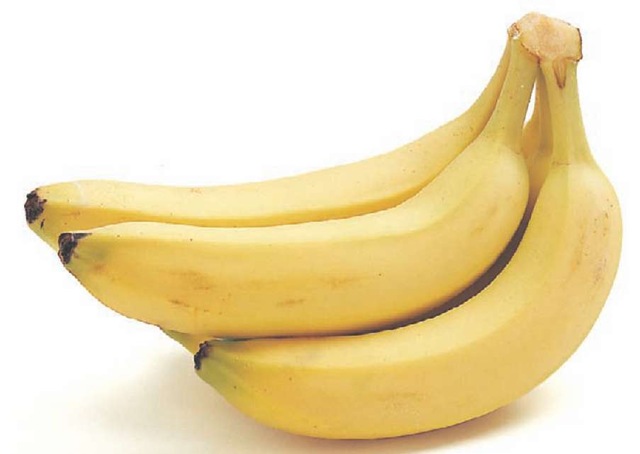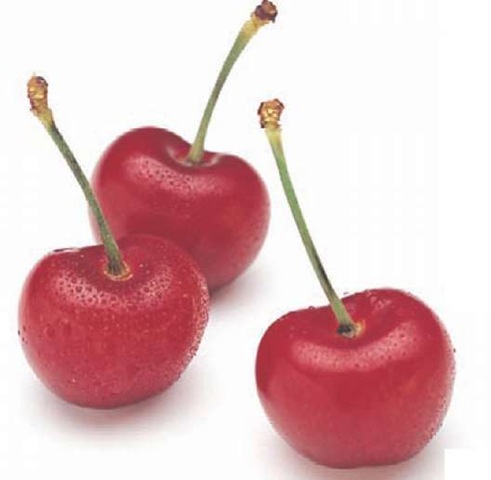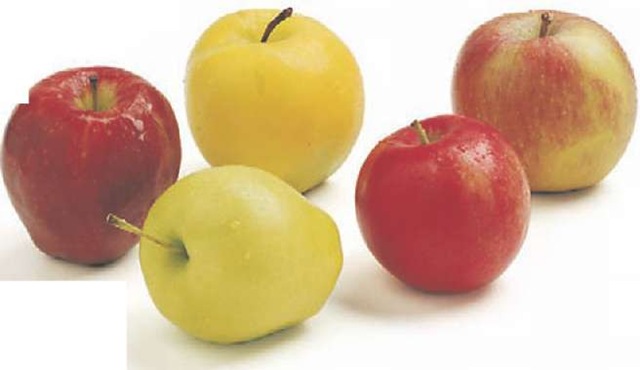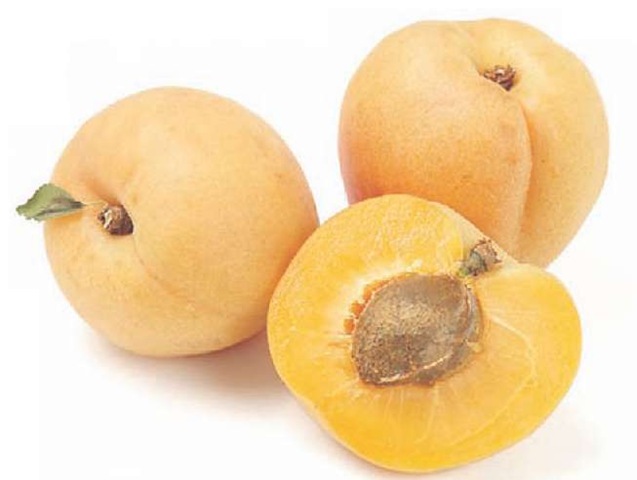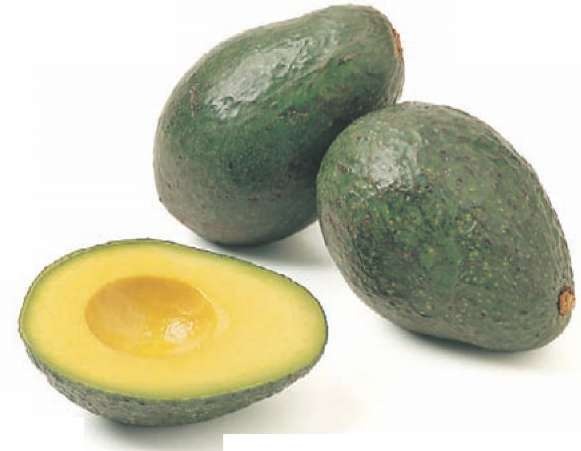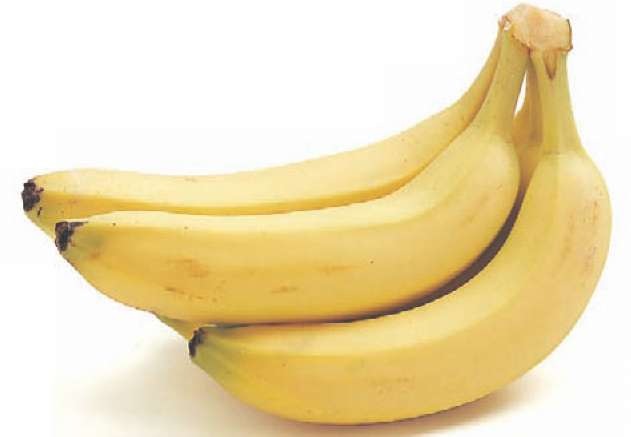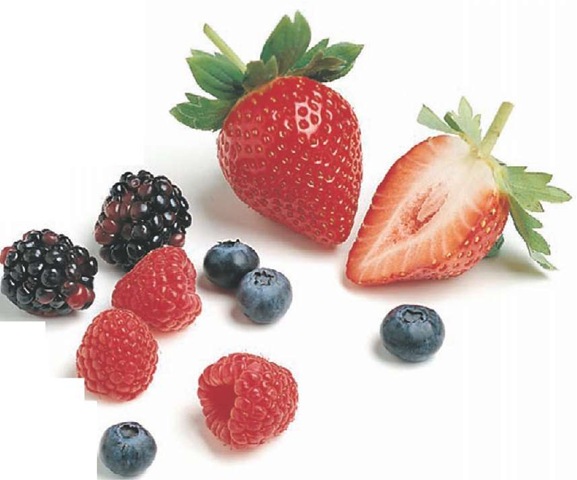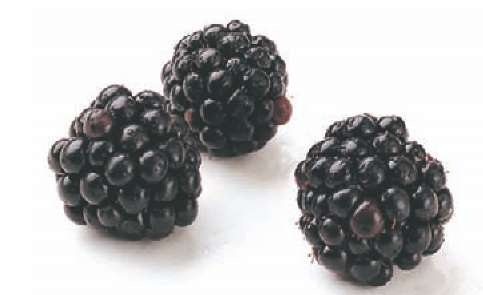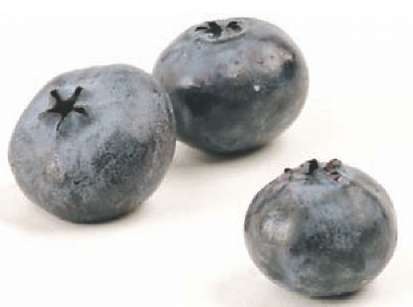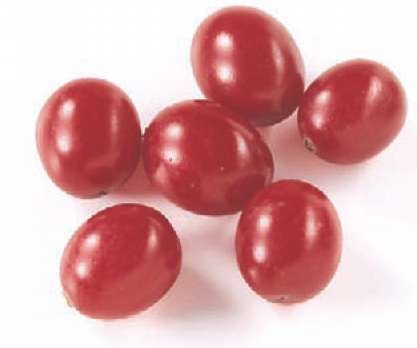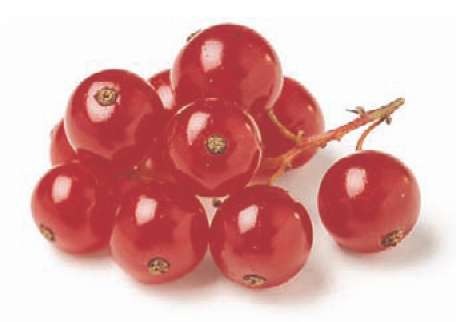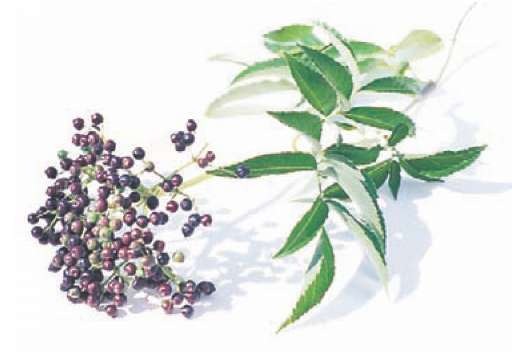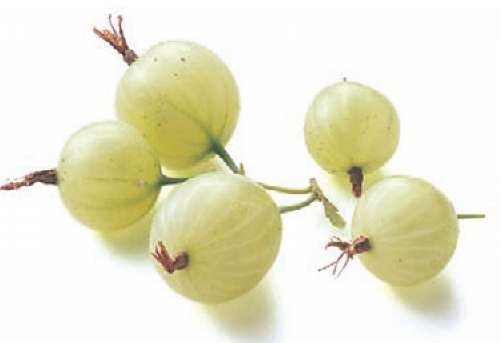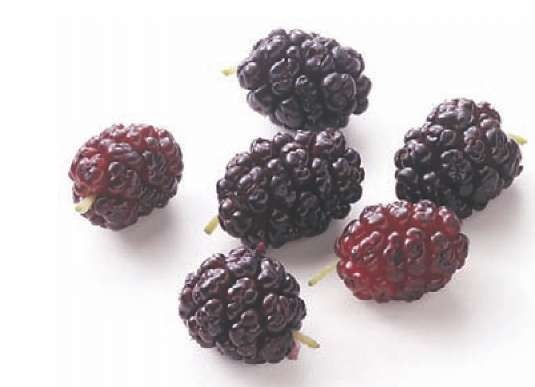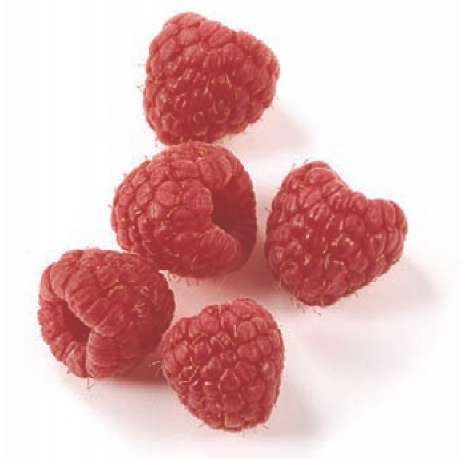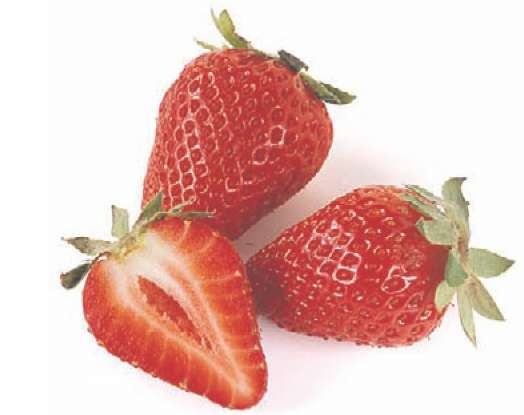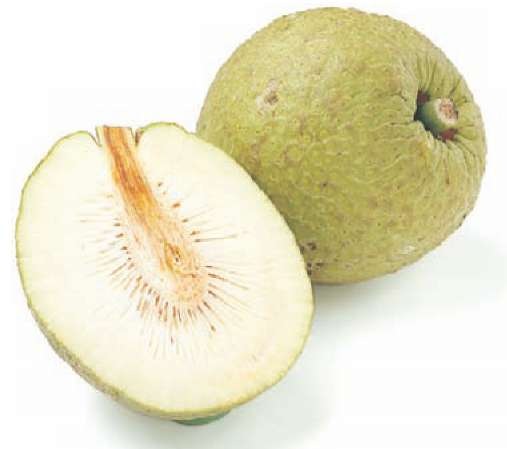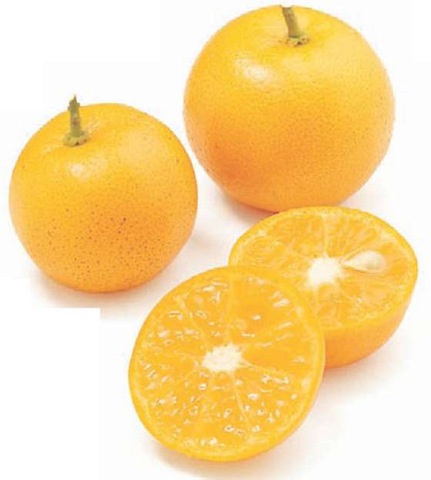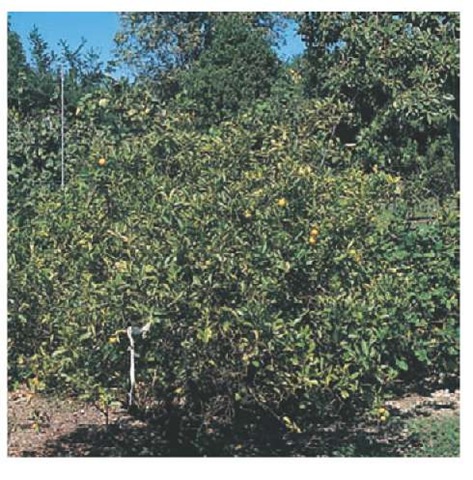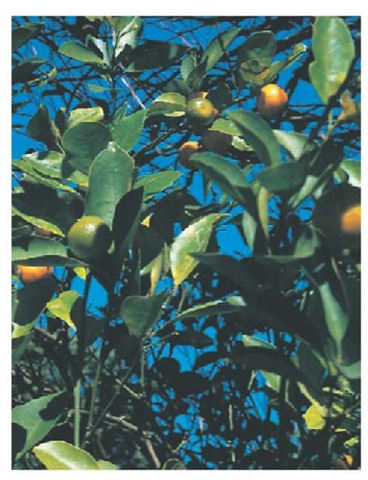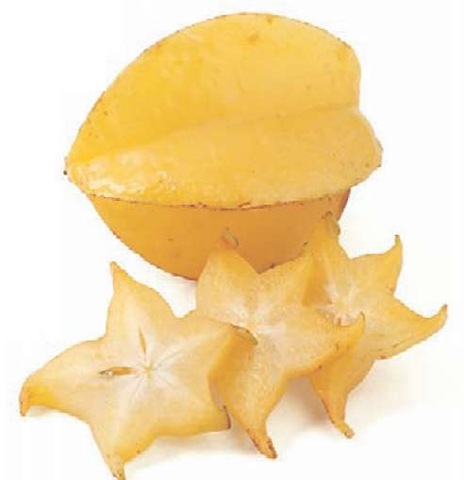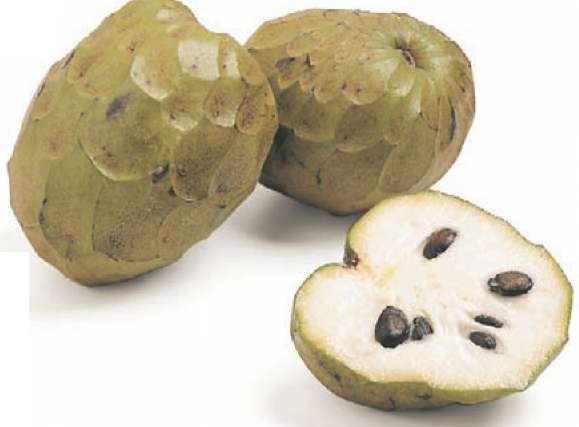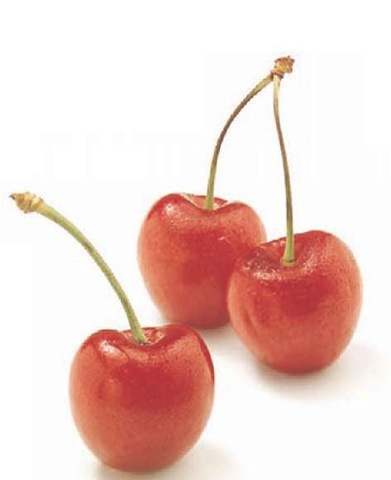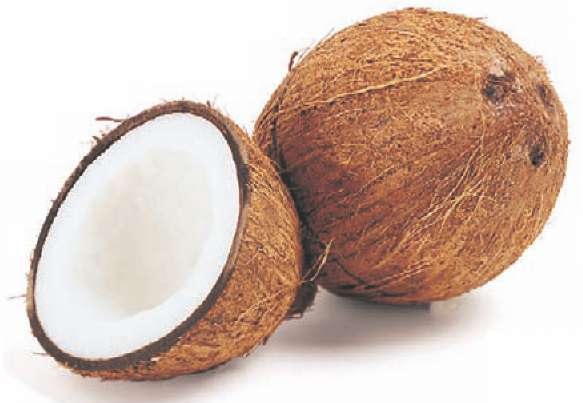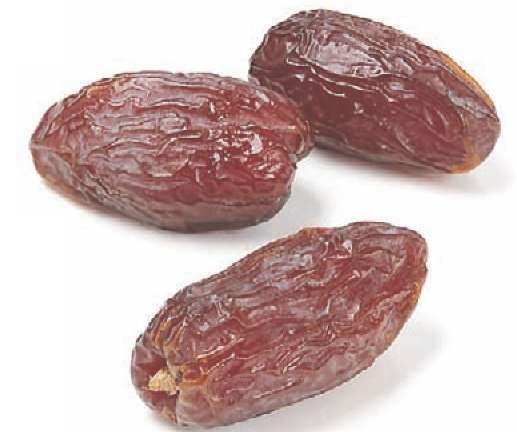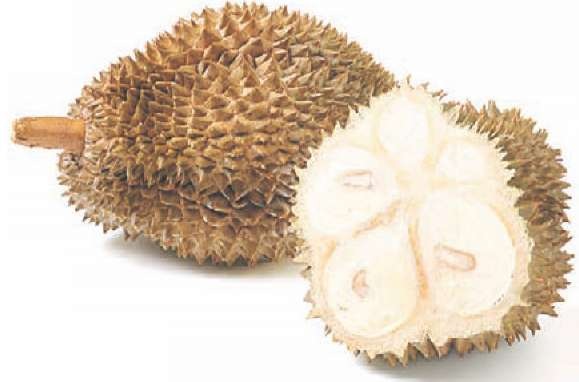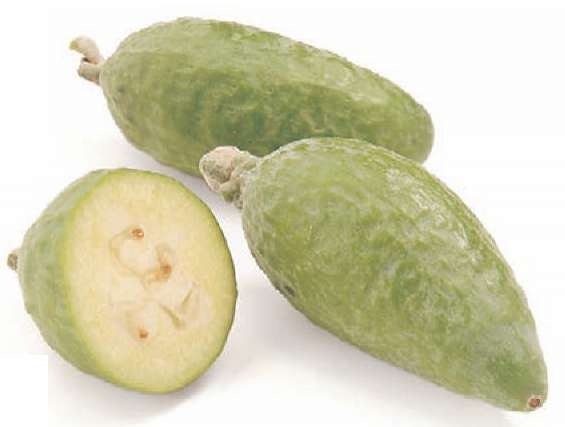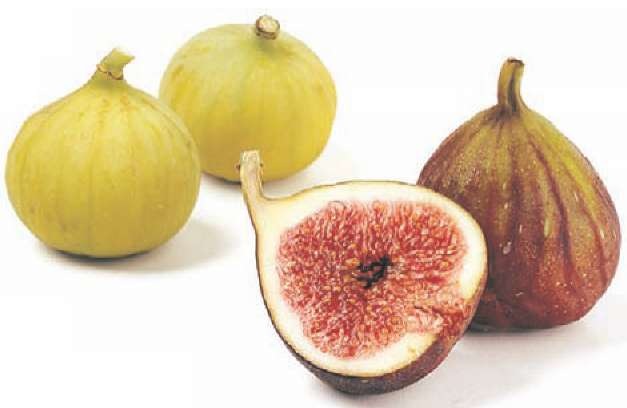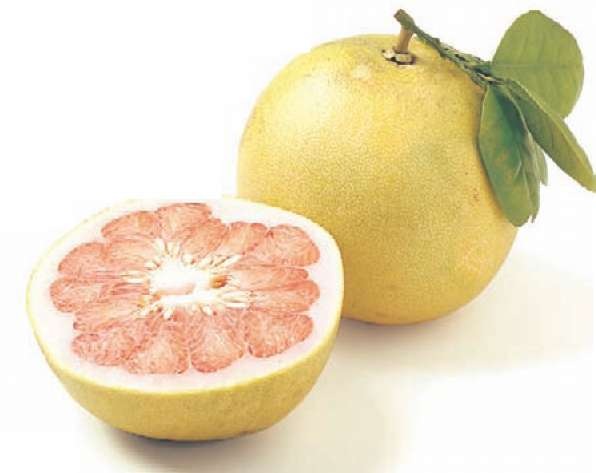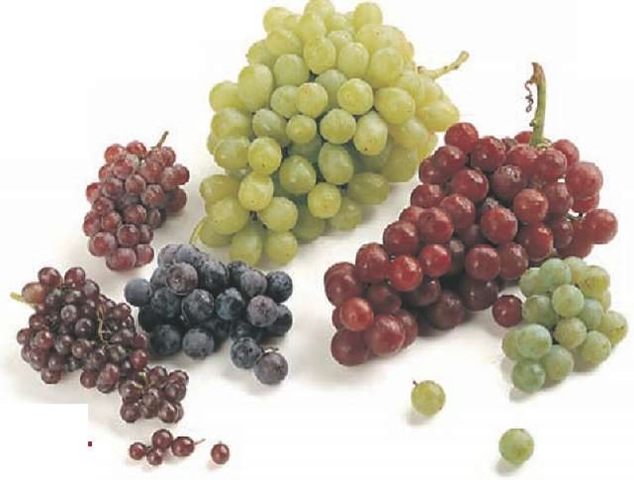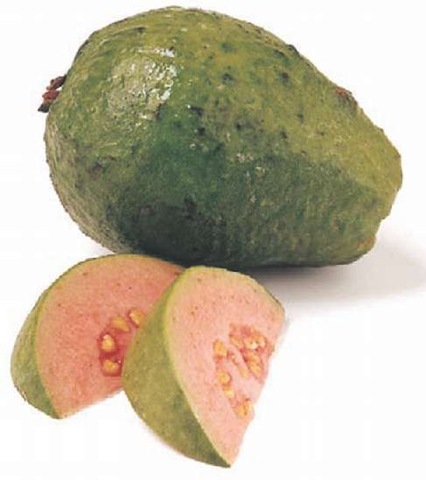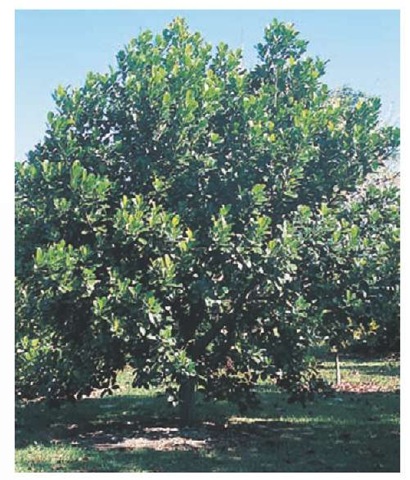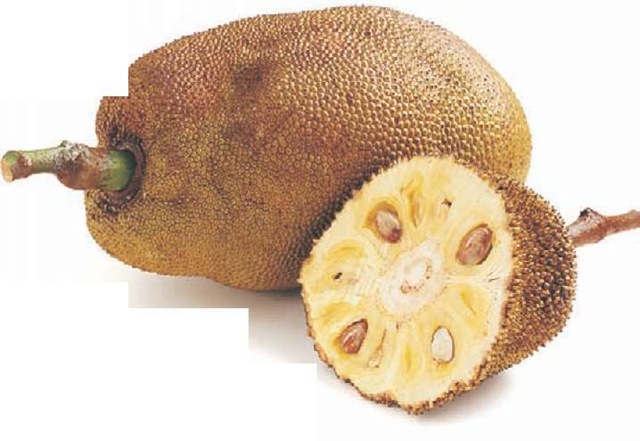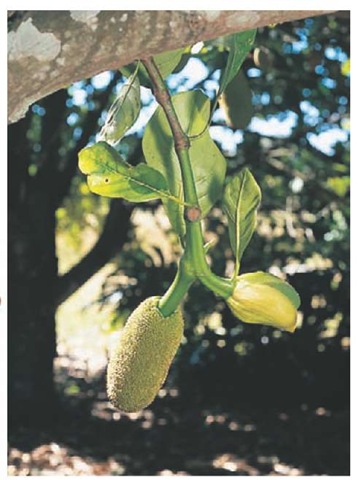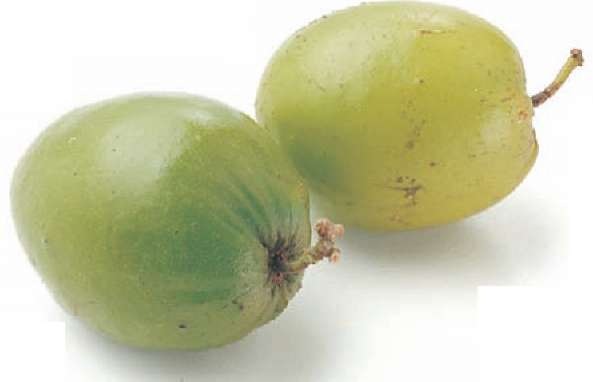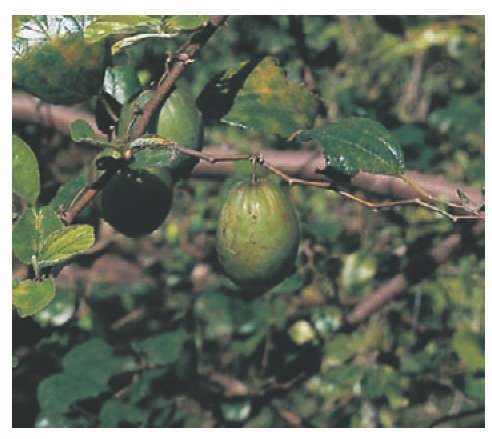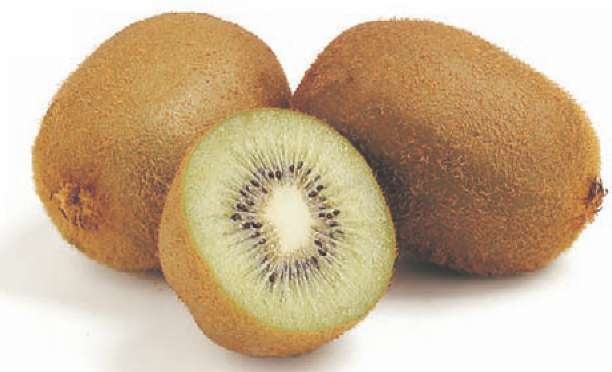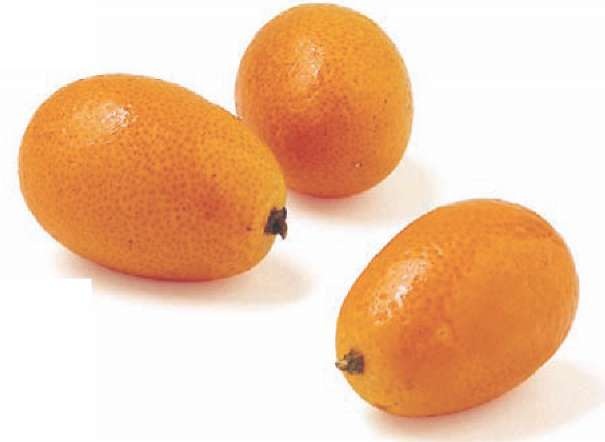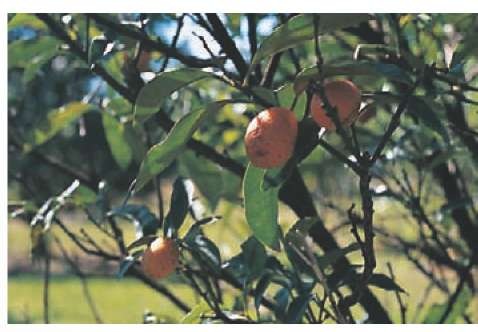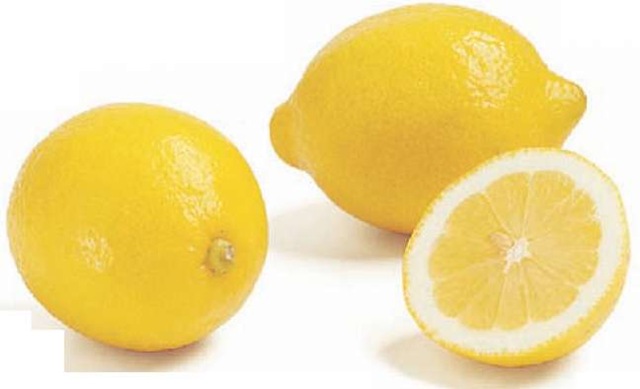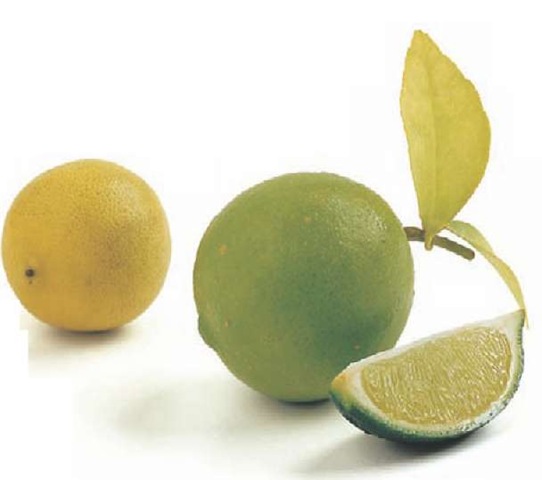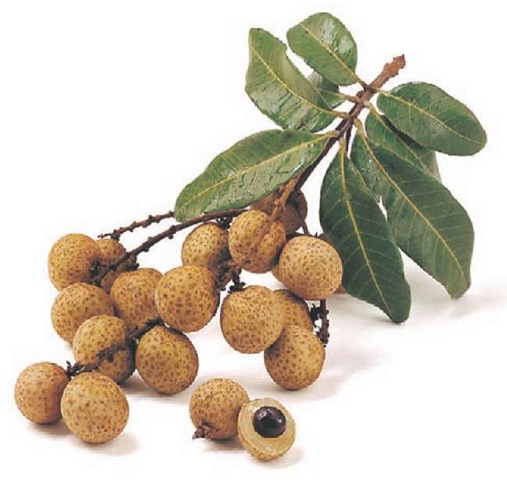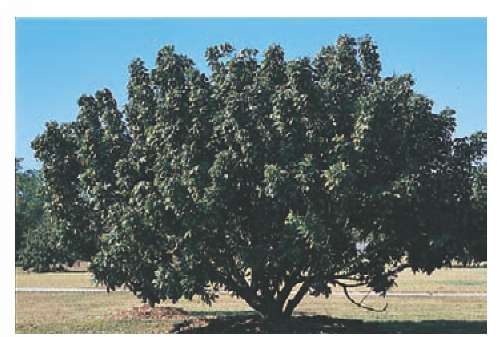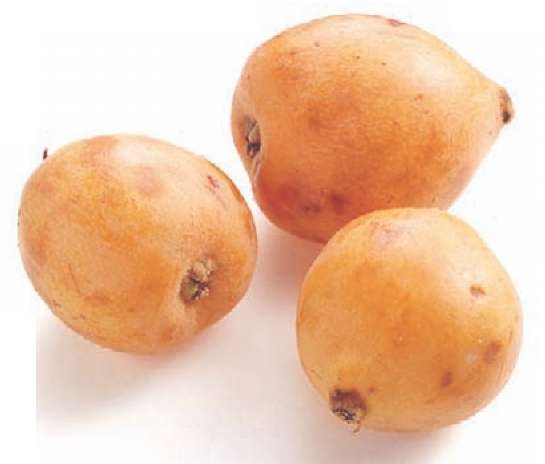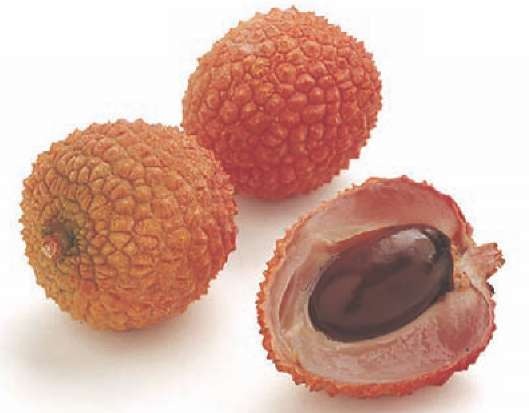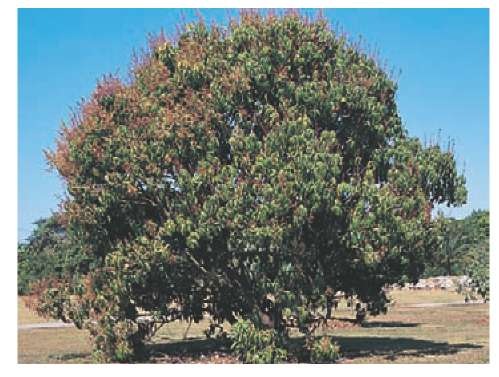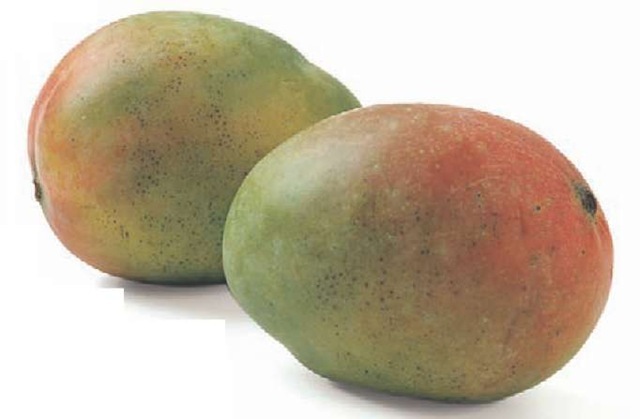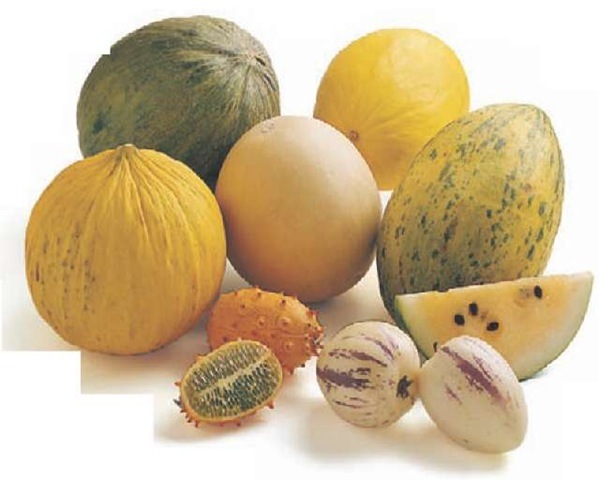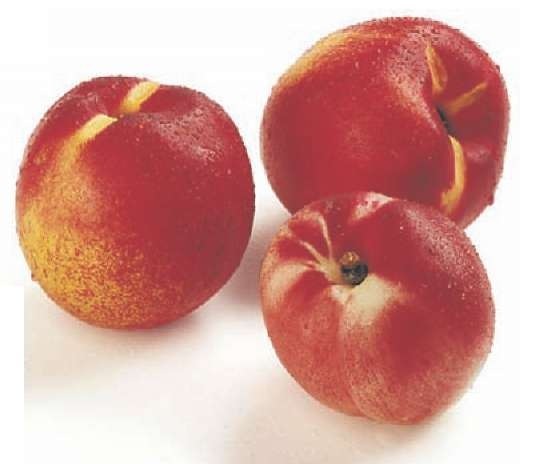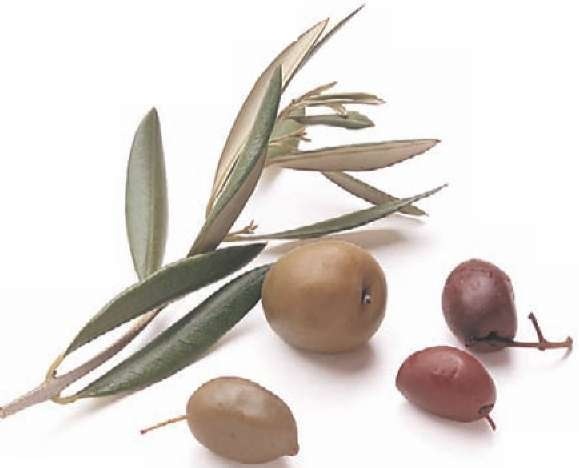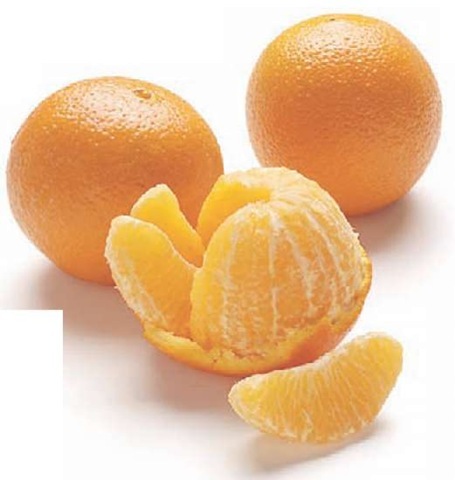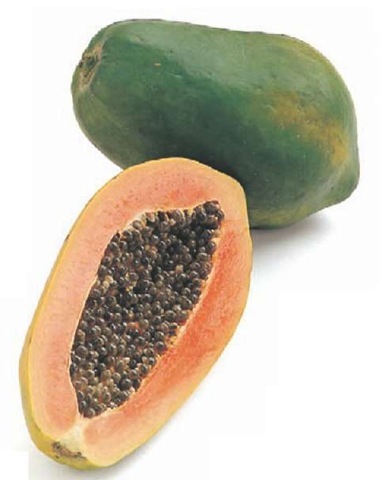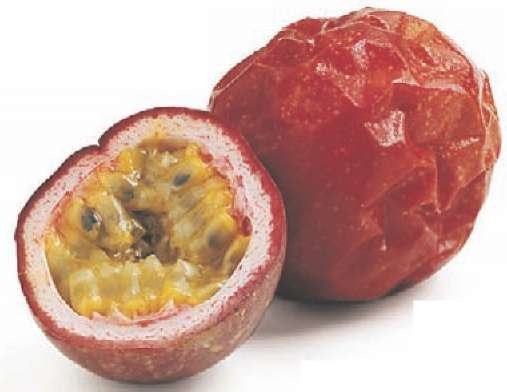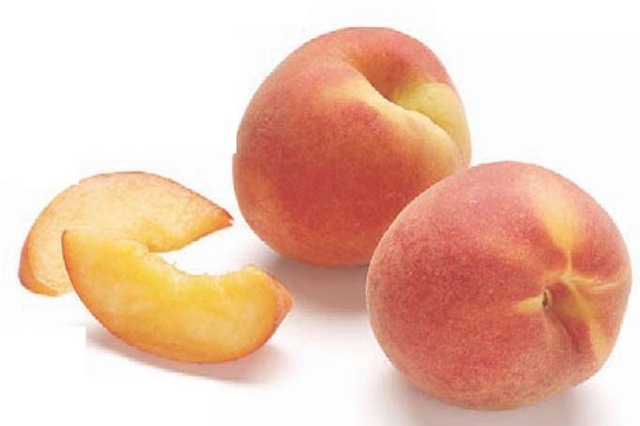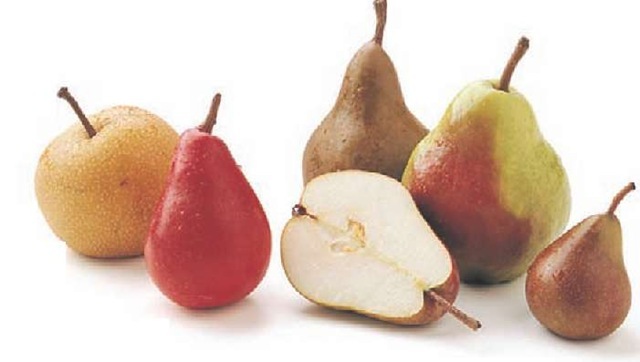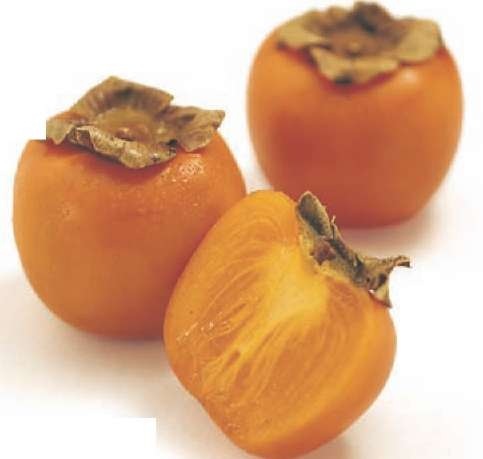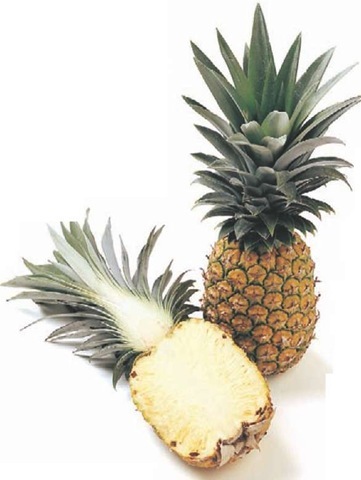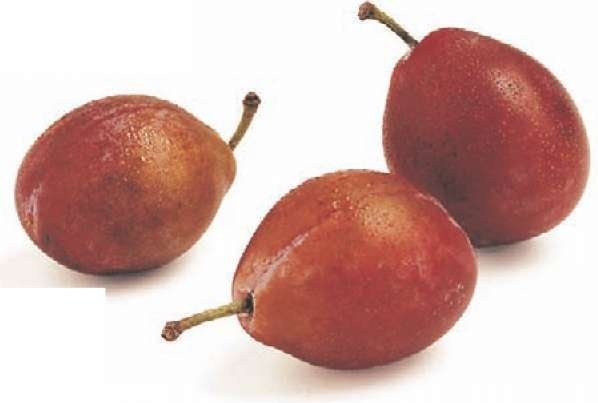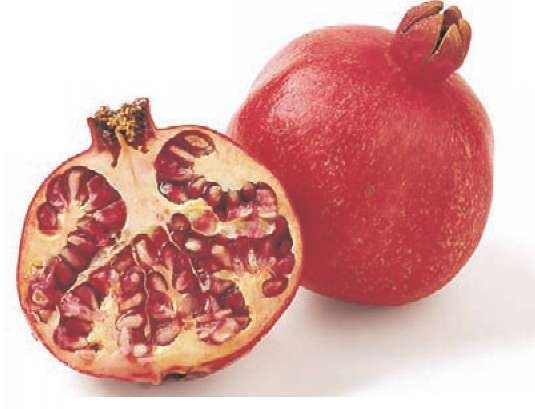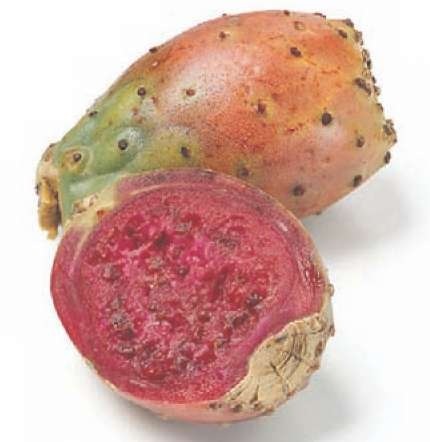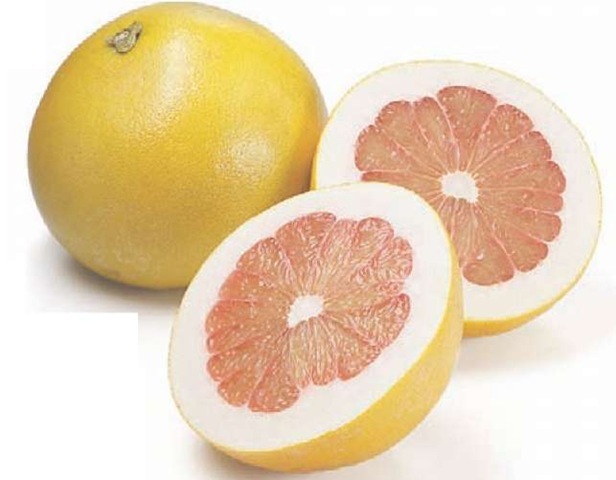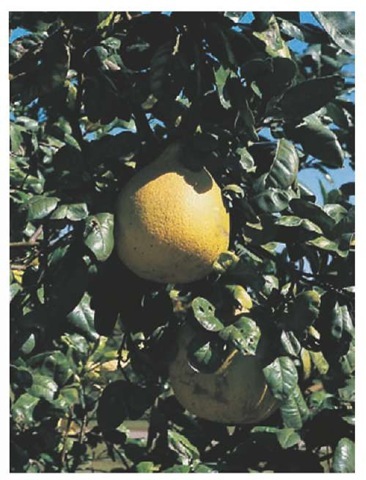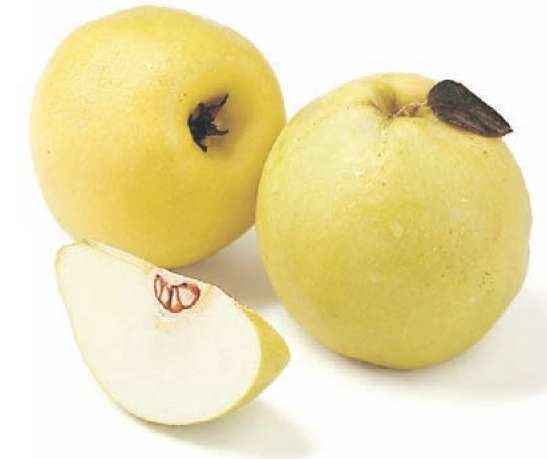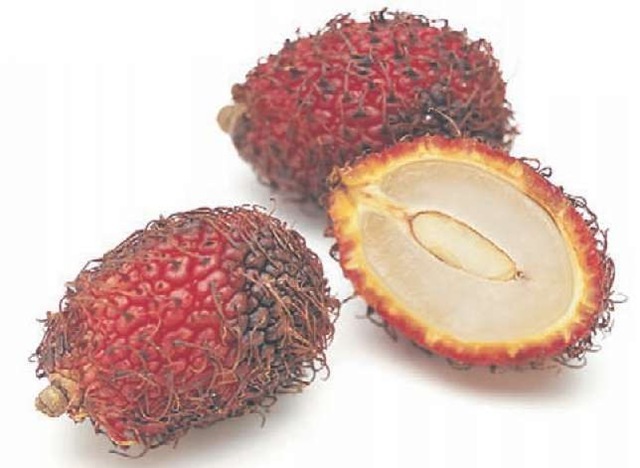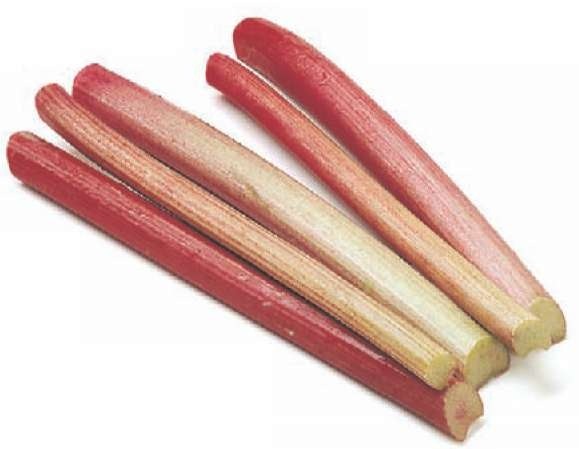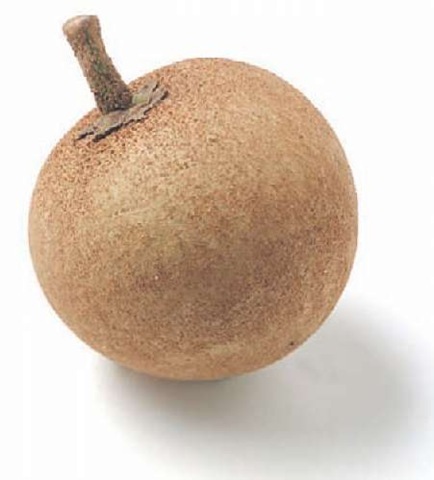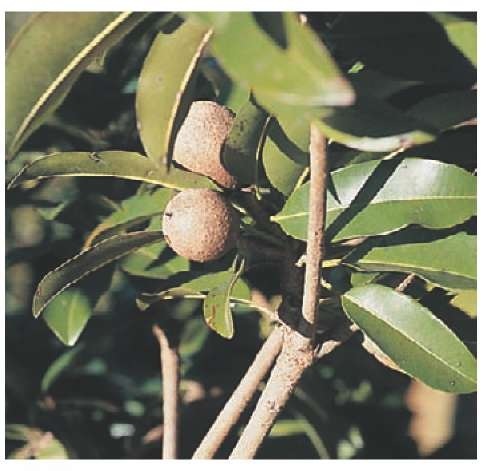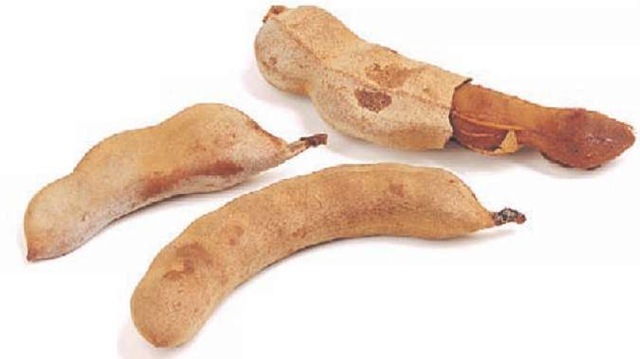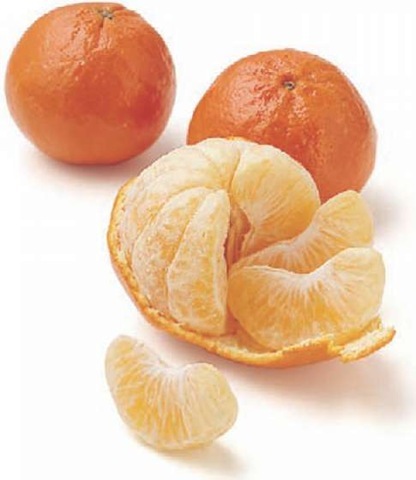Our earliest ancestors built their diets entirely of vegetables, fruits, seeds, grains, legumes, and nuts. Throughout history, "fruit" has referred to any plant used as a food. More recently, "fruit" has come to mean the edible pulp or fleshy layer around a seed. In the 18th century, the word acquired a botanical definition: the organ derived from the ovary and surrounding the seed. At the same time, culinary custom defined fruits by their sweetness (or the balance of sweet to sour) and by how they are used in the meal, primarily as dessert. Thus, even though eggplant, cucumber, squash, and tomatoes are technically fruits, we call them vegetables.
Until recently, the availability of a fruit during the year depended on its growing season. For example, strawberries appeared in April and May, melons in August and September, whereas some fruits, such as apples and bananas, were available year-round. Today, reliable transportation brings fruit of every type to our markets year-round, although some imported fruits may be more costly during the winter than their domestic counterparts are in the summer when they are in season.
The revised Dietary Guidelines for Americans includes as 1 of its 10 principles the advice to eat a variety of fruits (and vegetables) daily.
To help you to be better informed and better plan your menus, this section provides information on the origin and nutrient content of many fruits.
The tables of nutrient values in the Fruits section are based on serving sizes specified by the U.S. Department of Agriculture Food Guide Pyramid. Nutrient values are rounded (milligrams and micrograms tend to be rounded to one decimal point, grams are rounded to whole numbers). Nutrient claim statements listed beneath the common name of each fruit are based on the serving size specified. For example, 1 medium apple is considered a good source of vitamin C, because an apple provides 13 percent of the Daily Value for vitamin C. A food that is high in a particular nutrient provides 20 percent or more of the Daily Value for that nutrient per serving.
Acerola
Acerolas are round or oval, cherry-like fruits that range from 2 to 4 inches in diameter. When ripe, the skin turns bright red. The soft, juicy flesh is yellow and has a slightly tart flavor.
Nutrient composition
Acerolas contain the most concentrated source of natural vitamin C of any known fruit, 100 times the vitamin C content of oranges and 10 times that of the guava. Green (unripe) fruits have twice the vitamin C content of ripe fruits. They are also a good source of vitamin A (beta-carotene).
Family Malpighiaceae
Scientific name Malpighiapunicifolia L.,Malpighia glabra L.
Common name Barbados cherry, West Indian cherry, cereza
High in vitamin C
A good source of vitamin A (beta-carotene)
varieties
The Florida Sweet variety, commonly grown in California, yields large, juicy fruits that have a taste similar to apples. Manoa Sweet, a variety developed in Hawaii, has orange-red fruits that are especially sweet. A dwarf variety, which grows to a height of only 2 feet, can tolerate lower temperatures than the other varieties and is suited for container cultivation.
origin & botanical facts
The acerola is believed to have originated in the Yucatan peninsula of Mexico. Since its discovery, the plant has been introduced throughout the tropical and subtropical regions of the world, but it is still primarily grown in and around the West Indies.
The acerola is a large, bushy shrub that can attain a height of 15 feet. Although the plant grows best in hot tropical lowlands with medium to high rainfall, it is also very drought-tolerant. Acerolas need protection against frost and winds because their root system is shallow and they can be toppled by high winds. The leaves are covered with hair, are light to dark green, and become glossy when mature. The small, white to pink flowers bloom throughout the year. Because up to 90 percent of the blossoms fall from the plant, only a few of the flowers set fruit. When grown from seed, plants begin to fruit after 2 or 3 years. An 8-year-old tree may yield 30 to 60 pounds of fruit a year.
Uses
Because acerolas deteriorate quickly and undergo rapid fermentation once removed from the tree, they should be refrigerated if not used immediately. Unrefrigerated fruits can develop mold within 3 to 5 days. Acerolas can be eaten raw, made into jams and jellies, or pureed into juice. They have been used as a supplemental source of vitamin C, to make baby food, and as an ingredient in ice cream.
Nutrient content
|
Energy (kilocalories) |
31 |
|
Water (%) |
91 |
|
Dietary fiber (grams) |
1 |
|
Fat (grams) |
0 |
|
Carbohydrate (grams) |
8 |
|
Protein (grams) |
0 |
|
Minerals (mg) |
|
|
Calcium |
12 |
|
Iron |
0 |
|
Zinc |
0 |
|
Manganese - |
|
|
Potassium |
143 |
|
Magnesium |
18 |
|
Phosphorus |
11 |
|
Vitamins (mg) |
|
|
Vitamin A |
75 RE |
|
Vitamin C |
1,644 |
|
Thiamin |
0 |
|
Riboflavin |
0.1 |
|
Niacin |
0 |
|
Vitamin B6 |
0 |
|
Folate |
14 Mg |
|
Vitamin E |
0 |
Note: A line (-) indicates that the nutrient value is not available.
Apple
The apple is a pome, a round fruit that consists of firm, juicy flesh covered by a thin, tough, edible skin and surrounding a cartilaginous, seeded core. The skin color of apples can range from dark green to yellow to bright red, or some combination of these colors. Apples that are just ripe are crisp and juicy, whereas those that are overripe attain an aromatic flavor and a slightly mealy texture.
Family Rosaceae
Scientific name Malus pumila, Malus sylvestris, Pyrus malus
Common name apple
Good source of pectin, a soluble fiber that helps reduce blood cholesterol
A good source of vitamin C
Varieties
Thousands of varieties of apples are grown worldwide. As a result, apples are available in a seemingly endless array of colors, crispness, texture, size, sweetness, and aroma. Some of the more popular varieties in the U.S. marketplace are the Red and Golden Delicious, Granny Smith, Fuji, Gala, and Rome Beauty.
origin & botanical facts
The apple is native to Asia and eastern Europe. The earliest recorded description of apples appears in Greek literature of the 4th century B.C. The first apples cultivated in the New World were grown from seed brought by the Pilgrims. Today, the leading apple-producing nations are Russia, China, the United States, Germany, France, and Italy. In the United States, nearly half the domestic crop is grown in Washington, and New York, California, Michigan, Pennsylvania, North Carolina, and Virginia produce for much of the rest of the domestic market.
Apples can grow virtually anywhere with a moderate climate, although some varieties are better suited to a particular region. Because fruit-bearing seasons vary by variety and region, apples are available all year. Standard-sized trees reach a height and spread of 25 feet and require 5 to 10 years to fruit. Recently, dwarf and semidwarf trees have emerged; these require as few as 2 years to bear fruit.
Uses
When selecting apples, choose those with firm flesh and tight skin that is free of bruises, soft spots, and holes. Larger apples tend to be more mealy than small ones. To ripen apples, keep them at room temperature. Apples store well for long periods refrigerated or in a cool, dry place. Sliced apples quickly turn brown on exposure to air; however, this can be prevented by dipping the fruit into acidulated water (dilute lemon juice).
As one of the most popular fruits in the United States, apples are widespread in the American cuisine. They are used in salads, alongside meats, and in pilafs, desserts, preserves, juices, cider, pies, breads, cakes, and alcoholic beverages (such as the liqueur calvados). Dried apples make tasty snacks or additions tobreakfast cereal. Characteristics of flavor and texture determine the optimal varieties for each use. Crisp, crunchy, juicy, sweet or sweet-tart apples such as the Granny Smith, Fuji, Gala, or Red Delicious are best for eating. In general, firm-fleshed, tart apples such as the Golden Delicious and Rome Beauty are best for baking whole. Tart or slightly sour varieties are good for pies and applesauce.
Nutrient composition
A medium-sized fresh apple is a good source of vitamin C; however, most of the vitamin C is lost when the apple is cooked or made into juice.
Apples are a good source of dietary fiber in the form of pectin.
Nutrient content
|
Energy (kilocalories) |
81 |
|
Water (%) |
84 |
|
Dietary fiber (grams) |
4 |
|
Fat (grams) |
0 |
|
Carbohydrate (grams) |
21 |
|
Protein (grams) |
0 |
|
Minerals (mg) |
|
|
Calcium |
10 |
|
Iron |
0 |
|
Zinc |
0 |
|
Manganese |
0 |
|
Potassium |
159 |
|
Magnesium |
7 |
|
Phosphorus |
10 |
|
Vitamins (mg) |
|
|
Vitamin A |
7 RE |
|
Vitamin C |
8 |
|
Thiamin |
0 |
|
Riboflavin |
0.1 |
|
Niacin |
0 |
|
Vitamin B6 |
0.1 |
|
Folate |
4 Mg |
|
Vitamin E |
0 |
Apricot
The apricot is a round, fleshy fruit that is closely related to the peach, plum, almond, and cherry. It has a single seed enclosed in a stony shell. The edible, pale-orange skin is smooth and velvety. The flesh is drier than that of most other fruits.
Family Rosaceae
Scientific name Prunus armeniaca
Common name apricot
Good source of vitamin C
High in vitamin A (beta-carotene)
Family Rosaceae
Scientific name Prunus armeniaca
Common name apricot
Good source of vitamin C
High in vitamin A (beta-carotene)
Varieties
Approximately 12 varieties of apricots exist, with flesh that varies from yellow to deep orange. Some of the better known varieties are the Blenheim, the Tilton, the Patterson, and the Castlebrite.
origin & botanical facts
The world’s leading producers of apricots are Turkey, Italy, Russia, and Greece. Ninety percent of the U.S. domestic market is supplied by growers in California; Utah and Washington supply the rest. During the off-season, apricots are imported from Chile and New Zealand. Apricot trees grow to about 20 feet in height and spread to a width of 30 feet. The white or pink flowers appear in early spring and give way to fruits in late summer. Because of this early flowering, apricot yield may be limited by late frosts that kill the flowers. The domestic crop is available from mid-May to mid-August, and imports arrive in December and January.
Uses
Apricots are best when purchased ripe or slightly underripe and allowed to ripen in a paper bag. Green-tinged fruits will not ripen properly and should be avoided. Ripe apricots can be stored in the refrigerator up to a week, but apricots that are soft and juicy should be eaten within a day or two of purchase. Apricots should be washed just before they are eaten. They are excellent eaten out of hand or used in any recipe that calls for peaches or nectarines. Apricots should not be cooked for an extended time because they tend to lose their flavor rather quickly; poaching is an ideal cooking method. Dried apricots are a convenient, nonper-ishable snack.
Nutrient composition
Fresh apricots are high in vitamin A (beta-carotene) and are a good source of vitamin C.
Nutrient content
|
Energy (kilocalories) |
34 |
|
Water (%) |
86 |
|
Dietary fiber (grams) |
2 |
|
Fat (grams) |
0 |
|
Carbohydrate (grams) |
8 |
|
Protein (grams) |
1 |
|
Minerals (mg) |
|
|
Calcium |
10 |
|
Iron |
0 |
|
Zinc |
0 |
|
Manganese |
0 |
|
Potassium |
207 |
|
Magnesium |
6 |
|
Phosphorus |
13 |
|
Vitamins (mg) |
|
|
Vitamin A |
183 RE |
|
Vitamin C |
7 |
|
Thiamin |
0 |
|
Riboflavin |
0 |
|
Niacin |
0 |
|
Vitamin B6 |
0 |
|
Folate |
6 Mg |
|
Vitamin E |
1 |
AYQCADQ
The avocado is a pear-shaped fruit with skin that can be thick or thin, green or purplish black, and smooth or bumpy, depending on the variety. The flesh of the avocado is pale yellow-green and has the consistency of firm butter and a faint nut-like flavor.
Family Lauraceae
Scientific name Persea americana
Common name avocado, alligator pear
Rich source of monounsaturated fat
Good source of fiber
Family Lauraceae
Scientific name Persea americana
Common name avocado, alligator pear
Rich source of monounsaturated fat
Good source of fiber
Varieties
The two most commonly sold varieties of avocados in the United States are the Hass and Fuerte, both grown in California. The Guatemalan Hass avocado, the most popular variety, has a thick, pebble-textured and purplish skin and usually weighs no more than 12 ounces. The Fuerte avocado, a Guatemalan-Mexican hybrid, has a more pronounced pear shape and is slightly larger than the Hass. It has a shiny, thin, dark-green skin with small, raised, pale spots. Florida-grown varieties, which are Mexican in origin and include the Booth, Waldin, and Lula, are larger, less costly, and more perishable than California avocados. In addition, they contain less fat and fewer calories and lack the rich, creamy flavor of the California varieties.
origin & botanical facts
The avocado, native to the tropics and sub-tropics of Central America, was first cultivated in the United States in the mid-1800s in Florida and California. Ninety percent of today’s domestic crop of avocados is grown in California. With a harvest of 168,000 tons, the United States is the second-largest grower of avocados in the world, behind Mexico at 718,000 tons.
The avocado tree, a popular shade tree in rural and suburban Hawaii, California, and Florida, is a dense evergreen that may reach a height of 80 feet.
Avocados do not ripen on the tree; ripening is inhibited by hormones produced by the leaves. This delay in ripening is a commercial advantage because the fruit may be left unharvested for long periods (up to 7 months). However, overripe avocados may seed internally and become moldy.
Uses
Avocados that are unblemished and heavy for their size are best. Ripe avocados yield slightly to finger pressure, but if the finger leaves a dent, the avocado may be overripe. Ripening can be hastened by enclosing the fruit in a paper bag and leaving at room temperature. Ripe avocados should be refrigerated and used within 1 to 2 days.
Because cooking destroys the flavor of avocados, it is not recommended. Fresh avocados can be sliced and added to cooked dishes just before serving. They can be diced and mixed into salads, mashed to use in toppings or dips, pureed to use in cold soups and desserts, orjulienned to include in sushi rolls. When exposed to air, avocado flesh discolors quickly. Addition of lemon or lime juice to mashed or pureed avocados can delay discoloration. Placing an avocado pit in a bowl of mashed avocados will not prevent discoloration.
Nutrient composition
Avocados are known for their high fat content; however, most is monounsaturated fat. They are low in saturated fat and are sodium- and cholesterol-free. Avocados are a good source of dietary fiber. They also contain lutein, one of the carotenes that is a phytochemical with antioxidant properties.
Nutrient content
|
Energy (kilocalories) |
324 |
|
Water (%) |
74 |
|
Dietary fiber (grams) |
10 |
|
Fat (grams) |
31 |
|
Carbohydrate (grams) |
15 |
|
Protein (grams) |
4 |
|
Minerals (mg) |
|
|
Calcium |
22 |
|
Iron |
2 |
|
Zinc |
1 |
|
Manganese - |
|
|
Potassium |
1,204 |
|
Magnesium |
78 |
|
Phosphorus |
82 |
|
Vitamins (mg) |
|
|
Vitamin A |
123 RE |
|
Vitamin C |
16 |
|
Thiamin |
0.2 |
|
Riboflavin |
0.2 |
|
Niacin |
3.8 |
|
Vitamin B6 |
0.5 |
|
Folate |
124 Mg |
|
Vitamin E |
3 |
Note: A line (-) indicates that the nutrient value is not available.
Banana
The banana is an elongated, curved, tropical fruit with a smooth outer skin that peels off easily when the fruit is ripe. Bananas are harvested while still green but may be ripened under controlled conditions before being delivered to the grocery store. Yellow bananas are fully ripe when the skin has small flecks of brown. The flesh of the ripe banana has a distinct creamy texture and sweet fragrance.
Family Musaceae
Scientific name Musa paradisiaca L.
Common name banana, plantain
High in vitamin B6
A good source of vitamin C potassium, and fiber
Varieties
The familiar yellow banana sold in the United States is the Cavendish variety, which is 5 to 10 inches in length and available all year. Red bananas from Latin America are slightly wider and are heavier and sweeter than yellow bananas. Their red skin turns purple when ripe. Manzano bananas (also called finger or apple bananas) are short and chubby with a mild, strawberry-apple flavor. They turn fully black when ripe. Plantains (also called green or cooking bananas), thick-skinned bananas that range from green to yellow to brown-black, are a staple food in many parts of the world. When unripe plantains are cooked, they have no banana flavor; however, when cooked ripe, they have a sweet banana taste and a slightly chewy texture.
Origin & botanical facts
Originating in the Malaysian region about 4,000 years ago, the banana was not introduced to the Americas until the Philadelphia Centennial Exhibition of1876. Today, the banana is the leading fresh fruit sold in the United States and the second leading fruit crop in the world. The United States grows about 4,000 tons of bananas annually and imports a total of1.6 million tons annually from South America. Worldwide, India is the largest banana grower, followed by Africa, where bananas are mostly kept for local use.
A banana tree is technically not a tree, but rather a tree-like herb that belongs to the grass family. It can attain a height of 10 to 40 feet when fully grown. The banana is actually a berry that has been cultivated to have no seeds. The non-woody banana stalk develops a flowering stem and seven to nine buds that each sustain one cluster (hand) of 10 to 20 bananas (fingers). The stalks are cut after producing the fruit, and new stems grow from buds in the rootstock.
Uses
Ripening of green bananas can be hastened by putting the fruit into a paper bag. Ripe bananas can be stored in the refrigerator for up to 2 weeks; although the skin turns dark brown, the fruit remains edible. Unripe bananas should not be refrigerated. Bananas become sweeter as they ripen (as most of the starch converts to sugar) and are most often consumed raw or in desserts such as puddings, pies, and sweet breads. Banana slices should be dipped into acidulated water (dilute lemon juice) to prevent browning. Pureed banana can be added to pancake batter. Because they are rich in tannins, plantains are bitter and must be cooked to be palatable.
Nutrient composition
Bananas are high in vitamin B6 and are a good source of vitamin C, potassium, and fiber. Red bananas and plantains are good sources of vitamin A.
Nutrient content
|
Energy (kilocalories) |
109 |
|
Water (%) |
74 |
|
Dietary fiber (grams) |
3 |
|
Fat (grams) |
1 |
|
Carbohydrate (grams) |
28 |
|
Protein (grams) |
1 |
|
Minerals (mg) |
|
|
Calcium |
7 |
|
Iron |
0 |
|
Zinc |
0 |
|
Manganese |
0 |
|
Potassium |
467 |
|
Magnesium |
34 |
|
Phosphorus |
24 |
|
Vitamins (mg) |
|
|
Vitamin A |
9 RE |
|
Vitamin C |
11 |
|
Thiamin |
0.1 |
|
Riboflavin |
0.1 |
|
Niacin |
1 |
|
Vitamin B6 |
0.7 |
|
Folate |
23 Mg |
|
Vitamin E |
0 |
Berries
Berry is a general term for fruits that are usually small, rounded, and pulpy with seeds embedded in a juicy flesh. The term is loosely applied to a range of fruits belonging to vastly diverse botanical families. Aside from the more popular berries such as the blackberry, blueberry, cranberry, currant, raspberry, and strawberry, there are a host of less common species, each with its own distinctive shape, color, fragrance, and taste. Berries were a staple in the diets of our hunting-and-gathering ancestors and still play an important role in the culinary traditions of many peoples around the world. American Indians used various types of berries as food, medicine, dyes, and food preservatives. Early American settlers developed a taste for the many varieties growing wild in woods and fields of North America, and they learned to use the berries for food and medicine. Research has shown that several berries have medicinal properties. (Cranberries and blueberries help prevent urinary tract infections.) Most berries contain generous amounts of vitamin C, and some are a good source of fiber because of the skin and seeds.
Blackberry
Family Rosaceae
Scientific name Rubusfructicosus (European), Rubus villosus (American)
Common name blackberry, bramble berry, dewberry, goutberry
Also called bramble berries because they grow on thorny bushes (brambles), blackberries range from one-half to an inch long when mature and are purplish black. Like raspberries, to which they are related, blackberries are oblong and are made up of small edible seeds that are encased in juicy globules adjoining a fleshy base.
The most common varieties of blackberry are the Cherokee (a sweet variety) and the Marion (a tart variety). Boysenberries, loganberries, ollalaberries, sylvanberries, and tayberries are hybrids of blackberries and raspberries.
Blackberries are found throughout the temperate zones of the world, growing wild in meadows and at the edge of forests. The bushes flower in spring and bear fruit throughout the summer. Borne in loose clusters on stems that grow from the canes, the berries change from green to red and then to purplish black as they ripen. Blackberry bushes are so vigorously invasive that they are considered a weed in some areas.
Plump, deeply colored blackberries are the most delicious to eat, and immature red berries are tart. Blackberries are best used immediately, because they spoil quickly. They can be lightly covered and refrigerated for 1 to 2 days. Blackberries can be eaten fresh; used as a topping for yogurt, ice cream, and pancakes; tossed into a fruit salad; pureed to make a dessert sauce; or made into blackberry pie. About 98 percent of commercially produced berries are processed into jams, fillings, juices, wines, and brandies.
Blackberries are high in vitamin C, are a good source of dietary fiber, and contain ellagic acid, a phytochemical that may help prevent cancer.
Blueberry
Family Ericaceae
Scientific name Vaccinium myrtillis
Common name blueberry
Blueberries, a species native to North America, grow in shades varying from light blue to dark purple. Round to oval, the berries have a smooth skin that is somewhat waxy and covered with a powdery silver film Berriesor "bloom." Blueberries were once called star berries because of the star-shaped calyx on the top of each fruit. Cultivated blueberries can be as large as 3/4 inch in diameter, although the "wild" varieties are only 1/4 to 1/2 inch in diameter.
At least 50 species of blueberries, both cultivated and wild, have been identified. The two types of cultivated blueberries are highbrush and rabbiteye. Highbrush blueberries, V corymbosum L., are grown throughout North America, whereas the rabbiteye varieties, V ashei Reade, are better adapted to southern regions of the United States. Lowbush (wild) blueberries, V. angustifolium Ait., grow naturally in Maine, Nova Scotia, and Quebec. These plants produce blueberries that are prized for their intense flavor. The lowbush (wild) blueberry varieties grow to about 3 feet in height, whereas the highbush and rabbiteye cultivars can grow to more than 10 feet if not pruned. The desirable flavor, color, and texture of today’s cultivars are the result of nearly 100 years of hybridization.
Blueberries have been used as a source of food and folk medicine for thousands of years. Early explorers of North America, such as Lewis and Clark, noted that American Indians smoked the berries to preserve them for winter and pounded the berries with beefto make a jerky called pem-mican. Blueberries were also appreciated by the early American settlers as both a food and a medicine.
The blueberry plant is a compact, woody shrub that is related to the bilberry, cranberry, and huckleberry. Blueberries grow in clusters, but because the berries ripen at different times, they must be handpicked to harvest the best of the early fruit. Later, a harvesting machine is used to gently shake each bush so that only the ripe berries fall off. The blueberry season lasts only from mid-April to late September, beginning in the southern states and moving north as the seasonprogresses. The berries are very perishable and easily damaged by improper handling and extreme temperatures.
Blueberries are one of the most popular berries in the United States, second only to strawberries. They can be eaten dried or fresh as a snack food; added to cereals, salads, yogurt, or ice cream; used as an ingredient in pancakes, muffins, pies, breads, or sauces or as cake topping; or pureed to make jam or jelly. Although the blueberry season is short, berries can be bought in the off-season in frozen, canned, or dried form.
Blueberries are a good source of vitamin C.
Recent research has shown that blueberries may help prevent urinary tract infection by increasing the acidity of urine, which helps destroy bacteria, and by preventing bacteria from colonizing on the bladder walls.
Cranberry
Family Ericaceae
Scientific name Vaccinium macrocarpon,Vaccinium oxycoccus
Common name cranberry, bounceberry, lingonberry
Cranberries, which are native to North America, are small, smooth-skinned, round berries that are glossy deep red to red-maroon. About one-third of an inch in diameter and half-inch to an inch long, the cranberry has seeds that are attached to the center of the fruit and are surrounded by a tart white pulp. Also called bounceberries, because they bounce when ripe, cranberries belong to the same family as blueberries and huckleberries; but unlike these fruits, cranberries are too tart to eat raw.
Cranberries are divided into three types. The most common is the large Vaccinium macrocarpon, grown for commercial purposes. Vaccinium oxycoccus, commonly called the mossberry or small cranberry, is found wild in some areas. Vaccinium vitis-idaea, or the lingonberry, grows well in very cold climates and is currently being developed as a crop in several eastern European countries.
Cranberries grow on a flat, woody, evergreen "vine" that thrives in acidic soil. Cranberry vines are planted in peat bogs prepared in a way that allows the plants to be covered with water to protect them from cold damage. The pink or purple cranberry flowers can be self-pollinated, but crop yield is much greater when bees are used to facilitate pollination. The berries are borne on short uprights 6 to 8 inches in length that rise from a dense mass of stems on the soil surface.
Cranberries are extensively cultivated for commercial use in the northern states. Massachusetts is the largest producer, followed by Wisconsin, New Jersey, Washington, and Oregon. Cranberry cultivation is also common throughout Canada. Harvested between Labor Day and Halloween, cranberries enjoy their peak market season from October through December.
The Pilgrims dined on cranberry dishes at the first Thanksgiving in 1621. Once only a traditional holiday food, cranberries are now consumed throughout the year as juice drinks, dried snacks, sauces, and relishes. Because of their sour taste, they must be combined with sweet foods such as sugar or orange juice to make them palatable. Only about 10 percent of the commercial crop is sold fresh; the rest is processed into juice or canned cranberry sauce.
Cranberry juice cocktail is considered effective for preventing or treating urinary tract infections, in part because of its high acidity and its ability to inhibit bacteria from adhering to the lining of the urinary tract.
Fresh cranberries are a good source of vitamin C. In addition, they contain bioflavonoids, plant pigments with antioxi-dant properties.
Currant_
Family Saxifragaceae
Scientific name Ribes rubrum, Ribes vulgare, Ribespetraeum, Ribes sativum, Ribes nigrum, Ribes ussuriense
Common name currant (red, pink, white, black, and Asian)
Currants are small, spherical berries with thin, translucent skin that can be red, pink, white, or black. They have a soft, juicy pulp that contains several edible seeds. The flavor of currants varies from slightly to exceedingly tart. True currants are not to be confused with the zante currant, a variety of small, dried grape (raisin).
Currants are categorized by their color. Common red currants include the Red Lake, a mild-flavored, bright-red berry, and the Perfection, a medium to large, flavorful variety. The White Imperial, a small, round, white berry that grows on a spreading bush, has the lowest acid content of any currant. The most common pink currant is the Gloire des Sablons, an ancient French variety with pink flesh and colorless skin. The Boskoop is a well-flavored black currant, produced on a vigorous, upright bush. The Willoughby is a mild, black Canadian currant that is hardy to cold and sun and resists mildew.
Currants appear to have originated in northern Europe, northern Africa, Siberia, and in the Western Hemisphere, where they were eaten by American Indians well before their first contact with Europeans. American Indians historically have used currants for both food and medicinal purposes. The Coast Salish Indians of Vancouver Island boiled the fruit and dried it into rectangular cakes for use as a winter food. The Woodlands Cree Indians used currant jam as a condiment for fish, meat, and bread. Before 1550, the English called this fruit ribes, a name of ancient Indo-European origin. Subsequently, the berries came to be called currants, a word derived from the berry’s resemblance to the dried Greek raisins that are made from small seedless grapes. English and European colonists in the Americas found currants growing wild in woods and fields and quickly developed a taste for them. Today, currants are commonly cultivated in Europe, Canada, New Zealand, and the United States. Europeans and Canadians seem to prefer black currants, and the less tart red and white varieties are more popular among Americans.
Currant plants are fast-growing, deciduous, perennial shrubs that can reach 5 feet in height and width. Their leaves resemble those of the maple tree in shape, but they are pale green on black currant bushes and dark blue-green on red currant plants. Some varieties are upright, and others spread. The self-fertilizing flowers that give rise to red currants are green, and those that produce black currants are pink. Plants are generally pollinated by insects. The berries, averaging about a fourth of an inch in diameter, hang in clusters from delicate, drooping stems called strigs. Currants prefer cold climates, heavy, moist, enriched soil, and full sun or light shade. Although they can be propagated by seed in the spring or by cuttings in the early fall, bushes grown from seed produce no fruit for 2 to 3 years. Pruning to remove wood that is more than 3 years old encourages the growth of new shoots.
Black currants are harvested selectively as they ripen and before they shrivel and fall from the bush. Red and white currants are pulled by the cluster to avoid damaging the delicate fruit. If the berries are going to be used for jams or jellies, they must be picked before they ripen fully because that is when the fruit pectin levels are highest. Berries grown for eating are allowed to ripen on the bush for several weeks after achieving full color. A mature currant bush can produce up to 4 quarts of fruit each year.
Because of their tartness, currants, particularly black currants, are rarely eaten as fresh fruit. Instead, they are made into jams and jellies or used in pies and sauces. Black currants are sometimes soaked in brandy or made into wine, sometimes mixed with honey and spirits. Black currants are the basis for the French liqueur creme de cassis. An infusion of the young leaves of the black currant shrub makes a drink similar to green tea.
Currants are high in vitamin C. Black currants are a good source of potassium.
Berries
Elderberry
Family Caprifoliaceae
Scientific name Sambucus canadensis,Sambucus coerulea
Common name elderberry
Elderberries are tiny berries that range from purple-red to blue and purple-black.
The elderberry tree is an American version of the common elder tree that is found on European, Asian, and northern African soils. The eastern elderberry Sambucus canadensis and the Western Sambucus coerulea are two common varieties.
The elder tree, which belongs to the honeysuckle family, has been around for centuries and may date back to the Stone Age. The Egyptians harvested its flowers and extracted their essence to use as medicine and to beautify the skin. In the Middle Ages, it was believed that the elder tree was home to witches and that cutting it down would create trouble by disturbing those residing in the branches. In contrast, the Russians and the English believed that the elder tree warded off evil spirits. Hence, it was considered good luck to plant an elder tree near one’s home. The Sicilians believed that sticks of elder wood could kill snakes and drive away thieves.
The plant is an evergreen that lives either as a large shrub, no more than 12 feet in height, or as a small tree, up to 20 feet in height, with hollow stems that support large compounded leaves. Ideal growth conditions include rich, sandy soil and direct sunlight or medium shade. The plant can be found growing wild in meadows or pastures or along roadsides. The plant produces sprays of small, white flowers, up to 6 inches in diameter, that give way to large clusters of berries, 6 to 9 inches wide.
Because of the tartness of the fresh fruit and a toxic alkaloid that is contained in the seeds (which is destroyed by heat), the berries are always cooked before eating. Alternatively, the berries can be added to pies or made into jam or wine.
Elderberries are high in vitamin C, fiber, and bioflavonoids, plant pigments with antioxidant properties.
Gooseberry
Family Saxifragaceae
Scientific name Ribes hirtellum (American gooseberry), Ribesgrossularia (European gooseberry)
Common name gooseberry
Gooseberries are round fruits that vary from white to yellow, green, pink, red, purple, and nearly black. The color of the fruit is most intense in full sunlight.
The fruit consists of a translucent skin tightly surrounding a white pulp that encloses several small seeds. The berries range from a fourth to an inch in diameter.
Most varieties of gooseberry available in the United States are hybrids of the two main species, European and American. The fruits of the European variety are about 1 inch in diameter. The American variety is smaller and rounder and is pink to purplish-red when mature.
The European gooseberry is native to the Caucasus Mountains and northern Africa, and the American variety is native to the northeastern and north central regions of the United States. Gooseberries have been cultivated in Europe since the 15th century. The plants are very resistant to cold temperatures and grow well in cool, temperate climates.
Gooseberry plants are small, deciduous, woody shrubs, about 4 to 5 feet in height, with prominent thorns at the nodes. The fruits are produced along the stems singly or in small groups of two to four. The fruits generally drop from the shrub when they are overripe.
Because of their tartness, gooseberries are usually cooked with sugar and not eaten fresh. This tart but versatile berry can be used by itself or blended with other fruits to make pies, jams, or jellies. Gooseberry sauce prepared from underripe berries complements such dishes as roasted goose or duck. Gooseberries are also made into wine or vinegar. For desserts, the larger, thinner-skinned, sweeter types are picked when fully ripe. The European gooseberry is usually preferred to the American type.
Gooseberries are high in vitamin C and are a good source of fiber and bioflavonoids, plant pigments with antioxidant properties.
Mulberry
Family Moraceae
Scientific name Morus species
Common name mulberry
Botanically, the mulberry is not a berry but a collective fruit. After the flowers are pollinated, they and their fleshy bases swell and become succulent and full of juice, like the drupes of a blackberry, which the mulberry resembles in size and shape.
There are three principal species, the names of which refer not to the color of the fruit but to the color of the buds. The black mulberry (M. nigra) is native to western Asia and has been grown in Europe and the Middle East since ancient times for its fruits. Large, juicy, and bluish black, the black mulberry is no doubt the most flavorful, with its refreshing combination of sweetness and tartness. The American, or red, mulberry (M. rubra), indigenous to the eastern United States, grows wild from Massachusetts to the Gulf Coast. Usually a deep red-purple, the red mulberry is not as tasty as its black cousin. The white mulberry (M. alba) is the least tasty of the three, with an unpleasant sweetness that lacks the pleasing tartness of the black mulberry. The plant is native to eastern and central China, where the tree has long been cultivated for its leaves,which are the essential food for silkworms. The white mulberry became naturalized in Europe, and both the trees and the silkworms were introduced to the United States in early colonial times in an attempt to start a silk industry.
Mulberries can be eaten raw or used to make jams, jellies, sorbet, ice cream, frozen meringue, pudding, and sauces. Slightly unripe, tart berries are best for making pies and tarts. Mulberries also make an interesting wine and are excellent as dried fruits. In medieval England, the berries were pureed to make murrey, which was added to spiced meats or used as a pudding. Mulberries are high in vitamin C.
Raspberry
Family Rosaceae
Scientific name Rubus idaeus, Rubus strigosus
Common name raspberry
Raspberries are small aggregate fruits, composed of numerous, small drupelets, each containing a small seed and clustering together around a central core. They range from a half to an inch or more in diameter. When the berry is picked from the stem, the core remains behind, leaving a hollow cavity in the fruit. Raspberry varieties are distinguished by color. Red berries are the most common and popular, black raspberries are somewhat smaller and less round, and golden berries, which are available only in limited quantities, can vary from yellow to orange, amber, and even white. Raspberries are fragrant and sweet, with a slight tartness. The raspberry is sometimes considered the most intensely flavored of the berry family.
Traces of wild raspberries have been found at prehistoric sites in Asia, and American Indians used wild raspberries medicinally. Red raspberries have been cultivated in Europe for more than 400 years, brought home by Crusaders who found them growing in the Mount Ida region in Turkey. During the 18th century, the cultivation of raspberries improved, and by the 19th century, they were being grown widely throughout Europe and North America. By the 1860s, more than 40 varieties were known. Today, about 90 percent of all domestic raspberries are grown in Oregon, Washington, and California, with some imported from Canada and Chile during the off-peak season.
Raspberries are thorny, perennial bushes that can reach heights of 10 feet. They prefer cool summers, mild winters, and a dry harvest season. Three years is required for the bushes to begin producing the delicate white flowers from which the berries form on erect stalks or canes. Mature berries must be handled carefully because they are fragile and easily damaged. Some are packed in small containers for the fresh market, but the bulk of the harvest is processed into frozen, concentrated, or canned forms.
Raspberries are best eaten within 1 to 2 days of purchase. If possible, they should not be washed, because they absorb water Berries and become mushy, but they can be rinsed quickly just before serving. Whole berries can be frozen for up to 1 year.
Fresh raspberries make a delicious topping for cereals, pancakes and waffles, yogurt, puddings, cake, and ice cream; a colorful, sweet addition to fruit or green salads; and an excellent snack eaten right out of hand. They can be preserved in brandy or syrup or added to vinegar to make a delicious salad dressing. Raspberries make wonderful tarts, jams, jellies, compotes, wine, and beer and are an elegant addition to champagne and punch. Cooked raspberries, mixed with a touch of lemon or orange juice to enhance their color, make a tasty sauce for chicken and fish dishes.
Raspberries are high in vitamin C and are also a good source of both soluble and insoluble fiber.
Strawberry
Family Rosaceae
Scientific name Fragaria vesca, Fragaria americana
Common name strawberry
The sweet, juicy, bright-red strawberry is actually not really a fruit in the botanical sense but a swelling of the plant’s stalks that occurs after the flowers are pollinated. The real fruits are the 200 seeds, called achene, that cover the berry’s surface. The plant itself is a low-growing perennial that produces horizontal runners, or stolons, that spread out from the base and take root to form new plants.
The hundreds of varieties of strawberries in the United States, which vary in size, color, and taste, are distinguished primarily by their locale. Some California varieties include Chandler, Selva, Seascape, and Camaroso. Florida varieties include the Florida 90, with large, red, flavorful fruit; the Tioga, a large, vigorous plant with medium-quality berries; the Florida Belle, a disease-resistant variety with red, conical fruit; and the Sequoia, with high-quality fruit that tends to be soft when ripe.
Strawberries, which are native to Europe and North and South America, thrive in temperate zones throughout the world and have a history more than 2,000 years old. Wild strawberries, which are smaller but more fragrant and flavorful than cultivated varieties, grew in Italy as early as the 3rd century B.C. American Indians are known to have cultivated strawberries by the 17th century to eat fresh and also dried and added to winter soups. They also used them medicinally, to make dyes, and as preservatives for other food. In the early 18th century, the French developed larger strawberries by crossing two wild varieties. These plants are believed to be the source of the large cultivated strawberries we enjoy today.
Although the source of the name "strawberry" is unknown, it may derive from the practice of placing straw around the plants for protection, from the runners that the plant sends out, or from the Anglo-Saxon verb "to strew," which could have led to names such as strea-bergen, streberie, straibery, and, finally, the English strawberry.
Strawberries prefer well-drained, moist, sandy soils, warm days, and cool nights. The flowers, usually white but sometimes pink, give rise to berries that ripen about a month after the blossoms form. Most varieties of strawberry continue to bloom and produce fruit throughout the harvest season. The fruit is picked at the peak of its freshness and does not ripen after harvesting. Because strawberries are easily bruised, they are carefully hand-picked, sorted, and packed in the field and then rushed to cooling facilities. They are stored for only 24 hours before being shipped in refrigerated trucks to markets.
In California, where strawberries have been cultivated since the early 1900s, the fruit grows 10 months of the year, from January through November; the peak season falls between April and June. In fact, California produces more than 80 percent of all domestic strawberries, about 1 billion tons per year. In Florida, the second-largest producing state, strawberries are grown in the winter months only, and Oregon cultivates berries mostly for frozen products. Although other states produce strawberries, they usually are available only in the warm summer months for local markets. Some strawberries are also imported from Mexico and New Zealand.
The freshness and flavor of strawberries can be preserved if they are not washed until just before they are to be eaten. Fresh strawberries are most frequently served sliced over small shortcakes, topped with whipped cream; used as a garnish for appetizer and cheese platters; or added to fresh fruit tarts. Whole, long-stemmed strawberries dipped in chocolate make an elegant dessert. Strawberries are also added to rhubarb pies and made into preserves. Mixed in a blender with low-fat milk or yogurt, honey, and other fruits, they make a refreshing, nutritious shake.
Strawberries are high in vitamin C.
NUTRIENT CONTENT
|
|
Blackberry |
Blueberry |
Cranberry |
Currant (red) |
Elderberry |
Gooseberry |
Mulberry |
Raspberry |
Strawberry |
|
Energy (kilocalories) |
37 |
41 |
23 |
31 |
53 |
33 |
30 |
30 |
22 |
|
Water (%) |
86 |
85 |
87 |
84 |
80 |
88 |
88 |
87 |
92 |
|
Dietary fiber (grams) |
4 |
2 |
2 |
2 |
5 |
3 |
1 |
4 |
2 |
|
Fat (grams) |
0 |
0 |
0 |
0 |
0 |
0 |
0 |
0 |
0 |
|
Carbohydrate (grams) |
9 |
10 |
6 |
8 |
13 |
8 |
7 |
7 |
5 |
|
Protein (grams) |
1 |
0 |
0 |
1 |
0 |
1 |
1 |
1 |
0 |
|
Minerals (mg) |
|||||||||
|
Calcium |
23 |
4 |
3 |
18 |
28 |
19 |
27 |
14 |
10 |
|
Iron |
0 |
0 |
0 |
1 |
1 |
0 |
1 |
0 |
0 |
|
Zinc |
0 |
0 |
0 |
0 |
0 |
0 |
0 |
0 |
0 |
|
Manganese |
1 |
0 |
0 |
0 |
- |
0 |
- |
1 |
0 |
|
Potassium |
141 |
65 |
34 |
154 |
203 |
149 |
136 |
93 |
120 |
|
Magnesium |
14 |
4 |
2 |
7 |
4 |
8 |
13 |
11 |
7 |
|
Phosphorus |
15 |
7 |
4 |
25 |
28 |
20 |
27 |
7 |
14 |
|
Vitamins (mg) |
|||||||||
|
Vitamin A (RE) |
12 |
7 |
2 |
7 |
44 |
22 |
2 |
8 |
2 |
|
Vitamin C |
15 |
9 |
6 |
23 |
26 |
21 |
25 |
15 |
41 |
|
Thiamin |
0 |
0 |
0 |
0 |
0.1 |
0 |
0 |
0 |
0 |
|
Riboflavin |
0 |
0 |
0 |
0 |
0 |
0 |
0.1 |
0.1 |
0 |
|
Niacin |
0 |
0 |
0 |
0 |
0 |
0 |
0 |
1 |
0 |
|
Vitamin B6 |
0 |
0 |
0 |
0 |
0.2 |
0.1 |
0 |
0 |
0 |
|
Folate (pg) |
24 |
5 |
1 |
4 |
4 |
5 |
4 |
16 |
13 |
|
Vitamin E |
1 |
1 |
0 |
0 |
1 |
0 |
0 |
0 |
0 |
Note: A line (-) indicates that the nutrient value is not available.
Breadfruit
Breadfruit is a large oblong or round fruit, 8 to 10 inches in diameter and up to 10 pounds in weight, with a thin, bumpy skin that turns green-brown to yellow as the fruit ripens. The meat is cream-colored, mealy, and starchy in texture, and it is blandly sweet, similar to the potato. Thus, it is not eaten as a fruit but as a high-carbohydrate vegetable. Mature breadfruit is dark, dull, greenish brown, with stains on the surface from the milky sap that is exuded by the fruit.
Family Moraceae (fig or mulberry)
Scientific name Artocarpus communis, Artocarpus altilis
Common name breadfruit
High in vitamin C and dietary fiber
A good source of potassium
Family Moraceae (fig or mulberry)
Scientific name Artocarpus communis,Artocarpus altilis
Common name breadfruit
High in vitamin C and dietary fiber
A good source of potassium
Varieties
On the island of Maui in Hawaii, almost 100 varieties of breadfruit, called "ulu," are grown at Kahanu Gardens of the National Tropical Botanical Garden.
Origin & botanical Facts
Native to the Pacific, particularly Polynesia and southeast Asia, the beautiful, smooth-barked breadfruit tree grows to about 60 feet tall, with dark-green, palmate leaves up to 3 feet long. Breadfruit was very important in the lives of early Polynesian people, who carried it with them in their canoes and planted trees wherever they settled throughout the Pacific Islands. In Hawaiian tradition, breadfruit is a symbol of creation and of the creator’s generosity and love. Today, however, the largest producers of breadfruit are the Caribbean Islands.
Each breadfruit actually is composed of thousands of small fruit growing together around a core. Breadfruit is generally picked while it is firm and before it ripens, becomes overly sweet, and falls to the ground.
Breadfruit grows in hot, wet, tropical lowlands, tolerating a variety of well-drained soils. The fruit is propagated from shoots that develop from the tree’s roots, or from root cuttings themselves. The tree produces an extensive root system, so it must be planted where it will have room to grow. It does not transplant easily. Trees bear fruit 5 to 7 years after the shoots are planted, and generally two crops of fruit mature during the year, once between April and June, and once between October and January.
Breadfruit must be harvested by hand, by climbing the tree and cutting or snapping off the stem close to the branch. If knocked from the tree, bruises will cause rapid softening. Because individual breadfruits do not develop at the same rate, each tree must be harvested several times during the season.
Uses
Breadfruit that is slightly soft with a yellow to tan rind and no bruises should be chosen. The fruit can be stored up to 10 days if wrapped in plastic and placed in a cool area. Like squash or potatoes, breadfruit can be peeled and boiled, steamed, baked, grilled, stir-fried, or made into a salad resembling potato salad. It also can be preserved through fermentation. In Hawaii it is sometimes pounded into a paste called "ulu poi." (Hawaiian poi usually is made from taro root.) Despite its name, it is not used to make bread. In the Pacific, the sap and wood of the breadfruit plant have various non-culinary uses. Breadfruit is sold fresh in some ethnic markets or specialty stores, or it is sometimes available canned.
Nutrient composition
Breadfruit is high in vitamin C and fiber and is a good source of potassium.
Nutrient Content
|
Energy (kilocalories) |
99 |
|
Water (%) |
70 |
|
Dietary fiber (grams) |
5 |
|
Fat (grams) |
0 |
|
Carbohydrate (grams) |
26 |
|
Protein (grams) |
1 |
|
Minerals (mg) |
|
|
Calcium |
16 |
|
Iron |
1 |
|
Zinc |
0 |
|
Manganese |
0 |
|
Potassium |
470 |
|
Magnesium |
24 |
|
Phosphorus |
29 |
|
Vitamins (mg) |
|
|
Vitamin A |
4 RE |
|
Vitamin C |
28 |
|
Thiamin |
0.1 |
|
Riboflavin |
0 |
|
Niacin |
1 |
|
Vitamin B6 |
0.1 |
|
Folate |
13 Mg |
|
Vitamin E |
1 |
Calamondin
Calamondin, also called "acid orange," is a citrus fruit resembling a miniature orange. It is a slightly oblong fruit about 1 to 1.5 inches in diameter. The edible peel is smooth and tender and varies in color, ranging from yellowish green when premature to deep orange when ripe. The flesh is juicy and orange and forms a segmented crown around a small semi-hollow axis. Calamondin contains a small number of seeds with green cotyledons. The fruit is extremely sour but can also be very bitter if picked before maturity.
Family Rutaceae
Scientific name Citrofortunella mitis
Common name calamondin
varieties
Calamondin is one of several hundred subspecies of the genus Citrus. It belongs to the family that includes lemons, limes, and kumquats. Cross-breeders believe that it may be a hybrid of lime and mandarin. Others think it resembles a cross between the kumquat and the tangerine. It is a close relative to the "kalamansi," also known as "musk lime," which is used extensively in southeast Asian cuisine.
ORIGIN & BOTANICAL FACTS
Calamondin is a native of the Philippines but has its origin in China. The fruit was brought to Florida from Panama via Chile in the late 1800s. It is cultivated in Florida and in California and is mostly recognized for its ornamental value. According to ancient Chinese beliefs, a flourishing calamondin tree will bring good luck to the household. Unlike many of its cousins in the citrus family, it is able to withstand mild cold temperatures. However, it thrives best in filtered sunlight and acidic soil at temperatures ranging between 60° and 85° Fahrenheit. Excess moisture may damage its roots. The dwarf tree produces very decorative, fragrant white flowers about an inch in diameter, and it is valued as an ornamental houseplant whose beauty lasts through the year. Its golden fruits can take up to 12 months to mature and ripen.
USES
Aside from its use as a garnish, cala-mondin is appreciated for its distinctive flavor. The entire fruit, except for the seeds, can be consumed. The fruit is best used within a week of harvesting when it is still green. Once it reaches deep yellow, it must be kept refrigerated to retain its crispness and aroma. The fruit can be kept refrigerated up to 2 weeks. This tiny fruit releases a highly acidic (almost caustic in taste) juice that works wonderfully as a flavor enhancer in a variety of dishes, from fish to noodles, soups, sauces, and desserts. It also is used to make preserves. Calamondin juice serves as a base in many beverages.
Carambola
The carambola is an oval to elliptical fruit with a thin, shiny, waxy surface and a greenish yellow skin. Its length ranges from 2 to 6 inches with four to six prominent vertical lobes (cells) that result in star-shaped slices when cut crosswise. The flesh is light to dark yellow, crunchy, juicy, and translucent. The flavor resembles a blend of the flavors of many fruits. Up to 12 small, thin, edible seeds are contained in each fruit, enclosed by a thin gelatinous pocket.
Family Oxalidaceae
Scientific name Averrhoa carambola
Common name starfruit, carambola, star apple
High in vitamin C
Good source of vitamin A (beta-carotene) and fiber
VARIETIES
Two types of carambola are available: the tart varieties and the sweet. The leading commercial variety, the Arkin, is sweet and has a bright-yellow to yellow-orange skin and flesh. Another common variety is the Golden Star, a fruit that is slightly larger than the Arkin and mildly tart. Other varieties include the Fwang Tung, Hoku, Kaiang, Maha, Sri Kembanqan, Wheeler, Thayer, and Newcombe.
ORIGIN & BOTANICAL FACTS
The carambola has been cultivated in southeast Asia for many centuries and is thought to have originated in what is now Sri Lanka or in Malaysia. The carambola was introduced into Florida around 1887, and later Hawaii. Currently, the major suppliers worldwide include Taiwan, Malaysia, Guyana, India, the Philippines, Australia, and Israel.
The carambola tree is a slow-growing, short evergreen (25 to 30 feet high and 20 to 25 feet wide) that can be single-trunked or multitrunked. Carambola leaves are compound structures composed of smaller ovoid to oblong leaflets. The leaves are spirally arranged on the branch and are sensitive to light and sudden movements (they fold up during the night or when the tree is abruptly shaken). Although classified as a subtropical plant, the tree can tolerate short periods of frost with little damage.
If picked before ripening, green carambola fruit eventually turns yellow. However, the fruit is sweetest if allowed to ripen on the tree.
USES
Carambolas are easily damaged, and it is best to choose fruits that are firm and shiny. The fruit can be refrigerated in a moderately humid area for about 3 weeks without damage or loss in fruit quality. When transferred to room temperature, fruits that have been picked before fully ripe will turn yellow. The sweet variety is generally eaten fresh, either whole or sliced. Juiced, preserved, dried, and canned versions also are available. The tart variety is used for making jams. Before the fruit is served, the darker edge of the cells (or ridges) should be removed and the fruit sliced crosswise. The star-shaped sections are often used as garnishes for light summer entrees. Rubbing a very small amount of salt onto the exposed flesh will prevent the darkening that is caused by exposure to the air. Other uses for the fruit include pickling, adding it to salsa and salads, pureeing it for chutney, grilling it on skewers with seafood or chicken, using it as a garnish, and adding it to puddings, tarts, stews, and curries. In Hawaii, carambola juice is mixed with gelatin, sugar, lemon juice, and boiling water to make sherbet.
NUTRIENT COMPOSITION
Carambolas are high in vitamin C and are a good source of vitamin A (beta-carotene). The fruit is also a good source of dietary fiber.
NUTRIENT CONTENT
|
Energy (kilocalories) |
42 |
|
Water (%) |
91 |
|
Dietary fiber (grams) |
3 |
|
Fat (grams) |
0 |
|
Carbohydrate (grams) |
10 |
|
Protein (grams) |
1 |
|
Minerals (mg) |
|
|
Calcium |
5 |
|
Iron |
0 |
|
Zinc |
0 |
|
Manganese |
0 |
|
Potassium |
207 |
|
Magnesium |
11 |
|
Phosphorus |
20 |
|
Vitamins (mg) |
|
|
Vitamin A |
62 RE |
|
Vitamin C |
27 |
|
Thiamin |
0 |
|
Riboflavin |
0 |
|
Niacin |
1 |
|
Vitamin B6 |
0.1 |
|
Folate |
18 Mg |
|
Vitamin E |
0 |
Cherimoya
The cherimoya is a large compound fruit, about 4 to 8 inches long and weighing up to 6 pounds, with a conical or heart shape. Its relatively thin skin may be smooth with fingerprint-like markings or covered with scale-like overlapping lobes. The fruit can be green or bronze, turning almost black as it ripens. The fragrant, juicy white flesh is strewn with black, almond-shaped seeds, has the texture of firm custard, and has a flavor resembling a mixture of pineapple, papaya, and banana.
Family Annonaceae
Scientific name Annona cherimola
Common name cherimoya, custard apple
A good source of vitamin C
Provides some dietary fiber
varieties
Of the more than 50 varieties of cheri-moya, most were developed in California. The Bays, from Ventura, California, is a medium-sized fruit with a lemony flavor, and the Booth, which tastes like papaya, is one of the hardiest.
ORIGIN & BOTANICAL FACTS
As with other members of the Annonaceae family (such as atemoya, soursop, and sweetsop), the cherimoya is believed to have originated in the inter-Andean valleys ofEcuador, Colombia, and Peru. The seeds were brought to California in 1871 and planted in the area of Carpinteria, south of Santa Barbara. Today, cherimoyas are grown in many parts of the tropical and subtropical world, including El Salvador, Mexico, Malaysia, the Philippines, and Vietnam. California is the only North American producer of the cherimoya, and the fruit is not exported to other states.
The cherimoya tree is a dense, fast-growing, subtropical or mild-temperate evergreen that can grow to 30 feet tall if not pruned. The large, dark-green leaves have velvety undersides and prominent veins. Cherimoya trees can grow in a wide range of soil types but seem to grow best in well-drained, medium soil of moderate fertility. They do not flourish in hot, humid climates, but prefer sunny exposure, light coastal air, and cool nights. The trees can tolerate a light frost and require some chilling to produce well.
Cherimoyas generally are propagated by seed or grafting. A tree grown from seed will produce fruit after 5 or 6 years, but grafted trees will produce fruit in 3 to 4 years. The greenish brown flowers of the cherimoya tree open first as female flowers for 36 hours, and later as male flowers. However, they usually are hand-pollinated. The fruits are clipped from the tree while they are still firm, because they usually crack open and decay if left to ripen on the tree.
USES
Because the pulp of the cherimoya is the only edible portion, the peel and seed must be removed before eating. Unripe fruits can be ripened at room temperature. Ripe fruits tend to ferment quickly and should be stored in the refrigerator for no more than 1 to 2 days. Care should be used when handling the fruits, because cherimoyas are very fragile. The fruit is best served chilled. The ripe fruit is cut in half or quartered and the flesh spooned out, cubed, or sliced and added to fruit salads. The pulp also can be pureed and used as a topping for puddings and frozen desserts or made into refreshing sorbets, ice creams, or milk shakes. The fruit itself also can be served frozen.
NUTRIENT COMPOSITION
The cherimoya is a good source of vitamin C and provides some dietary fiber.
NUTRIENT CONTENT
|
Energy (kilocalories) |
64 |
|
Water (%) |
74 |
|
Dietary fiber (grams) |
2 |
|
Fat (grams) |
0 |
|
Carbohydrate (grams) |
16 |
|
Protein (grams) |
1 |
|
Minerals (mg) |
|
|
Calcium |
16 |
|
Iron |
0 |
|
Zinc |
|
|
Manganese |
|
|
Potassium |
|
|
Magnesium - |
|
|
Phosphorus |
27 |
|
Vitamins (mg) |
|
|
Vitamin A |
1 RE |
|
Vitamin C |
6 |
|
Thiamin |
0.1 |
|
Riboflavin |
0.1 |
|
Niacin |
1 |
|
Vitamin B6 |
|
|
Folate |
|
|
Vitamin E - |
|
Note: A line (-) indicates that the nutrient value is not available.
Cherry
Cherry fruits are round with a depression at the stem. They are a fourth to an inch in diameter and have a smooth, thin skin that adheres to the fleshy pulp. The color of the skin, as well as the pulp, can range from yellow to red to near black, depending on the variety. Each fruit has a hard seed at its center.
Family Rosaceae
Scientific name Prunus avium
Common name cherry, sweet cherry
Sour cherries are a good source of vitamin C and vitamin A (carotene)
Contain terpenes, phytochemicals that may help prevent cancer
VARIETIES
Cherries are categorized as "sweet" or "sour" according to their flavor. Bing and Lambert are popular dark-red, sweet cherries. Rainier and Royal Ann are sweet varieties that are golden with a slight touch of red. Sour cherries are smaller, softer, and more globular, and the best-selling varieties are Early Richmond, Montmorency, and Morello.
ORIGIN & BOTANICAL FACTS
Named after the Turkish town of Cesarus where they were first cultivated, cherries are believed to have originated in northeastern Asia. They were mentioned by Theophratus, a Greek philosopher and naturalist, in the History of Plants, written in 400 B.C. Currently, the United States produces about 90,000 tons of cherries annually, with Washington, Oregon, Idaho, and Utah producing 70 percent of the nation’s crop. Worldwide, Europe is the leading producer.
Cherries are related to other deciduous flowering fruit trees such as the peach. Until recently, cherry trees were difficult to grow in a home garden because of their large spread and height: a cherry tree can reach 40 feet in height. This problem has been eliminated by the development of new self-fertilizing hybrids that reach no more than 6 to 8 feet in height. Cherry trees provide a spectacular display of white or pink blossoms in spring, and some varieties are grown purely for their ornamental value.
Domestically grown cherries are available only from late May through early August. After August, cherries that appear in the market often have been kept in cold storage. In addition, small quantities are imported from Chile and New Zealand during the off-season.
USES
When selecting cherries, choose those that are firm, bright, and shiny. Soft or shriveled fruits with darkened stems are a sign of old age or poor storage conditions. After purchase, cherries should be covered and refrigerated if not used immediately, because they tend to absorb odors. Fresh cherries can be stored in the refrigerator for up to 1 week or frozen for up to 1 year.
Sweet cherries are usually eaten fresh. They can be used to top ice cream, yogurt, or pancakes and waffles, or they can be tossed into a fruit salad. Pitted sour cherries are used as a pie filling or made into delicious compotes and jams. Candied cherries are an important ingredient in baked items such as fruitcake and Black Forest cake. Dried cherries are also available for snacks or to be added to desserts or baked goods.
NUTRIENT COMPOSITION
Sour cherries are higher in vitamin C and vitamin A (carotene) than the sweet varieties. They also contain terpenes, phytochemicals that may help prevent cancer.
NUTRIENT CONTENT
|
Energy (kilocalories) |
52 |
|
Water (%) |
81 |
|
Dietary fiber (grams) |
2 |
|
Fat (grams) |
1 |
|
Carbohydrate (grams) |
12 |
|
Protein (grams) |
1 |
|
Minerals (mg) |
|
|
Calcium |
11 |
|
Iron |
0 |
|
Zinc |
0 |
|
Manganese |
0 |
|
Potassium |
162 |
|
Magnesium |
8 |
|
Phosphorus |
14 |
|
Vitamins (mg) |
|
|
Vitamin A |
15 RE |
|
Vitamin C |
5 |
|
Thiamin |
0 |
|
Riboflavin |
0 |
|
Niacin |
0 |
|
Vitamin B6 |
0 |
|
Folate |
3 Mg |
|
Vitamin E |
0 |
Coconut
The coconut is the fruit of the coconut palm. Roughly oval, the fruit is up to 15 inches long and 12 inches wide. Each coconut has several layers: a smooth outer covering; a fibrous husk; a hard, brittle, dark-brown, hairy shell with three indented "eyes" at one end; a thin brown skin; the edible fleshy white coconut meat inside this skin; and the clear coconut "milk" at the center. The unripe coconut is usually green, although some varieties have a yellowish covering.
Family Arecaceae or Palmaceae
Scientific name Cocos nucifera
Common name coconut
High in saturated fat
varieties
There are several types of coconut palm, varying from genetically engineered dwarf varieties to the familiar tall varieties, which attain heights of 80 to 100 feet.
ORIGIN & BOTANICAL FACTS
The coconut palm is found throughout the tropics, although experts believe it is a native of the West Pacific and Indian Ocean islands. It is cultivated in the hot, wet lowlands of South and Central America, India, and Hawaii and throughout the Pacific Islands. Because this palm tolerates brackish soils and salt spray, it is typically found along tropical, sandy shorelines. In the United States, the coconut palm is found in Hawaii, the southern tip of Florida, Puerto Rico, and the Virgin Islands.
The coconut palm is tall and slender, with a cluster of leaves at the top of a slightly curved trunk. The tree has a swollen base and a strong, flexible, ringed trunk. The yellowish green, pinnate, compound leaves that form the crown are 15 to 17 feet in length, made up of lanceolate leaflets that can reach lengths of 3 feet. The tree typically begins to bear fruit when it is about 7 years old. The fruits are produced in clusters near the base of the leaf fronds at the rate of about 50 per year. Thus, during its lifetime of 70 to 100 years, the coconut palm produces thousands of fruits. Fresh coconuts are available year-round, with the peak season from October through December. Coconuts that are available for sale in the United States almost always have the two outer layers removed. Upon ripening, the flesh of the coconut transforms from a translucent yellow gel to a firm, white meat.
USES
When selecting coconuts, choose those that are free from cracks and heavy for their size and sound full of liquid when shaken. The "eyes" should be dry and clean. Unopened coconuts can be stored at room temperature up to 6 months.The coconut is opened by piercing two of the eyes. The thin, slightly sweet coconut water inside the nut can be mixed with lemon or lime juice and used as a beverage. Chunks of ripe coconut meat can be grated or chopped and eaten directly or substituted for dried, pack aged coconut in recipes. Grated fresh coconut can be refrigerated tightly sealed up to 4 days or frozen up to 6 months. Coconut milk and cream are made by heating water and shredded fresh or desiccated coconut. Both coconut milk and cream are used in cooking and in preparing drinks. Dried coconut meat, called copra, is pressed to extract coconut oil.
NUTRIENT COMPOSITION
Coconut meat provides some fiber but is high in fat, a substantial amount of which is saturated fat. Coconut oil has the dubious distinction of being one of the most highly saturated of all plant-based oils and is best consumed in limited amounts.
NUTRIENT CONTENT
|
Energy (kilocalories) |
80 |
|
Water (%) |
47 |
|
Dietary fiber (grams) |
2 |
|
Fat (grams) |
8 |
|
Carbohydrate (grams) |
3 |
|
Protein (grams) |
1 |
|
Minerals (mg) |
|
|
Calcium |
3 |
|
Iron |
1 |
|
Zinc |
0 |
|
Manganese |
0 |
|
Potassium |
80 |
|
Magnesium |
7 |
|
Phosphorus |
25 |
|
Vitamins (mg) |
|
|
Vitamin A |
0 RE |
|
Vitamin C |
1 |
|
Thiamin |
0 |
|
Riboflavin |
0 |
|
Niacin |
0 |
|
Vitamin B6 |
0 |
|
Folate |
6 Mg |
|
Vitamin E |
0 |
Date
The date is a small, oblong fruit of the date palm tree that grows in clusters of as many as 200. The mature date is approximately 2 inches long and 1 inch wide and has a somewhat wrinkled skin and a single, central pit. Dates can be yellow to orange, red, green, or brown.
Family Palmaceae
Scientific name Phoenix dactylifera L.
Common name date
A good source of fiber
VARIETIES
Fresh dates are classified as "soft," "semi-soft," and "dry," depending on their moisture content. The most common type is "semisoft," a well-known example of which is the large, flavorful Medjool from Morocco. Other "semisoft" varieties are the firm-fleshed, amber Deglet Noor and the small, golden Zahidi. The Barhi, Khadrawy, and Halawy are "soft" dates. "Dry" varieties contain relatively little moisture when ripe. Thus, the term "dry" does not mean "dehydrated" or "dried."
ORIGIN & BOTANICAL FACTS
Dates originated somewhere in the desert area that stretches from India to North Africa. Cultivation seems to have begun at least 8,000 years ago, when settlement began along the Jordan River and around the Dead Sea. Archaeological evidence indicates that cultivation of dates was well established by 3000 B.C. in what is now Iraq.
The northern coastal region of the Middle East was originally called Phoenicia, a name that may be the source of the early Greek term for the date, phoenix. The word "date" appears to have been derived from the Greek daktylos, which is related to part of the fruit’s scientific name, dactylifera. Dactylifera means "the finger-bearer," an apt description of the date palm, with its brown bunches of finger-like fruit.
Dates were first brought to the Americas in the 18 th century by Spanish missionaries, who planted date palms around their missions. Some of these original trees still stand in southern California and in Mexico. Today, although the Middle East supplies three-fourths of the world’s dates, much of the American demand is supplied by dates from California and Arizona. Seventy-five percent of California dates are of the Deglet Noor variety, but some Medjools are grown along the Colorado River.
The date palm grows to about 100 feet in height. The tree itself can thrive in almost any warm climate, but fruit production requires a hot, dry environment with an underground water supply. Humidity prevents the fruit from setting, and temperatures below 70° Fahrenheit prevent ripening.
USES
The dates most often available in stores are either fresh or partly dehydrated. These may be difficult to distinguish, because fresh dates are rather wrinkled, and both types are usually packaged in cellophane. Covered and refrigerated, both types should keep indefinitely.
Fresh dates can be eaten as a snack or chopped and added to dry and cooked cereal, yogurt, puddings, breads and muffins, cookies, and ice cream. Middle Eastern recipes include dates in stews, poultry stuffing, and pilafs.
NUTRIENT COMPOSITION
One serving of dates provides minimal amounts of vitamins and minerals, but dates are a good source of dietary fiber.
NUTRIENT CONTENT
|
Energy (kilocalories) |
114 |
|
Water (%) |
22 |
|
Dietary fiber (grams) |
3 |
|
Fat (grams) |
0 |
|
Carbohydrate (grams) |
31 |
|
Protein (grams) |
1 |
|
Minerals (mg) |
|
|
Calcium |
13 |
|
Iron |
0 |
|
Zinc |
0 |
|
Manganese |
0 |
|
Potassium |
271 |
|
Magnesium |
15 |
|
Phosphorus |
17 |
|
Vitamins (mg) |
|
|
Vitamin A |
2 RE |
|
Vitamin C |
0 |
|
Thiamin |
0 |
|
Riboflavin |
0 |
|
Niacin |
1 |
|
Vitamin B6 |
0.1 |
|
Folate |
5 Mg |
|
Vitamin E |
0 |
Durian
The durian varies from olive-green to yellow to brown and can be pendulous, round, or oblong. The fruit ranges in length from 20 to 35 cm and can weigh up to 10 pounds. The semihard shell of the durian is covered with short, pointed spines that make the fruit difficult to open. The hard shell protects the fruit from bruises and damage when the ripe fruit drops from the tree. The fruit itself is a capsule that divides into five lobes, or segments, when ripe. Each segment contains one or more brown seeds that are covered with a thick, creamy, strong-smelling pulp, the edible part of the fruit.
Family Bombacaceae
Scientific name Durio zibethinus Murr
Common name durian
A good source of vitamin C
VARIETIES
In Malaysia, more than 100 durian varieties have been developed, and they are identified only by number. The better varieties of fruit have a thick, well-flavored pulp with a creamy custard-like consistency. The pulp varies from deep cream, yellow, and orange to a violet-swirled yellow. This swirled variety is noted for its flavor, which alternates between bitter and sweet.
ORIGIN & BOTANICAL FACTS
Commercial production of durian is concentrated in its native Thailand, Malaysia, and Indonesia. Thailand is by far the largest producer of durian, followed by Malaysia and Indonesia. However, Malaysia is the largest exporter of fresh durian. Other southeast Asian countries such as the Philippines also produce durian but on a smaller scale and mostly for domestic markets. Fresh durians are usually shipped to nearby countries such as Singapore,Hong Kong, and Taiwan. Nearly all of the small quantity of frozen durian exported from Thailand is shipped to the United States, Australia, and Canada.
The durian tree can reach a height of about 125 feet and may bear fruit twice a year. The crop is heaviest between June and August. The fruits take 3 months to develop. The yield increases with the age of the tree, beginning with 10 to 40 fruits during the 1st year, increasing to about 100 fruits during the 6th year, and commonly reaching a yield of 200 after the 10th year. Ripe fruits are usually allowed to fall and are collected daily. The fruits also may be harvested directly from the tree, a common practice in Thailand. Harvested fruits taste better and have a shelf life of 9 to 11 days, compared with 2 to 5 days when the fruit is allowed to drop from the tree.
USES
Durian can be stored at room temperature 2 to 5 days. The ripeness of durian may be indicated by the emission of a strong, but not sour, smell when a knife is inserted into the center of the fruit; however, an inserted knife that comes out sticky is the best indication that the fruit is ripe. Durian is generally eaten fresh or made into desserts such as milk shakes, ice cream, or custard. In Indonesia, fermented durian is wrapped in palm leaves and served as a popular side dish called "tempoya." The fruit also is mixed with rice and sugar to make a dessert called "lempog." In addition, durian seeds can be roasted or cut into slices and fried in spiced coconut oil. They are then eaten with rice or mixed with sugar to make a sweet.
NUTRIENT COMPOSITION
The durian is a good source of vitamin C.
NUTRIENT CONTENT
|
Energy (kilocalories) |
89 |
|
Water (%) |
65 |
|
Dietary fiber (grams) |
2 |
|
Fat (grams) |
3 |
|
Carbohydrate (grams) |
16 |
|
Protein (grams) |
0 |
|
Minerals (mg) |
|
|
Calcium |
4 |
|
Iron |
0 |
|
Zinc |
0 |
|
Manganese |
0 |
|
Potassium |
265 |
|
Magnesium |
18 |
|
Phosphorus |
23 |
|
Vitamins (mg) |
|
|
Vitamin A |
3 RE |
|
Vitamin C |
12 |
|
Thiamin |
0 |
|
Riboflavin |
0 |
|
Niacin |
0 |
|
Vitamin B6 |
0 |
|
Folate |
|
|
Vitamin E - |
|
Note: A line (-) indicates that the nutrient value is not available.
Feijoa
The feijoa, also called pineapple guava, is an oval fruit that grows up to about 3 inches in length. It has a thin, waxy, blue-green to olive skin that at times has a red or orange blush. The flesh is creamy white and somewhat granular and surrounds a translucent, jelly-like center that encloses 20 to 40 tiny, edible, oblong seeds. Feijoa has a fairly complex flavor that is often compared to that of pineapple but also contains hints of strawberry, guava, quince, and mint.
Family Myrtaceae
Scientific name Feijoa sellowiana O.
Common name feijoa, pineapple guava
High in vitamin C
A good source of folate
varieties
Most varieties of feijoa cultivated today originated in Australia, New Zealand, or California. The Choiceana from Australia is a small to medium-sized fruit with a smooth skin and pleasant flavor. Selected from Choiceana seedlings, the Mammoth is a larger variety from New Zealand with thick, wrinkled skin. The most widely cultivated variety in California is the Coolidge, a small to medium-sized fruit with wrinkled skin and mild flavor.
ORIGIN & BOTANICAL FACTS
The feijoa is native to South America, specifically the cool subtropical and tropical highland areas of southern Brazil, Uruguay, Paraguay, and Argentina. The plant was introduced to California in the 1890s, and even though the feijoa is not in great demand commercially, 1,000 acres in California are dedicated to its cultivation. Some fruit is imported to the United States from New Zealand.
The feijoa is a slow-growing evergreen shrub that can be retrained to be a small tree or pruned to form a dense hedge or screen. Unpruned, it can reach 15 to 20 feet in height and in width. Its thick, oval leaves are green on top and silvery underneath, a feature that makes it an attractive plant when ruffled by a breeze. The flowers of the feijoa, formed singly or in clusters, have white petals with bristly, scarlet stamens.
Feijoas thrive in a variety of soils, but they do best in well-drained, non-saline soil. They prefer cool winters and moderate summers; the fruit is less flavorful in warm climates. Propagation is most successful by cuttings and by layering and grafting. Trees propagated from seed do not produce fruit until they are 3 to 5 years old, and the fruit may be inferior in quality.
Feijoas mature 4 1/2 to 7 months after the flowers bloom, depending on the climate. Fruit that is picked when it is still firm will ripen at room temperature, but feijoas are most flavorful when allowed to remain on the tree until they are ready to drop. Harvesting is accomplished by shaking the tree and letting the fruit fall onto a tarpaulin to prevent bruising.
USES
Feijoas should be firm and unblemished. They should be eaten within 3 to 4 days of purchase or refrigerated up to a month. Feijoas should be peeled before eating, because the skin is bitter. Immersing the peeled fruit in water and fresh lemon juice keeps it from turning brown. Feijoas usually are eaten fresh as desserts or used as garnishes or in fruit salads. They can be stewed or baked in puddings, pies, and pastries or made into jellies and preserves.
NUTRIENT COMPOSITION
Feijoas are high in vitamin C and are a good source of folate.
NUTRIENT CONTENT
|
Energy (kilocalories) |
74 |
|
Water (%) |
87 |
|
Dietary fiber (grams) - |
|
|
Fat (grams) |
1 |
|
Carbohydrate (grams) |
16 |
|
Protein (grams) |
2 |
|
Minerals (mg) |
|
|
Calcium |
26 |
|
Iron |
0 |
|
Zinc |
0 |
|
Manganese |
0 |
|
Potassium |
233 |
|
Magnesium |
14 |
|
Phosphorus |
30 |
|
Vitamins (mg) |
|
|
Vitamin A |
0 RE |
|
Vitamin C |
30 |
|
Thiamin |
0 |
|
Riboflavin |
0 |
|
Niacin |
0 |
|
Vitamin B6 |
0.1 |
|
Folate |
57 Mg |
|
Vitamin E - |
|
Note: A line (-) indicates that the nutrient value is not available.
Fig
The fig is a pleasantly sweet fruit that consists of a soft flesh pursed around a large number of tiny edible seeds. It can be eaten whole, peeled or unpeeled. Under certain circumstances, the natural sugars crystallize on the surface of the fruit, making the fruit sweeter. Figs are small, about 1 to 3 inches long. The shape varies from plain round or oval to gourd shaped, and the color ranges from brown to purple-black to almost white.
Family Moraceae
Scientific name Ficus carica
Common name fig
Raw figs are a good source of vitamin B6 and are high in fiber
Dried figs are high in fiber
Varieties
Hundreds of varieties of figs exist throughout the world. Although they vary in shape and color, all have the same fleshy, gelatinous pulp. The most well-known varieties are the greenish Adriatic fig, which has a white flesh; the Smyrna, a familiar pear-shaped Turkish purple-brown fig; the Kadota; the Celeste; the Magnolia or Brunswick; and the Mission. Most domestic figs are grown in the Fresno area of California. These varieties include the Calimyrna (a Californian version of the Smyrna), the Mission, the Adriatic, and the Kadota.
Origin & botanical facts
The fig is believed to be as old as humankind. In the Bible, fig leaves served as the first clothing for Adam and Eve in the Garden of Eden. Fig remnants have been found in excavation sites dating to 5000 B.C., and among the ancient Greeks, Romans, Egyptians, and Muslims, the fig had a symbolic and spiritual significance.
The fig’s origin has been traced to western Asia and to Egypt, Greece, and Italy. Today, figs are found in all warm, dry climates, especially sunny areas of the Mediterranean. Rainy seasons are not favorable to the fruit’s development. Excess moisture can split the skin and accelerate decay. Figs were brought to the Americas by Spanish conquistadors in the 16th century. The fruits arrived in California through Catholic missions and were planted in areas around San Diego and Sonoma.
The fig is a broad, irregular, picturesque deciduous tree that generally reaches 10 to 30 feet in height but can sometimes reach 50 feet. The leaves are large, bright-green, and hairy on both sides. Fig trees are valued for their shade.
Fig tree blossoms do not appear on the branches. Instead, the flower grows inside the fruit, which is actually a flower that is inverted into itself. The seeds are actually underdeveloped, unfertilized ovaries of the real fruit which impart the resin-like flavor associated with figs. Because figs will not continue to ripen after harvest, they must be allowed to ripen fully on the tree. Because fresh figs are delicate, highly perishable, and very sensitive to cold, 90 percent of all harvested figs are dried. Dried figs are available year-round, but the peak season for fresh figs lasts from June to October.
Uses
Fresh figs should be plump and fairly soft but free of bruises. Figs are quite perishable and should be refrigerated no more than 7 days. Delicious as a snack, figs also can be diced and added to salads and other dishes or used for pie fillings and preserves. Figs also add sweetness and moisture to baked goods.
Nutrient composition
Raw figs are a good source of vitamin B6 and are high in dietary fiber.
Nutrient Content
|
Energy (kilocalories) |
111 |
|
Water (%) |
79 |
|
Dietary fiber (grams) |
5 |
|
Fat (grams) |
0 |
|
Carbohydrate (grams) |
29 |
|
Protein (grams) |
1 |
|
Minerals (mg) |
|
|
Calcium |
53 |
|
Iron |
1 |
|
Zinc |
0 |
|
Manganese |
0 |
|
Potassium |
348 |
|
Magnesium |
26 |
|
Phosphorus |
21 |
|
Vitamins (mg) |
|
|
Vitamin A |
21 RE |
|
Vitamin C |
3 |
|
Thiamin |
0.1 |
|
Riboflavin |
0.1 |
|
Niacin |
1 |
|
Vitamin B6 |
0.2 |
|
Folate |
9 Mg |
|
Vitamin E |
1 |
Grapefruit
The grapefruit, one of the largest members of the citrus family, measures up to 5 or 6 inches in diameter. It is a plump, imperfectly round fruit with thick, glossy skin that varies from yellow to pink-tinged yellow. Like all citrus fruits, the flesh of the grapefruit is segmented and each segment is tightly wrapped in a semiopaque, thin, fibrous membrane, the albedo. The segments are arranged spherically around a solid axis. The juicy flesh has a refreshing tart taste.
Family Rutaceae
Scientific name Citrus paradisi
Common name grapefruit
High in vitamin C
Contains antioxidants that may help prevent certain forms of cancer
Varieties
The varieties of grapefruit are categorized by the colors of their flesh, which range from white to bright pink or red. The white grapefruit has pale-yellow skin and flesh, whereas the pink or red grapefruit has rose to bright-pink flesh and pink-tinged yellow skin. The flavor varies from a biting, bitter tang to honey-sweet; the white is the more bitter. The most common variety of white grapefruit is the White Marsh, and the most popular pig-mented varieties are the Flame, the Rio Red, and the Star Ruby. Some less familiar varieties are the Duncan and the Golden.
Origin & Botanical facts
Citrus fruits have been part of the human diet since the Stone Age, but the origins of the grapefruit are a mystery. Some evidence suggests that grapefruit may have originated in China 4,000 years ago and its seeds spread worldwide by insects. Others believe the grapefruit may be a descen-dent of the pomelo, dropped on Jamaican land by seagulls traveling from the island of Barbados, where the fruit was brought by a captain who worked for one of the East Indian trading companies. Disagreement even exists about the origins of the name "grapefruit." One theory holds that it was so named because the growing fruits resemble a cluster of grapes.
The grapefruit tree is a large evergreen with dark, glossy, green leaves. The grapefruit prefers warmer climates and therefore thrives best in the southern states. Today, Florida, Texas, and California supply 90 percent of the world’s grapefruit. Because the fruits ripen at different times in different areas, the fruits are available year-round.
Uses
Fresh grapefruit may be left at room temperature in a well-ventilated area for up to a week or kept up to 6 to 8 weeks in the crisper of a refrigerator. Exposure to ethylene gas from other ripening fruits may accelerate decay.
Fresh grapefruit halves are refreshing at breakfast, for a snack, or as a first course before dinner. Grapefruit that has been lightly sprinkled with sugar and broiled makes a pleasant, old-fashioned dessert.
Grapefruit sections can be added to fruit or vegetable salads, paired with avocado, or served as a complement to seafood salad. Grapefruit skin can be candied or used to make marmalade.
Nutrient composition
Grapefruit is high in vitamin C. The pink and red varieties contain vitamin A (beta-carotene) and lycopene, an antioxidant that may help prevent cancer.
Grapefruit contains a chemical that can alter intestinal absorption of some medications and lead to higher than normal blood levels of some drugs and potential problems. Individuals who take prescription medications and who frequently drink grapefruit juice or eat grapefruit should notify their health care practitioners.
Nutrient Content
|
Energy (kilocalories) |
41 |
|
Water (%) |
91 |
|
Dietary fiber (grams) |
1 |
|
Fat (grams) |
0 |
|
Carbohydrate (grams) |
10 |
|
Protein (grams) |
1 |
|
Minerals (mg) |
|
|
Calcium |
15 |
|
Iron |
0 |
|
Zinc |
0 |
|
Manganese |
0 |
|
Potassium |
178 |
|
Magnesium |
10 |
|
Phosphorus |
10 |
|
Vitamins (mg) |
|
|
Vitamin A |
15 RE |
|
Vitamin C |
44 |
|
Thiamin |
0 |
|
Riboflavin |
0 |
|
Niacin |
0 |
|
Vitamin B6 |
0.1 |
|
Folate |
13 Mg |
|
Vitamin E |
0 |
Grapes
More grapes are grown than any other fruit in the world. These popular berries are produced in thousands of varieties, growing in clusters on climbing vines and low shrubs throughout most of the world’s temperate zones. Grapes have juicy, sweet flesh and smooth skins that range from pale yellowish green to purplish black.
Family Vitaceae
Scientific name Vitis species
Common name grapes
Contain phytochemicals that may reduce heart disease
Varieties
The thousands of varieties of grapes can be divided into two basic types: European (Vitis vinifera) and American (Vitis labrusca). Both are grown in the United States, but the European varieties are the more popular. Most American grapes (such as the Concord) are slip-skin types, meaning that the skins slide off easily, whereas the skins of most European grapes cling tightly to the flesh. Grapes are classified by whether they have seeds or are seedless. They also can be classified by their uses, such as for the making of wine (such as cabernet), for commercial foods (such as concord grapes for jelly), or for eating at the table (such as Thompson).
Origin & botanical facts
Grapes are among the oldest cultivated fruits. Fossil evidence indicates that grapes were consumed, and possibly cultivated, as early as 8,000 years ago near what is now northern Iran, between the Black and Caspian seas.
In precolonial America, native grapes (Vitis girdiana) grew wild along the banks of rivers and streams, but these grapes were very sour. Spanish missionaries traveling north from Mexico in the late 18th century are believed to have brought the cultivation of European grapes to California.
Today, California produces about 97 percent of all domestic grapes.
Grapes can grow in almost any climate, but they thrive in temperate regions with average annual temperatures above 50° Fahrenheit. Although modern farm machinery is used, some aspects of grape growing, or "viticulture," are still done by hand. Grapevines generally are propagated from grafts and cuttings rather than from seed. Five years is required for a young grapevine to reach optimal production. The woody vines must be staked to support the weight of the fruit. Like most fruit, grapes develop sugar as they ripen, but they do not get sweeter after they are picked. Domestic grapes are available from May through January or March, and imported grapes fill the gap during late winter and spring.
Uses
When selecting grapes, it is best to choose those with a powdery-looking coating called "bloom." Green grapes should have a slight gold cast, and dark grapes should be uniform in color. Grapes can be refrigerated in a perforated plastic bag for up to 3 days. Table grapes such as Thompson seedless are served fresh or frozen. Concord grapes are made into preserves, jams, jellies, and juices. Others are dried into raisins and currants or crushed to make juice and wine, depending on variety. Red and purple wine or grape juice is made by including the skins in the processing of the grapes, whereas the skins are removed to make white wine and juice.
Nutrient composition
Some varieties of grapes are good to excellent sources of vitamin C, whereas others are not. Moderate consumption of red wine, which contains the phytochem-ical resveratrol, along with a heart-healthy diet may contribute to the prevention of heart disease.
Nutrient Content
|
Energy (kilocalories) |
57 |
|
Water (%) |
71 |
|
Dietary fiber (grams) |
1 |
|
Fat (grams) |
0 |
|
Carbohydrate (grams) |
14 |
|
Protein (grams) |
1 |
|
Minerals (mg) |
|
|
Calcium |
9 |
|
Iron |
0 |
|
Zinc |
0 |
|
Manganese |
0 |
|
Potassium |
148 |
|
Magnesium |
5 |
|
Phosphorus |
10 |
|
Vitamins (mg) |
|
|
Vitamin A |
6 RE |
|
Vitamin C |
9 |
|
Thiamin |
0.1 |
|
Riboflavin |
0 |
|
Niacin |
0 |
|
Vitamin B6 |
0.1 |
|
Folate |
3 Mg |
|
Vitamin E |
0 |
Guava
Guavas are usually round or oval and approximately 2 to 4 inches in diameter. Embedded in the center of the pulp are numerous (100 to 500) tiny, peach-colored, round edible seeds. The seeds encircle a pulp that is softer, sweeter, and less granular than the outer part of the fruit. The thin skin, green and tart when unripe, can take on shades of yellow, white, pink, or light green when ripe and edible.
Family Myrtaceae
Scientific name Psidium guajava
Common name guava, guyava
High in vitamin C and fiber
A good source of vitamin A (beta-carotene)
varieties
Guavas differ greatly in flavor, and the pulp can vary from white to pink, yellow, or red depending on the variety. The varieties found most often in U.S. markets are the common, lemon, and strawberry guava. The juice varieties usually have deep-pink flesh and hard, inedible seeds.
ORIGIN & BOTANICAL FACTS
The guava is believed to have originated in an area extending from southern Mexico through parts of Central America. Today, the guava is grown throughout the tropics and subtropics and is an important fruit in many parts of the world, including Mexico, India, and southeast Asia. Domestically, guavas are grown in Hawaii, Florida, and parts of southern coastal California.
The evergreen guava tree grows to a height of about 35 feet with spreading branches. The leaves are long, leathery, and aromatic when crushed. The fruit, technically a berry, generally matures 90 to 120 days after flowering. Although it can survive outside subtropical areas, the guava prefers warm, frost-free climates. Fruits grown in cooler climates tend to be inferior in flavor.
USES
The softest, yellowest guavas, free of blemishes, are best for purchase. They can be ripened at room temperature and refrigerated in a perforated plastic bag. Mature but green guavas can be kept refrigerated for several weeks and will ripen at room temperature in 1 to 5 days. The ripening process can be accelerated by placing the fruit in a paper bag. Ripe fruit that has changed color should be eaten within a couple of days because it will bruise easily and rot quickly. The just-ripened fruit is crisper in taste than the fully ripe fruit. Guavas can be frozen for extended periods of storage. The flesh of the guava can be eaten with a spoon or peeled and sliced. Pureed guava is used as a marinade or a dessert sauce or to make smoothies or sorbet. Commercially, guava is often made into juice.
NUTRIENT COMPOSITION
Guavas are a good source of vitamin A (beta-carotene) and are rich in vitamin C, although much of the vitamin C is in the rind of the fruit. Guavas are also high in dietary fiber and contain lycopene, a carotenoid with antioxidant properties.
NUTRIENT CONTENT
|
Energy (kilocalories) |
46 |
|
Water (%) |
78 |
|
Dietary fiber (grams) |
5 |
|
Fat (grams) |
1 |
|
Carbohydrate (grams) |
11 |
|
Protein (grams) |
1 |
|
Minerals (mg) |
|
|
Calcium |
18 |
|
Iron |
0 |
|
Zinc |
0 |
|
Manganese |
0 |
|
Potassium |
256 |
|
Magnesium |
9 |
|
Phosphorus |
23 |
|
Vitamins (mg) |
|
|
Vitamin A |
71 RE |
|
Vitamin C |
165 |
|
Thiamin |
0 |
|
Riboflavin |
0 |
|
Niacin |
1 |
|
Vitamin B6 |
0.1 |
|
Folate |
13 Mg |
|
Vitamin E |
1 |
Jackfruit
The jackfruit is the largest tree-borne fruit in the world, reaching 80 pounds in weight, up to 36 inches in length, and 20 inches in diameter. This oval fruit has a pale-green to dark-yellow rind when ripe and is covered with short, sharp, hexagonal, fleshy spines. The interior consists of large, soft, yellow bulbs that taste like banana. The flesh encloses hundreds of smooth, oval, light-brown seeds.
Family Moraceae
Scientific name Artocarpus heterophyllus
Common name jackfruit, jakfruit
A good source of vitamin C
Provides a moderate amount of vitamin A (beta-carotene)
Family Moraceae
Scientific name Artocarpus heterophyllus
Common name jackfruit, jakfruit
A good source of vitamin C
Provides a moderate amount of vitamin A (beta-carotene)
Varieties
A relative of breadfruit, jackfruit comes in two main varieties. One variety has a fibrous, soft, sweet flesh with a texture similar to that of raw oysters. The other, more commercially important, variety is crisp and almost crunchy with a flavor that is not quite as sweet. This latter variety is more palatable to western tastes.
Origin & Botanical Facts
Believed to be indigenous to the rain forests of India, the jackfruit has spread to other parts of India, southeast Asia, the East Indies, the Philippines, central and eastern Africa, Brazil, and Suriname. Although adapted to humid tropical and near-tropical climates where it can reach the size of a large eastern oak, the mature jackfruit can withstand bouts of frost, unlike its cousin, the breadfruit.
Jackfruits mature 3 to 8 months after flowering, as indicated by a change in fruit color from light green to yellow-brown. After ripening, the fruits turn brown and spoil very quickly.
Uses
Throughout Asia, unripe jackfruit is often boiled, fried, or roasted. The ripe fruit, which emits a pleasant smell and has a sweet taste, is usually eaten fresh as a dessert, or fermented and distilled to produce a liquor. Jackfruit also is preserved by drying or canning. Jackfruit seeds are roasted or boiled and eaten like chestnuts or, in India, used in curries.
Nutrient composition
The jackfruit is a good source of vitamin C. One serving also provides a moderate amount of vitamin A (beta-carotene).
Nutrient Content
|
Energy (kilocalories) |
78 |
|
Water (%) |
121 |
|
Dietary fiber (grams) |
1 |
|
Fat (grams) |
0 |
|
Carbohydrate (grams) |
20 |
|
Protein (grams) |
1 |
|
Minerals (mg) |
|
|
Calcium |
28 |
|
Iron |
0 |
|
Zinc |
0 |
|
Manganese |
0 |
|
Potassium |
250 |
|
Magnesium |
31 |
|
Phosphorus |
30 |
|
Vitamins (mg) |
|
|
Vitamin A |
25 RE |
|
Vitamin C |
6 |
|
Thiamin |
0 |
|
Riboflavin |
0.1 |
|
Niacin |
0 |
|
Vitamin B6 |
0.1 |
|
Folate |
12 Mg |
|
Vitamin E |
0 |
Jujube
The jujube may be round or oblong and about the size of an olive or a date, depending on the variety. As the fruit ripens, maroon spots begin to appear on the thin, shiny, green skin until the entire fruit is reddish brown or almost black. Shortly after turning color, the crunchy fruit begins to soften and wrinkle. The yellow or green flesh surrounds a single hard stone that contains two seeds. Although not particularly juicy, the flesh is sweet, especially when the fruit has changed color.
Family Rhamnaceae
Scientific name Ziziphusjujuba
Common name jujube, Chinese jujube, Chinese date, red date, Tsao
Fresh jujube is high in vitamin C
Varieties
Of the more than 400 jujube types, Li and Lang are the two most commonly available. Li, an early ripening variety, yields round fruits that are best picked and eaten while still green. Lang produces pear-shaped fruits that are most flavorful when left to brown and dry on the tree.
Origin & botanical facts
The jujube is native to China, where it has been cultivated for more than 4,000 years. Jujube plants were brought to Europe around the year 1 A.D. and subsequently became widely cultivated throughout the Mediterranean region. From Europe, the jujube was introduced to the United States in the early 19th century. Although most of the jujube supply in the United States is imported from China, some is grown on the West Coast.
Growing up to 40 feet in height, the deciduous jujube tree is graceful and ornamental with small, shiny green leaves and drooping, zigzag-shaped, thorned branches. The tiny, somewhat fragrant, flowers are produced in large numbers, but only a small number set fruit. Although capable of withstanding a wide range of tropical and subtropical climates, the tree nevertheless requires summer sun and heat to maximize fruit production.
Uses
Jujubes can be used fresh, dried, canned, or preserved. Fresh jujubes should be firm and free of blemishes. Ripe jujubes should be refrigerated in a perforated plastic bag. Dried jujubes should be heavy and wrinkled and are usually soaked before being used. They can be candied; added to cakes and other desserts, soups, stews, or stuffings; or substituted in recipes that call for raisins or dates. Poached jujubes can be added to fruit compotes.
A candy called "jujube," which is made from jujube paste, is available in the United States. Jujubes also can be pressed to make juice or fermented to make an alcoholic beverage.
Nutrient composition
One serving of raw jujube is high in vitamin C.
Nutrient Content
|
Energy (kilocalories) |
79 |
|
Water (%) |
78 |
|
Dietary fiber (grams) - |
|
|
Fat (grams) |
0 |
|
Carbohydrate (grams) |
20 |
|
Protein (grams) |
1 |
|
Minerals (mg) |
|
|
Calcium |
21 |
|
Iron |
0 |
|
Zinc |
0 |
|
Manganese |
0 |
|
Potassium |
250 |
|
Magnesium |
10 |
|
Phosphorus |
23 |
|
Vitamins (mg) |
|
|
Vitamin A |
4 RE |
|
Vitamin C |
69 |
|
Thiamin |
0 |
|
Riboflavin |
0 |
|
Niacin |
1 |
|
Vitamin B6 |
0.1 |
|
Folate |
|
|
Vitamin E - |
|
Note: A line (-) indicates that the nutrient value is not available.
Kiwi
The kiwi is a small fruit (approximately the size and shape of a large hen’s egg) with a brown, hairy skin. Its flesh is bright green, with tiny, black, edible seeds arranged in circular rows. The fruit has a mild, sweet flavor, which has variously been described as resembling citrus, melon, and strawberry, with a hint of pineapple.
Family Actinidiaceae
Scientific name Actinidia deliciosa
Common name kiwi, kiwi fruit, Chinese gooseberry
High in vitamin C
A good source of fiber
VARIETIES
The most common variety of kiwi grown commercially is the Hayward, a domestic variety with little cold tolerance but comparatively large size, full flavor, and excellent keeping quality.
The Actinidia arguta and Actinidia kolomikta varieties are more winter hardy than Actinidia deliciosa. However, despite sweeter taste and superior hardiness, these varieties have not been commercially successful because of smaller size, softer consistency, and shorter shelf life.
ORIGIN & BOTANICAL FACTS
Kiwi originated in China’s Yangtze River Valley, where its vines grow wild on trees and bushes (thus its original English name of "Chinese gooseberry"). Introduced to New Zealand in the early 1900s, the fruit got its common name from its resemblance to the small, brown, fuzzy-looking native bird. The fruit was introduced to the United Kingdom, Europe, and the United States about the same time. Widespread planting began in the 1960s in California, where kiwi is now a major commercial crop. Kiwi also is supplied by China and South Africa.
Kiwi grows on woody, deciduous vines with large, thick leaves. Strong trel-lising is necessary to support the size and weight of the plant when it is heavy with fruit. The plants are dioecious, meaning that male and female flowers develop on different plants. Thus, both male and female plants are needed for pollination. The male plant does not produce fruit but is sometimes used as a landscape decoration because of its attractive flowers.
Kiwi is propagated by seeds, cuttings, and grafting. Plants grown from cuttings or grafting take 1 year to produce fruit, whereas vines propagated from seeds need more time to mature and will produce fruit only after 2 to 3 years. The plants require a long, frost-free growing season of about 220 days for fruit ripening. In California, the vines leaf in mid to late March and flower in May. Although the fruit may achieve full size in midsummer, it is not sufficiently ripe for picking until late October or early November. If temperatures fall below 29° Fahrenheit between leafing and harvesting, the leaves, blossoms, and fruit will be damaged.
USES
When selecting ripe kiwi, look for those that are plump and slightly soft. Unripe kiwi can be ripened in 2 to 3 days by placing in a paper bag with a ripe apple and leaving at room temperature. Kiwi can be stored in the refrigerator in a plastic bag for up to 2 weeks. Kiwi can be peeled and eaten fresh, cooked, frozen, or canned. Its juice can be consumed alone or in combination with other beverages. Kiwi also contains enzymes that are similar to papain, an enzyme in the juice of unripe papayas which digests protein and can be used as a meat tenderizer.
NUTRIENT COMPOSITION
Kiwi is high in vitamin C and a good source of fiber.
NUTRIENT CONTENT
|
Energy (kilocalories) |
56 |
|
Water (%) |
42 |
|
Dietary fiber (grams) |
3 |
|
Fat (grams) |
0 |
|
Carbohydrate (grams) |
14 |
|
Protein (grams) |
1 |
|
Minerals (mg) |
|
|
Calcium |
24 |
|
Iron |
0 |
|
Zinc |
|
|
Manganese - |
|
|
Potassium |
302 |
|
Magnesium |
27 |
|
Phosphorus |
36 |
|
Vitamins (mg) |
|
|
Vitamin A |
16 RE |
|
Vitamin C 89 |
|
|
Thiamin |
0 |
|
Riboflavin |
0 |
|
Niacin |
0 |
|
Vitamin B6 |
0.1 |
|
Folate |
35 Mg |
|
Vitamin E - |
|
Note: A line (-) indicates that the nutrient value is not available.
Kumquat
The kumquat is a small fruit, about 1 to 2 inches in diameter, round or oval, that resembles a small orange in flavor and appearance. Its name is derived from the Chinese word "kam kwat," meaning gold orange. Its thin, bright-orange skin has a sweet, spicy taste, and its slightly dry flesh, which contains numerous small white seeds, is quite tart. The kumquat has a distinctive flavor that is both sweet and sour.
Family Rutaceae
Scientific name Fortunellajaponica,Fortunella margarita
Common name kumquat
High in vitamin C and dietary fiber
varieties
The two major varieties of kumquat are the oval Fortunella margarita and the round Fortunella japonica. A common oval type is the Negami kumquat, a hardy variety grown in the United States.
ORIGIN & BOTANICAL FACTS
Kumquats are native to China, but they also have been cultivated in Japan, southeast Asia, and Java for centuries. Today the kumquat tree remains a sacred symbol of the Chinese lunar New Year. The fruit signifies gold and good fortune. The cultivation of kumquats has spread to Australia, Israel, Spain, and the Americas. In the United States, California and Florida are the leading producers.
Kumquats are resistant to cold but grow best in mild, temperate climates. The tree is a small, shrub-like evergreen, usually from 6 to 12 feet high, thornless, with glossy, dark-green leaves and white flowers that resemble orange blossoms. The tree also can thrive in a pot, but it may be sensitive to overwatering. The fruit ripens in the fall. One tree can produce as much as 40 pounds of fruit annually.
Although kumquats are not classified botanically as citrus fruits, they are closely related and can hybridize well with citrus. Recently, they have been crossed with limes and oranges to create limequats and orangequats. The calamondin, another small, orange-like fruit used in Philippine cooking, may be a cross between the kumquat and the mandarin orange.
USES
Kumquats that are plump, not shriveled, should be chosen. Kumquats are delicious eaten fresh and whole. Because the skin is also edible, the fruit should be washed before eating. The bright-orange fruits, fresh, candied, or preserved in syrup or brandy, also make an attractive decoration for cakes and other desserts. Kumquats soaked for several months in a mixture of vodka and honey are used as a garnish or snack. Cooked kumquats can be made into jams, preserves, and marmalades; used as garnishes for green salads and main courses; or substituted for oranges in sauces for meat and poultry.
Kumquats also can be pickled and made into relish. Kumquat trees often are used as ornamental plants.
NUTRIENT COMPOSITION
Kumquats are high in vitamin C and dietary fiber.
NUTRIENT CONTENT
|
Energy (kilocalories) |
48 |
|
Water (%) |
82 |
|
Dietary fiber (grams) |
5 |
|
Fat (grams) |
0 |
|
Carbohydrate (grams) |
12 |
|
Protein (grams) |
1 |
|
Minerals (mg) |
|
|
Calcium |
33 |
|
Iron |
0 |
|
Zinc |
0 |
|
Manganese |
0 |
|
Potassium |
148 |
|
Magnesium |
10 |
|
Phosphorus |
14 |
|
Vitamins (mg) |
|
|
Vitamin A |
23 RE |
|
Vitamin C |
28 |
|
Thiamin |
0.1 |
|
Riboflavin |
0.1 |
|
Niacin |
0 |
|
Vitamin B6 |
0 |
|
Folate |
12 Mg |
|
Vitamin E |
0 |
Lemon
The lemon is a small, oval, bright-yellow citrus fruit that bulges at the blossom end. The flesh is tart and acidic and is not usually eaten out of hand. Lemons are available year-round, but production is slightly higher in the spring and summer.
Family Rutaceae
Scientific name Citrus limonia
Common name lemon
High in vitamin C and fiber
Contains bioflavonoids (antioxidants) that may help prevent cancer
VARIETIES
Lemons can be acid or sweet, but only acidic lemons are grown commercially. The two most common varieties of commercially grown lemons are the large Eureka, which has a pitted skin and few seeds, and the Lisbon, which is smaller and has a smooth skin and no seeds. Sweet lemon trees are used almost exclusively by home gardeners as ornamental plants.
ORIGIN & BOTANICAL FACTS
Lemons originated in southeast Asia, between south China and India. They may have been grown in the Mediterranean region as early as the 1st or 2nd century, because they appear in Roman artwork of the period. From there, they were brought to the rest of Europe about the time of the Crusades. Christopher Columbus brought lemon seeds to the Americas, and by the 17th century, lemons and other citrus fruits were well established in what is now Florida. Throughout the 1800s, however, Florida lemon groves were repeatedly destroyed by frost. California lemon cultivation began during the Gold Rush to alleviate the shortages of fresh fruits and vegetables that led to scurvy, a disease caused by vitamin C deficiency. Today, California is the primary source of lemons in the United States, and Arizona ranks second. Other countries with significant commercial lemon crops are Italy, Mexico, Spain, Brazil, Argentina, Iran, Turkey, India, and Egypt.
Lemon trees are tropical plants and can grow only in frost-free regions. They can be standard or dwarf size, and like other citrus trees, they have large, dark-green, evergreen leaves and produce very fragrant white flowers. Although they bloom most abundantly in the spring, they also may flower at other times of the year, depending on the climate. Only about 2 percent of the blossoms produce fruit, but that number still can bring a large harvest. Lemon and other citrus trees can live and continue to bear fruit for as long as 100 years.
USES
When selecting lemons, choose those that are heavy for their size and bright yellow. Lemons can be kept up to 2 weeks in plastic bags in the refrigerator.
Although lemons are too tart and acidic to eat as fresh fruit, they are among the most versatile and widely used fruits. The juice and grated peel are used to flavor a wide variety of foods and beverages. Spread on the surface of cut fruits (such as apples) and vegetables (such as potatoes), lemon juice prevents browning that results from oxidation. Frozen lemon juice, but not the processed type (labeled as "reconstituted"), is an acceptable substitute for fresh juice.
NUTRIENT COMPOSITION
Lemons are high in vitamin C and fiber and contain bioflavonoids (antioxidants) that may help prevent cancer.
NUTRIENT CONTENT
|
Energy (kilocalories) |
22 |
|
Water (%) |
87 |
|
Dietary fiber (grams) |
5 |
|
Fat (grams) |
0 |
|
Carbohydrate (grams) |
12 |
|
Protein (grams) |
1 |
|
Minerals (mg) |
|
|
Calcium |
66 |
|
Iron |
1 |
|
Zinc |
0 |
|
Manganese - |
|
|
Potassium |
157 |
|
Magnesium |
13 |
|
Phosphorus |
16 |
|
Vitamins (mg) |
|
|
Vitamin A |
3 RE |
|
Vitamin C |
83 |
|
Thiamin |
0.1 |
|
Riboflavin |
0 |
|
Niacin |
0 |
|
Vitamin B6 |
0.1 |
|
Folate |
|
|
Vitamin E - |
|
Note: A line (-) indicates that the nutrient value is not available.
Lime
The lime is a small citrus fruit with thin, smooth, dark-green skin, measuring about 1 to 1.5 inches in diameter. The pulp is pale green and is divided into 10 to 12 segments. The fruit has an aromatic taste but is too tart for eating out of hand. Its primary use is to flavor other foods.
Family Rutaceae
Scientific name Citrus aurantifolia
Common name lime
High in vitamin C
Contains antioxidants that promote health
Varieties
The many varieties of lime are nearly identical in shape and appearance, but their degree of acidity ranges from nearly neutral to extremely tart. Among the high-acidity varieties are the small Mexican or Key lime, which has a sweet-tart taste. The Tahitian lime comes in two strains, the Persian and Bears, all of unknown origin and nearly seedless. These limes are grown commercially in California and the coastal areas of Florida. The Rangpur lime is highly acidic and is somewhat different in appearance from the others, with its pale-yellow peel, orange-red pulp, and green cotyledons. It is very seedy but has ornamental value. The Palestine "sweet" lime, less acidic than the others, also grows in south Florida.
Origin & botanical facts
Limes may have originated in Asia, in the vicinity of India, Burma, and Malaysia. The silhouette of the lime can be observed in 2nd- to 3rd-century Roman art, and limes appear to have been popular in Europe around the time of the Crusades. Limes probably were brought to the New World along with other citrus species by Columbus. The Key lime was brought to the Americas by the Spaniards and cultivated in Mexico, the West Indies, some Central American countries, and the Florida Keys. The lime became popular in the West as a preventive and treatment for scurvy among British sailors. For the same reason, its popularity rose further in the United States during the California Gold Rush of 1849 and the construction of the transcontinental railroad. Four decades later, lime production ceased after a damaging freeze in the 1890s but underwent a resurgence after World War I.
The lime tree is small and crooked with thorny branches. Like its cousins in the citrus family, the tree produces small white flowers that later become the fruits. In the United States, lime trees grow best in the southern states. Southern Florida is the source of more than 85 percent of North American limes. Limes are available throughout the year, but the supply is most plentiful from May to October.
Uses
When choosing limes, select those that are brightly colored and smooth-skinned. Uncut limes can be refrigerated in a plastic bag for up to 10 days. Cut limes can be tightly wrapped in plastic and refrigerated up to 5 days.
Lime juice is an excellent meat ten-derizer and flavor enhancer, and it is well known as an ingredient in the mixed drink known as the margarita. Lime also has many nonculinary uses, including the manufacture of perfumes, suntan products, and cattlefeed (lime seeds are believed by some farmers to keep cattle’s coats shiny and to prevent the appearance of parasites such as ticks).
Nutrient composition
Lime juice is high in vitamin C and contains some antioxidants that promote health.
Nutrient Content
|
Energy (kilocalories) |
20 |
|
Water (%) |
88 |
|
Dietary fiber (grams) |
2 |
|
Fat (grams) |
0 |
|
Carbohydrate (grams) |
7 |
|
Protein (grams) |
0 |
|
Minerals (mg) |
|
|
Calcium |
22 |
|
Iron |
0 |
|
Zinc |
0 |
|
Manganese |
0 |
|
Potassium |
68 |
|
Magnesium |
4 |
|
Phosphorus |
12 |
|
Vitamins (mg) |
|
|
Vitamin A |
1 RE |
|
Vitamin C |
19 |
|
Thiamin |
0 |
|
Riboflavin |
0 |
|
Niacin |
0 |
|
Vitamin B6 |
0 |
|
Folate |
5 Mg |
|
Vitamin E |
0 |
Longan
The longan is a small fruit similar to the lychee. The fruit, which develops in drooping clusters, is about 1 inch in diameter and has a smooth, yellow-brown skin. Inside is a single black seed surrounded by white, translucent flesh that has a sweet, slightly musky flavor.
Family Sapindaceae
Scientific name Nephelium longana
Common name longan
High in vitamin C
varieties
The most popular varieties of longan are the Blackball, cultivated in China, the E Bure, E Dol, and E Haw from Thailand, the Shek Kip from Hong Kong, and the Kohala, which was developed in Hawaii.
ORIGIN & BOTANICAL FACTS
The longan is native to southern China, where it remains a popular fruit. In 1903, the United States Department of Agriculture introduced the Chinese varieties of the longan to Florida, and cultivation was brought to Bermuda, Cuba, Puerto Rico, and Hawaii. Today the longan is cultivated throughout southeast Asia, in Central America, and in the United States, where the leading producers are Hawaii and Florida.
The longan tree is a tropical to subtropical evergreen that can reach heights of up to 35 feet and widths to 45 feet. Although it prefers warm weather, the mature tree can tolerate brief exposure to temperatures slightly below freezing. The tree’s large leaves, up to a foot long, create a dense, dark green foliage. The tree blooms once a year with small, greenish yellow flowers. The fruit develops in large, drooping clusters over about a 4-month period. Even in the best growing conditions, fruit yield can be erratic.
The tree is propagated easily from seed, but because the tree must be 6 to 9 years old before bearing fruit (and even then the quality is not predictable), commercial propagation is usually accomplished by air layering or grafting.
USES
The longan is particularly popular in China and southeast Asia, where it is eaten fresh, dried, and canned. The fruit also stores well when frozen. Because it is similar to the lychee, the longan can be used as a substitute in a variety of recipes. In addition to providing delicious fruit, the longan tree is an attractive addition to the garden, furnishing significant shade because of the length and density of its foliage.
NUTRIENT COMPOSITION
Longans are high in vitamin C. Fresh lon-gans are significantly higher in vitamin C than the dried form.
NUTRIENT CONTENT
|
Energy (kilocalories) |
19 |
|
Water (%) |
83 |
|
Dietary fiber (grams) |
0 |
|
Fat (grams) |
0 |
|
Carbohydrate (grams) |
5 |
|
Protein (grams) |
0 |
|
Minerals (mg) |
|
|
Calcium |
0 |
|
Iron |
0 |
|
Zinc |
0 |
|
Manganese |
0 |
|
Potassium |
85 |
|
Magnesium |
3 |
|
Phosphorus |
7 |
|
Vitamins (mg) |
|
|
Vitamin A - |
|
|
Vitamin C |
27 |
|
Thiamin |
0 |
|
Riboflavin |
0 |
|
Niacin |
0 |
|
Vitamin B6 |
|
|
Folate |
|
|
Vitamin E - |
|
Note: A line (-) indicates that the nutrient value is not available.
Loquat
The loquat is a small pear-shaped fruit that grows to about 3 inches in length and has thin yellow skin that is sometimes covered with a fine down. When the fruit is ripe, the skin peels easily from the flesh. The flesh is juicy, translucent white to orange, and slightly tart, although immature fruits can be quite sour. Each fruit contains about three to five large, smooth, dark-brown seeds.
Family Rosaceae
Scientific name Eriobotryajaponica
Common name loquat, May apple, Japanese medlar, Japanese plum
High in vitamin A
Varieties
Loquats are available in two varieties: orange-fleshed and white-fleshed. Orange-fleshed varieties include Gold Nugget, Strawberry, and Tanaka; white-fleshed types include Advance, Champagne, and Vista White. Gold Nugget fruits have a flavor similar to that of an apricot, whereas Strawberry fruits have a flavor similar to that of strawberries. Tanaka varieties bear long-lasting, very large, firm, orange fruits with an aromatic, sweet flavor. The translucent white-fleshed Advance fruits are juicy and pleasantly flavored. Vista White fruits have pure white flesh and a high sugar content.
Origin & botanical facts
Although the loquat is indigenous to southeastern China, the Japanese have cultivated the plant for more than 1,000 years and have considerably improved and popularized the fruit. Loquats were introduced to Europe in the late 18th century, where they were grown initially for purely ornamental purposes. It is believed that the plants were introduced to Hawaii by the Chinese.
The loquat tree is a large evergreen that belongs to the same family as the apple, peach, and plum and can grow up to 30 feet in height. Easy to grow, the plant is often used as an ornamental plant because its long, boldly textured, dark-green leaves add a tropical look to the garden. Small white flowers with a sweet fragrance bloom in fall or early winter, and the fruits appear in clusters in early spring.
The loquat has adapted to subtropical and mild-temperate climates, but the tree will not bear fruit if the weather is too cool or excessively hot and humid. The white-fleshed varieties are better adapted to cool coastal areas than are the orange-fleshed types. Today, loquats are grown in China, Japan, India, Central and South America, the Mediterranean, the Middle East, and the United States, where the leading producers are California and Florida. Worldwide, Japan is the leading producer, followed by Israel and Brazil. Because fresh loquats bruise and perish easily, they usually are found only in the regions where they are grown. Consequently, they are not as popular or commercially successful as some other fruits.
Uses
Loquats are available in fresh, dried, and canned forms in Asian markets. Fresh fruits can be stored at room temperature or, if very ripe, can be refrigerated in a plastic bag. With or without the skin, loquats are refreshing as a snack. Their tangy flavor livens up poultry dishes. They can be added to fruit salads or pies, made into jams and jellies, candied, or made into a liqueur.
Nutrient composition
Loquats are high in vitamin A.
Nutrient Content
|
Energy (kilocalories) |
35 |
|
Water (%) |
87 |
|
Dietary fiber (grams) |
1 |
|
Fat (grams) |
0 |
|
Carbohydrate (grams) |
9 |
|
Protein (grams) |
0 |
|
Minerals (mg) |
|
|
Calcium |
12 |
|
Iron |
0 |
|
Zinc |
0 |
|
Manganese |
0 |
|
Potassium |
198 |
|
Magnesium |
10 |
|
Phosphorus |
20 |
|
Vitamins (mg) |
|
|
Vitamin A |
114 RE |
|
Vitamin C |
1 |
|
Thiamin |
0 |
|
Riboflavin |
0 |
|
Niacin |
0 |
|
Vitamin B6 |
0.1 |
|
Folate |
10 Mg |
|
Vitamin E |
1 |
Lychee
The lychee is a small spherical fruit, 1 to 2 inches in diameter, with a rough, inedible, bright-red shell. Inside the shell, the creamy translucent flesh surrounds a single dark, shiny seed. The texture is smooth, chewy, and sweet.
Family Sapindaceae
Scientific name Litchi chinensis Sonn.
Common name lychee, litchi
High in vitamin C
VARIETIES
Of the nearly 75 varieties of lychee commonly grown today, the two most common types in the United States are the Brewster and the Mauritius, introduced from China and South Africa, respectively.
ORIGIN & BOTANICAL FACTS
Lychees originated in southern China, where the fruit is considered a symbol of love.
The lychee tree is a long-lived evergreen that reaches heights of up to 40 feet. Its leaves are pale green with tinges of pink when young, and they turn dark green and leathery when mature. In spring, large sprays of yellowish green flowers cover the trees. For the best flavor, fruits should ripen on the trees approximately 60 to 90 days. The tree requires moist, well-drained soil and a climate that is cool and dry for several months preceding flowering and hot and humid for the rest of the year. Most of the world production of lychee is concentrated in Asia, with Taiwan being the leading exporter. Australia, Israel, Mexico, and the United States also produce lychees. American production is concentrated in Florida, Hawaii, and California.
USES
Although lychees are usually eaten fresh in tropical countries, the canned versions are more often found in U.S. markets. Fresh lychees should be brightly colored and full (not shriveled) with shells that are intact and free of blemishes and with the stem still attached. The fruits can be placed in a plastic bag and stored in the refrigerator for 2 to 3 weeks or in the freezer for up to 6 months. Lychees can be eaten on their own, sprinkled with lemon or lime juice, or combined with berries and other fruit in a salad. In Hawaii, lychees are often stuffed with low-fat cream cheese, topped with crushed nuts, and served as an appetizer. Used in cooking, the sweet, aromatic flavor of the fruit complements entrees made with ham, chicken, fish, or beef.
NUTRIENT COMPOSITION
Lychees are high in vitamin C.
NUTRIENT CONTENT
|
Energy (kilocalories) |
63 |
|
Water (%) |
81 |
|
Dietary fiber (grams) |
1 |
|
Fat (grams) |
0 |
|
Carbohydrate (grams) |
16 |
|
Protein (grams) |
1 |
|
Minerals (mg) |
|
|
Calcium |
5 |
|
Iron |
0 |
|
Zinc |
0 |
|
Manganese |
0 |
|
Potassium |
164 |
|
Magnesium |
10 |
|
Phosphorus |
30 |
|
Vitamins (mg) |
|
|
Vitamin A |
0 RE |
|
Vitamin C |
69 |
|
Thiamin |
0 |
|
Riboflavin |
0.1 |
|
Niacin |
1 |
|
Vitamin B6 |
0.1 |
|
Folate |
13 Mg |
|
Vitamin E |
1 |
Mango
The mango is an oval fruit with a smooth, inedible skin that varies from green to yellow to red. The fruit ranges from 2 to 9 inches long. The yellow to orange flesh of a mango is soft and very juicy. The flesh encloses one large, fibrous seed. When ripe, the fruit exude a rich smell and the flavor is both sweet and sour.
Family Anacardiaceae
Scientific name Mangifera indica L.
Common name mango, mangot, manga
High in vitamin A (beta-carotene) and vitamin C
varieties
Mangoes are available in two main types, the Indian and the Indochinese (sometimes referred to as the Philippine). Between these two types, more than 100 different varieties are grown worldwide.
origin & botanical facts
Mangoes are indigenous to southeast Asia and India. Around the 5th century B.C., they were brought from India to other parts of tropical Asia, from where their cultivation spread to other parts of the world. The Portuguese may have introduced the fruit to the New World when they brought seeds and seedlings to Brazil. From there, the mango found its way into Florida in the late 18th century.
The mango belongs to the same family as the cashew and pistachio; it is a medium-sized to large evergreen tree. Classified as a drupe (a fruit with a single seed), most popular commercial varieties of the fruit have been cultivated to be less fibrous and more flavorful than their predecessors.
Mangoes are as popular in the tropics as the apple is in the United States. Most U.S. imports come from Mexico, with smaller numbers from Haiti, Brazil, and Peru. Puerto Rico produces most of the U.S. crop, and Florida and California produce the rest.
Worldwide, India is the leading producer and consumer of the fruit. Mexico is second to India in production and is the leading exporter of mangoes today. Pakistan, Indonesia, Thailand, and Brazil are also major producers.
uses
Mangoes are picked for shipping while still firm and green. The ripe fruit yields to slight pressure and has an intense flowery fragrance. Partially ripe mangoes will ripen at room temperature in about 3 to 5 days. Ripe fruit will keep for 2 to 3 days in the refrigerator.
Sliced or cubed, mango is often combined with papayas, bananas, and coconut to make a tropical fruit salad. Mangoes can be used to top waffles or pancakes and can be blended with yogurt and ice to make smoothies. Pureed mango can be used to make marinade for grilling meats or a dessert sauce.
Mangoes are generally consumed fresh, but canned and preserved versions and juices of the fruit also are available.
nutrient composition
Mangoes are high in vitamin A (beta-carotene) and vitamin C.
nutrient content
|
Energy (kilocalories) |
67 |
|
Water (%) |
81 |
|
Dietary fiber (grams) |
2 |
|
Fat (grams) |
0 |
|
Carbohydrate (grams) |
18 |
|
Protein (grams) |
1 |
|
Minerals (mg) |
|
|
Calcium |
10 |
|
Iron |
0 |
|
Zinc |
0 |
|
Manganese - |
|
|
Potassium |
161 |
|
Magnesium |
9 |
|
Phosphorus |
11 |
|
Vitamins (mg) |
|
|
Vitamin A |
403 RE |
|
Vitamin C |
29 |
|
Thiamin |
0.1 |
|
Riboflavin |
0.1 |
|
Niacin |
1 |
|
Vitamin B6 |
0.1 |
|
Folate |
14 |Jg |
|
Vitamin E |
1 |
Note: A line (-) indicates that the nutrient value is not available.
Melons
Melons, sweet-flavored members of the family that includes squash, cucumber, and gourds, come in an array of shapes, colors, sizes, and textures. They range in diameter from 3 inches to more than 3 feet. The skin may be white, green, yellow, orange, tan, or even black and has a surface texture that is smooth, ribbed, grooved, or netted. Inside the thick rind, the flesh may be pink, red, orange, yellow, green, or white and usually contains numerous seeds.
Family Cucurbitaceae
Scientific name Cucumis melo (melon), Cucumis melo L. indorus (honeydew melon), Cucumis melo var. reticulatus (cantaloupe), Citrullus lanatus (watermelon)
Common name melon, honeydew, cantaloupe (muskmelon), watermelon
varieties
Sweet melons are generally divided into two broad categories, dessert melons and watermelon. Dessert melons are further subdivided into smooth (or winter) melons, a group that includes the hon-eydew and casaba and the lesser known canary, Crenshaw, and Santa Claus; netted melons, including cantaloupe (also known as muskmelon) and Persian melon; and the much less familiar tropical melons, including Haogen and Galia. Popular melons include cantaloupe, honeydew, casaba, and watermelon.
Honeydew melons (Cucumis melo L. indorus) weigh 4 to 8 pounds and are characterized by a slightly oval shape and smooth, creamy-yellow rind. Two types of honeydew are available, those with green flesh and those with orange flesh. The orange-fleshed varieties are similar to cantaloupe in flavor and texture. Casaba melon (Cucumis melo var.) is globular with a pointed stem end and usually weighs 4 to 7 pounds. Casaba rind is chartreuse-yellow with longitudinal wrinkles, and the flesh is smooth, pale green, and subtly sweet.
The netted melons are generally oval and range from 5 to 8 inches in diameter. When ripe, the fruits have a raised "netting" on a smooth, grayish beige skin. The juicy, fragrant flesh is pale to bright orange and contains numerous white seeds.
Watermelons (Citrullus lanatus) average 15 to 35 pounds and may be round or oval. The rind may be two-toned green or gray-green and variegated or striped, and the sweet, juicy flesh (usually red, but also occasionally orange, yellow, or white) contains rows of shiny, black seeds, although some newer varieties are seedless. Over 200 varieties of watermelon exist, with some 50 varieties grown in the United States. Varieties tend to be localized to specific regions. Smaller varieties are referred to as Icebox or apartment-size melons.
origin & botanical facts
Melons are believed to have originated in Africa, Persia, and India. Egyptian hieroglyphics that date to 2400 B.C. provide evidence that melons have been cultivated and enjoyed for thousands of years. Melons were introduced by the Spanish Moors to most of Europe and were later introduced to the Americas in the late 15th century.
The cantaloupe is thought to be named either for Cantaloup, a village in southern France, or Cantaluppi, a papal summer residence near Rome, Italy. The true cantaloupe is a European melon that is not exported to the United States, and American "cantaloupes" are actually a type of muskmelon.
nutrient content
|
Energy (kilocalories) |
24 |
|
Water (%) |
92 |
|
Dietary fiber (grams) |
0 |
|
Fat (grams) |
0 |
|
Carbohydrate (grams) |
5 |
|
Protein (grams) |
0 |
|
Minerals (mg) |
|
|
Calcium |
6 |
|
Iron |
0 |
|
Zinc |
0 |
|
Manganese |
0 |
|
Potassium |
88 |
|
Magnesium |
8 |
|
Phosphorus |
7 |
|
Vitamins (mg) |
|
|
Vitamin A |
28 RE |
|
Vitamin C |
7 |
|
Thiamin |
0 |
|
Riboflavin |
0 |
|
Niacin |
0 |
|
Vitamin B6 |
0.1 |
|
Folate |
2 |g |
|
Vitamin E |
0 |
The watermelon appears to be native to Africa, where in ancient times the fruit was valued as a source of portable water. Like the other melons, cultivation spread to India, China, and Egypt, where 5,000-year-old pictures of watermelon adorn ancient tombs. By the 1600s, watermelons were cultivated in England, Spain, and beyond. Watermelons also may be native to North America, because early French explorers found American Indians cultivating the plants in the Mississippi Valley. Thomas Jefferson grew watermelons at Monticello, and during the Civil War the Confederate army boiled down watermelons to produce sugar and molasses.
Melons grow on annual vine plants that creep along the ground, attaining lengths of 6 to 10 feet. Their leaves form a canopy over the fruits. Although melons can thrive in many kinds of soil, the highest yields and the best melons are produced with fertile, well-drained, slightly acidic sandy or silt loam. A long, frost-free season with ample sunlight, warm temperatures, and low humidity is ideal for melons. With such climatic requirements, it should not be surprising that in the United States, all but a few varieties are grown only in the south. Florida, Texas, Georgia, and California are the leading domestic producers.
nutrient content
|
Energy (kilocalories) |
44 |
|
Water (%) |
90 |
|
Dietary fiber (grams) |
1 |
|
Fat (grams) |
0 |
|
Carbohydrate (grams) |
11 |
|
Protein (grams) |
1 |
|
Minerals (mg) |
|
|
Calcium |
8 |
|
Iron |
0 |
|
Zinc |
0 |
|
Manganese |
0 |
|
Potassium |
339 |
|
Magnesium |
9 |
|
Phosphorus |
13 |
|
Vitamins (mg) |
|
|
Vitamin A |
5 RE |
|
Vitamin C |
31 |
|
Thiamin |
0.1 |
|
Riboflavin |
0 |
|
Niacin |
1 |
|
Vitamin B6 |
0.1 |
|
Folate |
8 |g |
|
Vitamin E |
0 |
Melons are ready to harvest about 70 to 120 days after seeds are sown. The ripeness of honeydew melons is determined solely by rind color. A change in color from predominantly green to predominantly white indicates the melons are ready for harvest. The maturity of cantaloupe is indicated by a thick, raised netting on the surface. In contrast, the ripeness of watermelons is difficult to judge; however, mature melons tend to have a hollow ring, the spot on the melon that touches the ground turns from white to yellow, and the leaves closest to the fruit dry and turn brown.
uses
Unripe melons can be ripened in a paper bag at room temperature. Because some melons readily absorb the odor of other foods even when uncut, they should be wrapped with plastic if kept in the refrigerator for more than a day. Melons keep well in the refrigerator up to 1 week.
Most melons can be used interchangeably in a variety of ways. They can be sliced and, if desired, the flavor can be enhanced with lemon or lime juice. The flesh can be cubed or scooped out and mixed with other fruits to make a salad. Pureed melons also make toppings for ice cream and can be used as a base for cold soups. Watermelon is always eaten fresh or pureed to make a refreshing drink. The rind is pickled to make a condiment, and in Asia the roasted seeds are eaten as a snack similar to sunflower seeds.
Nutrient Composition
Honeydew melon is high in vitamin C and is a good source of potassium. Watermelon is high in vitamin C. Cantaloupe is high in vitamin C and is a good source of vitamin B6 and vitamin A. Watermelon is a source of lycopene, an antiox-idant that may help protect against cancer.
nutrient content
|
Energy (kilocalories) |
48 |
|
Water (%) |
90 |
|
Dietary fiber (grams) |
1 |
|
Fat (grams) |
0 |
|
Carbohydrate (grams) |
12 |
|
Protein (grams) |
1 |
|
Minerals (mg) |
|
|
Calcium |
15 |
|
Iron |
0 |
|
Zinc |
0 |
|
Manganese - |
|
|
Potassium |
426 |
|
Magnesium |
15 |
|
Phosphorus |
23 |
|
Vitamins (mg) |
|
|
Vitamin A |
444 RE |
|
Vitamin C |
58 |
|
Thiamin |
0.1 |
|
Riboflavin |
0.1 |
|
Niacin |
1 |
|
Vitamin B6 |
0.2 |
|
Folate |
23 |g |
|
Vitamin E |
0 |
Note: A line (-) indicates that the nutrient value is not available.
Nectarine
Nectarines, often called "peaches without the fuzz," are generally the same size, shape, and color as their counterparts. However, nectarines tend to be sweeter, and because their flesh is firmer than that of peaches, nectarines are less juicy. The skin of a ripe nectarine is a brilliant, golden yellow with generous blushes of red. Because they contain a pit, or "stone," nectarines are classified as drupes.
Family Rosaceae
Scientific name Prunus persica var.nectarina
Common name nectarine
High in vitamin A (beta-carotene)
A good source of vitamin C
Contains phytochemicals that promote health
varieties
Of the more than 150 varieties of nectarines, the most popular are Fantasia, Summer Grand, Royal Giant, and May Grand. Early nectarine varieties were small and white-fleshed, and the skins were uniformly green, red, or yellow. Today’s modern cross-breeding techniques (in which nectarine varieties are crossbred with one another and with peaches) have yielded larger, more peach-like nectarines with a gold and crimson skin and yellow flesh.
origin & botanical facts
The nectarine is indigenous to Asia, from where it made its way to Europe and finally to the Americas. The name "nectarine" is thought to be a derivative of the name of the Greek god Nektar, and the juice of the fruit has been referred to as the "drink of the gods." The nectarine is a member of the rose (Rosaceae) family. About 98 percent of the domestic crop is grown in California, where cultivation began just over 130 years ago. These nectarines are available throughout the summer, reaching their peak in July and August. Smaller quantities are imported from South America or the Middle East in winter and early spring.
uses
Slightly underripe nectarines can be ripened at room temperature in a paper bag. Ripe fruit should be refrigerated and used within 5 days. Nectarines can be eaten out of hand or used in salads, in a variety of fresh and cooked desserts, and as a garnish for many hot and cold dishes. At breakfast, they can be eaten sliced and topped with yogurt and crunchy cereal, or used as a topping for waffles, pancakes, or French toast. Because cooking softens the fruit and enhances its sweetness, nectarines are sometimes used in recipes that require baking, grilling, broiling, or poaching. Nectarines can be substituted in any dish that calls for peaches or apricots.
Baked nectarine halves can be served with baked chicken or ham, and they make a delicious dessert.
nutrient composition
Nectarines are high in vitamin A (beta-carotene) and are a good source of vitamin C. The pit of the nectarine contains amygdalin, a compound that is converted to cyanide in the stomach. Although not likely, swallowing an occasional pit accidentally is not harmful.
nutrient content
|
Energy (kilocalories) |
67 |
|
Water (%) |
86 |
|
Dietary fiber (grams) |
2 |
|
Fat (grams) |
1 |
|
Carbohydrate (grams) |
16 |
|
Protein (grams) |
1 |
|
Minerals (mg) |
|
|
Calcium |
7 |
|
Iron |
0 |
|
Zinc |
0 |
|
Manganese |
0 |
|
Potassium |
288 |
|
Magnesium |
11 |
|
Phosphorus |
22 |
|
Vitamins (mg) |
|
|
Vitamin A |
101 RE |
|
Vitamin C |
7 |
|
Thiamin |
0 |
|
Riboflavin |
0.1 |
|
Niacin |
1 |
|
Vitamin B6 |
0 |
|
Folate |
5 Mg |
|
Vitamin E |
1 |
Olives
Although considered more of a condiment, the olive is an oblong fruit, slightly pointed at one end, one-half to an inch in length. The edible skin is thin and smooth in unprocessed fruits but can be smooth or wrinkled in processed fruits and varies from the yellow-green of unripe olives to dull green, red, yellow, tan, rosy brown, and black, depending on variety, ripeness, and method of processing. The skin covers flesh of the same color, enclosing a hard pit. The flavor of fresh olives is always bitter, but the final flavor depends on both variety and method of processing.
Family Oleaceae
Scientific name Olea europaea
Common name olive
A source of monounsaturated fat
varieties
Olive varieties are usually divided by use into table olives and those that are pressed for oil. The oil varieties significantly outnumber the table varieties.
Table olive varieties grown in Greece include the slender, oval, purple to black Kalamata, the dark-green, cracked naphlion, and the reddish Royal (Greek black and oil-cured olives are the result of alternative methods of processing). Italy grows the brownish black Gaeta, the tartly flavored Sicilian Green, the tan Calabrese, the firm black Lugano, and the piquant brown-black Liguria. France produces the tiny brown Nicoise. Table olives grown in the United States include the Manzanilla, Sevillano, and Mission.
origin & botanical facts
The olive is one of the oldest known cultivated fruits; cultivation of what had been wild olive trees predates recorded history and probably began on the Greek peninsula of Attica. In the early 18th century, Spanish explorers brought olive cuttings to Peru, from where they were carried to Mexico by Franciscan monks, who later brought them to California.
The cultivated olive tree is a long-lived evergreen that requires a mild climate with warm summers and relatively cold winters. Its relative drought resistance has enabled it to thrive in the Mediterranean climate and in California. Olive trees bloom in May, producing delicate cream-colored flowers, and the fruit is harvested from early autumn to winter. The Mediterranean countries account for 95 percent of the world’s olive cultivation.
uses
Fresh olives contain tannins that render them inedible; hence, all olives are processed or cured. Table olives are processed by four methods. With the Spanish method, unripe olives are fermented in brine for up to 7 months. The brine-soaking method is used on Italian and Greek olives such as Kalamatas, often added to Greek salads. Brief soaking (1 to 2 weeks) produces crunchy olives, and prolonged soaking (a month or more) results in chewier, sweeter olives. A third method, typically used in Greece, involves packing and aging olives in salt or oil, which produces olives with shriveled skins and flesh. The fourth method, developed and practiced solely in the United States, is the rapid soaking of ripe olives in lye, followed by boiling in iron (for color preservation) and canning, to produce the familiar bland, soft black olive.
Unopened cans or jars of olives can be stored at room temperature for up to 2 years. Loose olives and opened cans should be loosely covered with plastic wrap and refrigerated for no more than 2 weeks.
nutrient composition
Although olives are among the fruits with the highest fat content, it is mostly monounsaturated.
nutrient content
|
Energy (kilocalories) |
51 |
|
Water (%) |
80 |
|
Dietary fiber (grams) |
1 |
|
Fat (grams) |
5 |
|
Carbohydrate (grams) |
3 |
|
Protein (grams) |
0 |
|
Minerals (mg) |
|
|
Calcium |
39 |
|
Iron |
1 |
|
Zinc |
0 |
|
Manganese |
0 |
|
Potassium |
4 |
|
Magnesium |
2 |
|
Phosphorus |
1 |
|
Sodium |
380 |
|
Vitamins (mg) |
|
|
Vitamin A |
18 RE |
|
Vitamin C |
0 |
|
Thiamin |
0 |
|
Riboflavin |
0 |
|
Niacin |
0 |
|
Vitamin B6 |
0 |
|
Folate |
0 |g |
|
Vitamin E |
1 |
Orange
The orange is a reddish yellow, round fruit of the citrus family with a rich, juicy pulp that varies in flavor from very sweet to sour. The pulp of the orange is a segmented ball, each segment wrapped tightly in a thin semi-opaque membrane called the albedo. The flesh is encased in a sturdy, glossy skin composed of two layers. The outer layer, called the zest, has a pungent but pleasant fragrance, and the inner layer, called the pith, is white, spongy, and bitter. Although some varieties are seedless, most have seeds.
Family Rutaceae
Scientific name Citrus aurantium L., Citrus sinensis L.
Common name orange, sweet orange, sour orange
High in vitamin C
A good source of folate and fiber
Contains antioxidants that promote health
Family Rutaceae
Scientific name Citrus aurantium L., Citrus sinensis L.
Common name orange, sweet orange, sour orange
High in vitamin C
A good source of folate and fiber
Contains antioxidants that promote health
varieties
There are two common types of oranges: the sweet orange, which is the more common, and the sour orange. The sour orange has a thick skin and is used predominantly in making marmalades and liqueurs. The sweet varieties are prized both for eating and for their juice. The two most common varieties of sweet orange are the navel and the Valencia. The navel orange has a thick, easy-to-peel skin, is seedless, and has a mild flavor. Valencia oranges are more commonly known as juice oranges because of their abundant juice content and thinner skin, which makes them easy to squeeze. Other sweet oranges include the blood orange, with its red pulp, and the Jaffa, imported from Israel.
origin & botanical facts
The name orange, "naranga" in Sanskrit, comes from the Tamil "naru" and means "fragrant." The orange is a native of Southeast Asia. The seeds and seedlings of this golden fruit were brought to the New World by European conquerors around 1520. By the 1820s, the orange was a flourishing crop in Florida. Oranges survived the severe freeze during the winter of 1894-1895 to become the most popular fruit in the United States after apples and bananas.
Oranges grow best in areas that have a subtropical to semitropical climate. The orange tree is a lush evergreen that thrives in warm climates and can simultaneously produce flowers, fruit, and foliage. For this reason, it is nicknamed the "fertility tree." When in full bloom, the tree has a fragrant smell.
uses
Oranges may keep up to 7 days in the refrigerator or in cool room temperatures in ventilated areas. Skin color is not a good guide to quality because some oranges are artificially colored to preserve shelf life and to enhance appeal and marketability.
The fruit is a great snack, although most Americans consume oranges in the form of juice. Oranges are a versatile cooking ingredient. The skin is used commercially in candy and is the base for various liqueurs and cordials.
nutrient composition
Oranges are high in vitamin C and are a good source of folate. Oranges (but not their juice) are good sources of fiber. Both contain antioxidants that promote health.
nutrient content
|
Energy (kilocalories) |
62 |
|
Water (%) |
87 |
|
Dietary fiber (grams) |
3 |
|
Fat (grams) |
0 |
|
Carbohydrate (grams) |
15 |
|
Protein (grams) |
1 |
|
Minerals (mg) |
|
|
Calcium |
52 |
|
Iron |
0 |
|
Zinc |
0 |
|
Manganese |
0 |
|
Potassium |
237 |
|
Magnesium |
13 |
|
Phosphorus |
18 |
|
Vitamins (mg) |
|
|
Vitamin A |
28 RE |
|
Vitamin C |
70 |
|
Thiamin |
0.1 |
|
Riboflavin |
0.1 |
|
Niacin |
0 |
|
Vitamin B6 |
0.1 |
|
Folate |
40 Mg |
|
Vitamin E |
0 |
Papaya
Papayas are round to oval fruits that have a smooth, thin skin. When ripe, papayas have yellow skin and firm, sweet flesh that ranges from yellow-orange to salmon pink. Numerous tiny black seeds are clustered in the center of the fruit.
Family Caricaceae
Scientific name Carica papaya
Common name papaya, tree melon
V High in vitamin C
varieties
Of the two types of papayas, Hawaiian and Mexican, the Hawaiian is the smaller, pear-shaped type that is generally found in supermarkets. A whole Hawaiian papaya weighs about a pound. The Mexican papaya is usually larger and more elongated, often weighing up to 10 pounds. This variety usually has darker flesh and, although the flavor is less intense than that of its Hawaiian counterpart, it is still quite juicy and delicious. Mexican varieties include Mexican Yellow and Mexican Red, named for the flesh color. The most common Hawaiian variety is called the Solo.
origin & botanical facts
Although the papaya is native to southern Mexico and Central America, it is now grown in every tropical and subtropical country. Brazil is the leading producer of papayas in the world, dominating exports to Europe. Mexico is the largest supplier of papayas to the United States and Canada. The United States crop is concentrated in Hawaii and is used to supply papayas to Japan and Canada.
Technically an herb, the papaya tree can grow to 10 or 12 feet in height. Mexican varieties are usually taller. A thin, cylindrical, non-woody trunk is topped off by spiraling leaves that contain five to nine main segments each. All parts of the plant contain large amounts of latex. The fruits, which hang from short, thick peduncles at the base of the leaves, are usually harvested at color break (when a streak of yellow appears in the green) and should still exhibit some green in the supermarket.
Papaya plants exist in one of three sex types: male, female, and hermaphrodite. Male plants have tubular flowers but bear no fruit. Female plants have round flowers and bear round fruits. Hermaphrodite plants have characteristics of both male and female flowers and produce the pear-shaped fruit that is preferred by consumers. Some plants produce flowers of more than one sex type, depending on climatic factors. High temperatures seem to favor male flowers. Papaya seeds can remain viable for years if storage conditions are dry and cool.
uses
Papayas ripen in 3 to 5 days at room temperature, and ripe fruit can be stored in the refrigerator for a week. Because cold temperature permanently halts the ripening process, unripe fruits should not be refrigerated.
Papaya is usually eaten raw. Its cool, bland flavor complements spicy foods. Green papayas contain latex and should not be eaten raw, but they can be cooked and used in salsa or added to stews and soups. Papayas cannot be used in gelatin desserts because an enzyme in the fruit prevents the gelatin from solidifying.
Nutrient Composition
Papayas are high in vitamin C and contain beta-cryptoxanthin, a phytochemical that promotes health.
nutrient content
|
Energy (kilocalories) |
30 |
|
Water (%) |
89 |
|
Dietary fiber (grams) |
2 |
|
Fat (grams) |
0 |
|
Carbohydrate (grams) |
8 |
|
Protein (grams) |
0.5 |
|
Minerals (mg) |
|
|
Calcium |
18 |
|
Iron |
0 |
|
Zinc |
0 |
|
Manganese |
0 |
|
Potassium |
196 |
|
Magnesium |
8 |
|
Phosphorus |
4 |
|
Vitamins (mg) |
|
|
Vitamin A |
22 RE |
|
Vitamin C |
47 |
|
Thiamin |
0 |
|
Riboflavin |
0 |
|
Niacin |
1 |
|
Vitamin B6 |
0 |
|
Folate |
29 Mg |
|
Vitamin E |
1 |
Passion Fruit
Shaped like an egg, the passion fruit ranges from 2 to 8 inches long. As the fruit ripens, the inedible leathery skin, which can be purple or yellow, darkens, wrinkles, and becomes brittle. The yellow pulp has a jelly-like consistency and contains many edible grape-sized, flesh-covered, black seeds that are somewhat like those of a pomegranate. The pulp’s flavor is sweet-tart and lemony, and it is highly fragrant.
Family Passifloraceae
Scientific name Passiflora edulis
Common name passion fruit, granadilla
High in vitamin C
A good source of vitamin A (beta-carotene)
High in fiber
varieties
With more than 400 varieties, about 30 of which are edible, passion fruits are divided into three main categories: purple passion fruit (Passiflora edulis Sims), yellow passion fruit (P. edulis f. flavicarpa Deg.), and giant granadilla (P. quadrang-ularis L.). The purple varieties bear dark purple to black fruits that are about 2 inches long. The yellow varieties bear slightly longer (about 2 1/2 inches) deep-yellow fruits. Less commonly found are fruits of the giant granadilla varieties, which can reach 8 inches in length.
Origin & botanical facts
Passion fruit is native to the South American tropics. Spanish missionaries, upon discovering the plant in South America, are said to have given the fruit its name, because its flowers resembled instruments of the Passion and crucifixion of Christ, such as the crown of thorns, hammers, and nails.
Being a tropical to subtropical fruit, the passion fruit is best grown in frost- free climates. In addition to South America, New Zealand, Africa, the West Indies, Malaysia, and the United States also grow passion fruit. California and Florida account for the majority of domestic production of the purple varieties, whereas Hawaii produces mainly the yellow varieties. As a commercial item, fresh passion fruit is currently considered a specialty, low-volume item in the United States. The fruit is more commonly used as an ingredient in commercial food and drink products.
The plant is a vigorous, climbing vine that can grow 15 to 20 feet a year once established. Each fruit develops from a single fragrant flower that is 2 to 3 inches wide with green and white petals. The fruits quickly turn from green to purple (or yellow) when ripe and fall to the ground within a few days. They can be picked from the vine when ripe or harvested off the ground.
USES
When ripe, passion fruits are heavy with wrinkled skin. Fruits that are heavy and firm should be chosen. Unripe fruits can be left at room temperature to ripen. Ripe fruits can be refrigerated up to 1 week.
The fruit’s pulp can be eaten plain or spooned over ice cream, cakes, and other desserts. Passion fruit also makes delicious jams and jellies, to which the seeds add a crunchy texture. The fruit also can be pressed to extract a highly fragrant juice that adds a pleasant flavor to beverages such as iced tea, punch, and cocktails.
nutrient composition
Passion fruit is high in vitamin C and dietary fiber if the seeds are consumed along with the pulp. In addition, it is a good source of vitamin A (beta-carotene).
nutrient content
|
Energy (kilocalories) |
68 |
|
Water (%) |
73 |
|
Dietary fiber (grams) |
8 |
|
Fat (grams) |
0 |
|
Carbohydrate (grams) |
16 |
|
Protein (grams) |
2 |
|
Minerals (mg) |
|
|
Calcium |
8 |
|
Iron |
0 |
|
Zinc |
0 |
|
Manganese - |
|
|
Potassium |
252 |
|
Magnesium |
20 |
|
Phosphorus |
48 |
|
Vitamins (mg) |
|
|
Vitamin A |
52 RE |
|
Vitamin C |
20 |
|
Thiamin |
0 |
|
Riboflavin |
0 |
|
Niacin |
1 |
|
Vitamin B6 |
0 |
|
Folate |
12 Mg |
|
Vitamin E |
1 |
Note: A line (-) indicates that the nutrient value is not available.
Peach
Peaches are round to oblong with a slight tip. Because of the hard seed, or "stone," at their core, they are known as a "stone fruit," or drupe. The fuzzy skin of peaches is the only characteristic that distinguishes them in appearance from the smooth-skinned nectarine. Ripe peaches can assume a range of colors from creamy-white to light-pink, yellow, orange, and red. The flesh also can range from a pinkish white to an intense yellow-gold. The firmness and juiciness of a peach depend largely on variety and on the degree of ripeness.
Family Rosaceae
Scientific name Prunus persica
Common name peach
A good source of vitamin A (beta-carotene) and vitamin C
varieties
Peaches are generally classified into one of two categories: "freestone" or "clingstone," although some are also considered "semi-freestone." Freestone peaches, the ones more commonly available, are those whose pits are easily removed, whereas the pit of clingstones is enmeshed within the flesh. Both freestone and clingstone peaches have numerous varieties that differ in skin color, flesh color, firmness, and juiciness. Two of the most popular varieties of yellow-fleshed freestone peaches are Elegant Lady and O-Henry. Other varieties include the Hale, Rio Oso Gem, and Elberta.
origin & botanical facts
A native of China, where they have been grown for more than 2,500 years, peaches were once revered as a symbol of longevity and immortality. The fruit made its way to Europe by way of Persia. Spanish explorers brought the plant to the New World, where Spanish missionaries planted the trees in California. Since the early 1800s, peaches have been grown commercially in the United States, which now produces one-fourth of the world’s market crop. Other major producers of peaches include Italy, Greece, and China. Georgia was once the largest producer of peaches in the United States, earning it the nickname "Peach State." Today, the fruit is grown in more than 30 states, and California is the largest producer. Peaches are related to other deciduous flowering fruit trees, including plum, cherry, apricot, and almond. Although originally grown only in moderate climates, the many new varieties make it possible for peaches to be grown throughout much of the United States.
Standard trees may grow as high as 30 feet and can live up to 40 years. Some dwarf varieties may reach no more than 3 feet. Beautiful flowers, ranging from pale pink to red, appear in the spring and give way to fruits that usually ripen in midsummer. An 8- to 10-year-old tree can produce up to 6 bushels of fruit annually.
uses
Peaches that are slightly soft to firm when pressed and are free of blemishes or soft spots should be chosen. To hasten the ripening process, underripe peaches can be left in a loosely closed paper bag at room temperature for 2 to 3 days. Once ripe, they can be kept at room temperature for about 3 to 4 days or slightly longer in the refrigerator.
For cooking purposes, the skin of a peach can be easily peeled by blanching for 30 seconds.
nutrient composition
Peaches are a good source of vitamin A (beta-carotene) and vitamin C.
nutrient content
|
Energy (kilocalories) |
42 |
|
Water (%) |
88 |
|
Dietary fiber (grams) |
2 |
|
Fat (grams) |
0 |
|
Carbohydrate (grams) |
11 |
|
Protein (grams) |
1 |
|
Minerals (mg) |
|
|
Calcium |
5 |
|
Iron |
0 |
|
Zinc |
0 |
|
Manganese |
0 |
|
Potassium |
193 |
|
Magnesium |
7 |
|
Phosphorus |
12 |
|
Vitamins (mg) |
|
|
Vitamin A |
53 RE |
|
Vitamin C |
6 |
|
Thiamin |
0 |
|
Riboflavin |
0 |
|
Niacin |
1 |
|
Vitamin B6 |
0 |
|
Folate |
3 Mg |
|
Vitamin E |
1 |
Pear
Pears are bell-shaped fruits, wide and round at the bottom, narrowing toward the stem; however, some varieties are nearly round. Pears range in size from less than 1 inch to 3 inches in diameter. They have a smooth, thin skin that may be green, yellow, brown, or red when ripe. The juicy, sweet flesh is usually white with a tinge of yellow. The flesh of some pears is sandy in texture. Enclosed within the flesh is a cartilaginous core that contains as many as 10 seeds.
Family Rosaceae
Scientific name Pyrus communis (common or European pear), Pyrus pyrifolia (Asian pear)
Common name pear, common pear, European pear, Asian pear, sand pear
A good source of dietary fiber and vitamin C
VARIETIES
Hundreds of pear varieties, varying in shape, size, color, texture, flavor, aroma, and time of ripening, grow throughout the world. In the United States, the four main varieties are the Bartlett, Anjou, Bosc, and Comice. The Bartlett, the most popular summer pear, is the principal variety used for canning and the only variety sold dried. Bartletts are large, juicy, fragrant, and sweet and turn from dark-green to golden-yellow when ripe. A red-skinned strain called the Red Bartlett is also available. Blander in taste are Anjou pears, which are oval with smooth yellow-green skin and a creamy flesh. The Anjou is the most abundant winter pear. Bosc pears have dull, reddish brown skin and very firm flesh. Reputedly the most flavorful and sweetest variety is the Comice, which is squat in shape with dull-green skin. A variety that is growing in popularity is the Asian pear (also known as the Oriental pear, Chinese pear, or Japanese pear). Asian pears are crunchier than the common pears, round, and golden brown to yellow-green.
origin & botanical facts
Native to the northern regions of central Asia, pears have been cultivated for more than 3,000 years. Pear trees were introduced to North America by the early colonists, who brought cuttings from European stock. The largest producers of pears today are China, Italy, Russia, and the United States. California, Oregon, and Washington account for 98 percent of the United States pear crop. Pears are closely related to apples in that both are pome fruits (fruits with a distinct seed-containing core) and members of the rose family. However, pear trees tend to be more upright than apple trees (commercially grown trees are usually pruned to about 20 feet high). Ideal growing conditions require a combination of warm days, cool nights, rich volcanic soil, and ample water. Between 100 and 170 days are required from bloom to harvest. Like bananas and avocados, pears are usually picked before they are fully ripe, because they do not ripen well on the tree.
USES
Firm pears, such as the Bosc, are best for baking and poaching. Because pears are picked while still green, they should be ripened at room temperature until the stem end yields slightly to pressure. Once ripe, pears should be refrigerated. Sliced pears should be sprinkled with lemon juice to prevent browning.
NUTRIENT COMPOSITION
Raw pears (with the skin on) are a good source of vitamin C and dietary fiber.
nutrient content
|
Energy (kilocalories) |
98 |
|
Water (%) |
84 |
|
Dietary fiber (grams) |
4 |
|
Fat (grams) |
1 |
|
Carbohydrate (grams) |
25 |
|
Protein (grams) |
1 |
|
Minerals (mg) |
|
|
Calcium |
18 |
|
Iron |
0 |
|
Zinc |
0 |
|
Manganese |
0 |
|
Potassium |
208 |
|
Magnesium |
10 |
|
Phosphorus |
18 |
|
Vitamins (mg) |
|
|
Vitamin A |
3 RE |
|
Vitamin C |
7 |
|
Thiamin |
0 |
|
Riboflavin |
0.1 |
|
Niacin |
0 |
|
Vitamin B6 - |
|
|
Folate |
12 Mg |
|
Vitamin E |
1 |
Note: A line (-) indicates that the nutrient value is not available.
Persimmon
The persimmon, sometimes called the "apple of the Orient," is a spherical or acorn-like, smooth-skinned fruit that ranges from a light yellow-orange to a brilliant orange-red. Persimmons vary from 1 to more than 3 inches in diameter. Except for the seeds, the entire fruit is edible.
Family Ebenaceae
Scientific name Diospyros kaki (Oriental persimmon), Diospyros virginiana (native persimmon)
Common name persimmon, Oriental persimmon, Japanese persimmon, kaki
High in vitamin A (carotenes)
A good source of vitamin C and fiber
varieties
Persimmons are divided into two types, based on flavor and texture. The astringent type is inedible until it ripens and becomes soft, and the non-astringent type can be eaten while it is underripe and crisp. The astringent varieties are harvested while still firm and allowed to ripen fully and soften. Astringent persimmons can ripen off the tree when stored at room temperature. Non-astringent varieties are harvested when they are fully colored and ripe. Persimmons are also divided into two classes by their origin: Japanese and American. Although Japanese persimmons exist in both astringent and non-astringent varieties, they tend to be less astringent than American. The most common variety of persimmon available in the United States is the Hachiya, an astringent Japanese persimmon that is large and acorn-shaped. A popular non-astringent Japanese variety is the Fuyu, which is smaller than the Hachiya and shaped like a tomato.
origin & botanical facts
The Oriental persimmon, cultivated for centuries in China and later brought to Japan and Korea, was introduced to California in the 1870s. The U.S. Department of Agriculture imported persimmon trees to Florida and Georgia. In contrast, native persimmons have flourished over much of what is now the continental United States for centuries. American Indians dried the fruit to eat throughout the winter.
The Oriental persimmon is a droop-leafed deciduous tree that can attain a height and width of about 25 feet. Because the tree is relatively cold-sensitive, it is grown only in the Deep South. The native persimmon can reach heights of 30 to 40 feet and is more tolerant of poor soils and cold than the Oriental type.
Oriental persimmon trees are self-pollinating and also can produce seedless fruits from unfertilized flowers. The inconspicuous flowers are cream-colored or pink. The fruit is in season from October to February. Native persimmons are not self-pollinating. Their flowers range from white to yellow and appear in May. The fruit appears in September, but it does not ripen until the weather cools. Oriental and native varieties cannot cross-pollinate.
uses
Unripe fruit will ripen in a few days at room temperature. Ripe fruit can be refrigerated 2 to 3 days. Freezing astringent persimmons and thawing them the next day also may help remove some of the astringency.
Persimmons can be added to cakes, cookies, rolls, and breads. Persimmon pulp is used to make preserves, beer, and brandy. Pureed persimmon can be used as a sauce for poultry or dessert.
nutrient composition
Japanese persimmons are an excellent source of vitamin A (carotenes) and are a good source of vitamin C and fiber.
nutrient content
|
Energy (kilocalories) |
59 |
|
Water (%) |
80 |
|
Dietary fiber (grams) |
3 |
|
Fat (grams) |
0 |
|
Carbohydrate (grams) |
16 |
|
Protein (grams) |
0 |
|
Minerals (mg) |
|
|
Calcium |
7 |
|
Iron |
0 |
|
Zinc |
0 |
|
Manganese |
0 |
|
Potassium |
135 |
|
Magnesium |
8 |
|
Phosphorus |
14 |
|
Vitamins (mg) |
|
|
Vitamin A |
182 RE |
|
Vitamin C |
6 |
|
Thiamin |
0 |
|
Riboflavin |
0 |
|
Niacin |
0 |
|
Vitamin B6 |
0.1 |
|
Folate |
6 |g |
|
Vitamin E |
0 |
Pineapple
The pineapple is a cylindrical fruit that is approximately 4 to 8 inches in diameter and can reach a length of 12 inches, weighing up to 10 pounds. It has a waxy, tough rind covering a juicy flesh that surrounds a fibrous core. The flesh and core range from nearly white to yellow, and the flavor is a combination of apples, strawberries, and peaches.
Family Bromeliaceae
Scientific name Ananas comosus
Common name pineapple
High in vitamin C
varieties
Three varieties of fresh pineapple are available in the United States. The popular Smooth Cayenne, from Hawaii, weighs 3 to 5 pounds, and its flesh ranges from pale yellow to yellow. The Red Spanish is nearly square and has a tougher shell that makes it well suited to shipping. Its flesh is pale yellow and has a pleasant aroma. Weighing up to 10 pounds, the Sugar Loaf is the largest of the three varieties. Its white flesh lacks the woodiness often found in the core of other varieties.
origin & botanical facts
The pineapple is indigenous to southern Brazil and Paraguay. Columbus encountered the pineapple on his 1493 journey to the Caribbean and took it back to Europe, from where it spread to many other parts of the world on ships that carried it as protection against scurvy, a disease caused by a deficiency of vitamin C. The name is derived from pina, a name given by the Spanish, who thought that the fruit resembled a pinecone.
Pineapples do not grow on trees. They grow on a plant that is technically an herb, with large, waxy, pointed leaves. Each plant bears one fruit in the center, and each pineapple is actually the result of the fusion of many individual fruits. Unlike most other fruits (with the exception of some melons), pineapples do not have a reserve of starch that converts to sugar after harvest. Instead, the starch is stored in the stem of the plant and enters the fruit as sugar just before it ripens completely. As a result, the fruit will not become any sweeter after harvest, so growers must allow the pineapple to ripen on the plant to maximize the sugar and juice content of the fruit.
uses
When selecting a pineapple, choose one with fresh, green leaves and no obvious soft or brown spots, especially at the base. When ripe, the rind can be dark green, yellow, or reddish yellow; however, most pineapples on the market are already ripe, regardless of their color, and should be refrigerated in a plastic bag after purchase. Freshly cut pineapple may be kept, sealed airtight, in the refrigerator for up to a week.
Pineapples are consumed fresh and canned and as juice. Fresh pineapple cannot be added to gelatin, yogurt, or cottage cheese because the fruit contains a digestive enzyme called bromelain that can break down the protein in milk, meat, and gelatin and makes these foods watery. However, bromelain is degraded by heat, so canned or boiled pineapple can be used instead. Because of this enzyme activity, fresh pineapples are often used in marinades to tenderize meats and poultry, although meat that is allowed to sit in the pineapple marinade for too long can turn mushy.
nutrient composition
Pineapple is high in vitamin C and contains phytochemicals that promote health.
nutrient content
|
Energy (kilocalories) |
38 |
|
Water (%) |
87 |
|
Dietary fiber (grams) |
1 |
|
Fat (grams) |
0 |
|
Carbohydrate (grams) |
10 |
|
Protein (grams) |
0 |
|
Minerals (mg) |
|
|
Calcium |
5 |
|
Iron |
0 |
|
Zinc |
0 |
|
Manganese |
1 |
|
Potassium |
89 |
|
Magnesium |
11 |
|
Phosphorus |
5 |
|
Vitamins (mg) |
|
|
Vitamin A |
2 RE |
|
Vitamin C |
12 |
|
Thiamin |
0.1 |
|
Riboflavin |
0 |
|
Niacin |
0 |
|
Vitamin B6 |
0.1 |
|
Folate |
8 Mg |
|
Vitamin E |
0 |
Plum
The plum is a drupe, a fruit with a single pit that is related to the peach, nectarine, and apricot. However, whereas only two or three varieties of those exist, plums are available in a wide variety of shapes, sizes, and colors. Plums grow in clusters and have smooth, richly colored skins. The thousands of varieties identified worldwide range from 1 to 3 inches in diameter, in flavor from sweet to tart, and in skin color from yellow to green, red, purple, and indigo blue.
Family Rosaceae
Scientific name Prunus domestica, Prunus salicina
Common name plum
Plums are a good source of vitamin C
Prunes (dried plums) are a good source of vitamin A (carotenes) and fiber and contain isatin, a natural laxative
varieties
Of the more than 1,000 varieties of plums in Europe and 140 in North America, about 20 dominate the commercial supply of plums in the United States, most of which are Japanese or European varieties. The Japanese types have juicy yellow or reddish flesh and skin colors that range from crimson to black-red. The Santa Rosa and Red Beaut are two of the more popular Japanese varieties. European plums, or Prunus domestica, are smaller, denser, and less juicy than their Japanese counterparts. Their skin color is always blue or purple, and their pits are usually freestone, which means that they separate easily from the flesh. Among the better-known varieties are Italian, President, Empress, Stanley, and Tragedy. In the United States, the bulk of European plums are grown in the Pacific Northwest, but some varieties are successfully cultivated in the eastern states. With its firmer flesh and higher sugar and acid contents, the European variety is best suited for prunes (also called dried plums). The most common variety of plum used for prunes is the California French, also known as d’Agen. A few varieties of prune plums are sold fresh and are called fresh prunes or purple plums.
origin & botanical facts
Although plums are native to several temperate regions around the world, including North America, early colonists brought European varieties with them that supplanted native American plums. In the late 19th century, dozens of varieties from Europe and Asia were cultivated in the United States, primarily in California. One of the most influential plum breeders was the famed horticulturist Luther Burbank, who in 1907 developed the Santa Rosa variety, which now accounts for about a third of the total domestic crop. The California French plum is a descendant of the first prune plums brought to California from France by Louis Pellier in the 1850s. The domestic plum season extends from May to October, beginning with the Japanese varieties and ending with the European types. Today, about 70 percent of the world’s prune supply and nearly 100 percent of domestic prunes come from California.
uses
The majority of plums are eaten fresh. Plums are a nutritious, low-calorie food that can be eaten out of hand or added to fruit salads, baked goods, compotes, and meat dishes. Plums also can be made into jams, purees, or sauces. A famous food prepared from plums is the Chinese plum sauce, also known as duck sauce. Pureed prunes make a good substitute for butter and other fat in baked goods. Prunes are also made into juice.
nutrient composition
Plums are a good source of vitamin C. Prunes are a good source of vitamin A (carotenes) and fiber.
nutrient content
|
Energy (kilocalories) |
36 |
|
Water (%) |
78 |
|
Dietary fiber (grams) |
1 |
|
Fat (grams) |
0 |
|
Carbohydrate (grams) |
9 |
|
Protein (grams) |
1 |
|
Minerals (mg) |
|
|
Calcium |
3 |
|
Iron |
0 |
|
Zinc |
0 |
|
Manganese |
0 |
|
Potassium |
114 |
|
Magnesium |
5 |
|
Phosphorus |
7 |
|
Vitamins (mg) |
|
|
Vitamin A |
21 RE |
|
Vitamin C |
6 |
|
Thiamin |
0 |
|
Riboflavin |
0.1 |
|
Niacin |
0 |
|
Vitamin B6 |
0.1 |
|
Folate |
1 jg |
|
Vitamin E |
0 |
Pomegranate
The pomegranate is a round fruit the size of a large orange with a protruding crown and smooth, leathery skin that can range from red to yellowish pink. Each fruit contains hundreds of ruby-colored seeds that are individually encased in a translucent, red, juicy pulp that is sweet to tart. The seeds are packed into compartments that are separated by cream-colored, bitter-tasting membranes. Both the seeds and pulp are edible.
Family Punicaceae
Scientific name Punica granatum
Common name pomegranate, grenadier, granada, Chinese apple
A good source of potassium and vitamins C and B6
VARIETIES
There are three kinds of pomegranates: one that is very sour and two that are sweet. The sour type is used in place of unripe grapes to make juice, and the sweet types are eaten as a dessert. In addition, some nonfruiting varieties are grown purely for their double flowers, and a dwarf variety has been developed that grows only 2 to 3 feet tall and makes a decorative container plant.
Origin & botanical facts
The pomegranate is a fruit with a colorful history. The name is derived from the Old French terms "pome," for "apple," and "grenate," for "many-seeded." Native to southeastern Europe and Asia, pomegranates have long been celebrated in art and literature. The seeds have been a Hebrew symbol of fertility since biblical times, and the fruit once formed part of the decoration on the pillars of King Solomon’s temple. In the 16th century, Spanish missionaries brought the plant to the New World. Currently, the pomegranate is a crop of minor commercial importance.
The pomegranate plant is a dense, deciduous shrub that can grow up to 12 feet in height. Crimson flowers are borne on slender, somewhat thorny branches that have glossy, dark-green leaves about an inch long. The plant grows best in subtropical climates but can tolerate sub-freezing temperatures. If grown from seed, plants begin to fruit after 3 to 4 years.
USES
Pomegranates are available in the United States only from October to December. Fruits should be heavy for their size and plump, as if bursting, with a slightly soft crown and shiny skin. The fruit can be refrigerated for up to 2 months or stored in a cool, dark place for about a month.
The pomegranate is rather labor-intensive to eat. After the skin has been peeled, the seeds can be removed individually, or the fruit can be cut in half and the seeds scooped away from the membrane with a spoon. The seeds also can be used as a garnish for desserts and in salads or pressed to make a refreshing drink. Used as a spice in northern India, dried pomegranate can be substituted for raisins in cakes. Grenadine, a light syrup made from pomegranates, is used as a flavoring in cocktails, soft drinks, and confections. Pomegranate molasses is a popular ingredient in Mediterranean and Middle Eastern cooking. Aside from the fruit’s culinary uses, crushed pomegranate flowers produce a brilliant red dye. The bark is used in tanning and is the source of the yellow hue of Moroccan leather.
NUTRIENT COMPOSITION
Pomegranates are a good source of potassium and vitamins C and B6.
nutrient content
|
Energy (kilocalories) |
105 |
|
Water (%) |
81 |
|
Dietary fiber (grams) |
1 |
|
Fat (grams) |
0 |
|
Carbohydrate (grams) |
26 |
|
Protein (grams) |
1 |
|
Minerals (mg) |
|
|
Calcium |
5 |
|
Iron |
0 |
|
Zinc |
0 |
|
Manganese - |
|
|
Potassium |
399 |
|
Magnesium |
5 |
|
Phosphorus |
12 |
|
Vitamins (mg) |
|
|
Vitamin A |
0 RE |
|
Vitamin C |
9 |
|
Thiamin |
0 |
|
Riboflavin |
0 |
|
Niacin |
1 |
|
Vitamin B6 |
0.2 |
|
Folate |
9 Mg |
|
Pantothenic acid |
1 |
|
Vitamin E |
1 |
Note: A line (-) indicates that the nutrient value is not available.
Prickly Pear
Two to 4 inches long and shaped like an egg, the prickly pear has a coarse, thick skin that can be yellow, orange, pink, magenta, or red, depending on the variety. The inedible skin is dotted with tubercles that have small, almost invisible spines capable of pricking the skin. The prickly pear’s flesh is mildly sweet, juicy, and fragrant and contains numerous edible, small, crunchy seeds. Like the skin, the flesh can range from yellow to dark red.
Family Cactaceae
Scientific name Opuntia ficus-indica
Common name prickly pear, Indian fig, nopal, nopalitos, Sharon’s fruit
High in vitamin C and magnesium
A good source of fiber
varieties
The genus Opuntia contains as many as 1,000 species, most of which bear edible fruits. Commonly cultivated as a source of food are varieties of the species Opuntia ficus-indica. Other species are planted for purely ornamental purposes.
origin & botanical facts
Species of the genus Opuntia are believed to have originated in central Mexico and the Caribbean. Since pre-Columbian days, American Indians have collected the ripe fruits and tender stems, or "pads," for use as a food source and the older pads for livestock feed. Spanish explorers introduced the plants to Spain, from where they were brought to North Africa by the Moors. Today, the plant is grown worldwide in areas with a moderate climate. Prickly pear is the national fruit of Israel, where it is called Sharon’s fruit.
The prickly pear plant is a perennial of the cactus family that prefers a hot, dry environment and, like other cacti, can withstand long periods of drought.
Growing up to 15 feet high, the plant has no real leaves; the segmented, flat, oval-shaped pads serve as both leaves and water-storage organs. These pads are covered with sharp spines. In midsummer, brilliant flowers bloom along the edges of the pads, from which fleshy fruits develop. The plants are easily propagated by detaching the pads and planting them in soil. Roots form quickly, and new plants soon become established. Some prickly pears harbor an interesting parasite, the cochineal, a red insect less than an eighth-inch long that is the source of a brilliant red dye. Along with the cactus that harbors the insect, the technique of isolating the dye was brought back to Europe by the conquistadors.
uses
Although commercially sold prickly pears have already had their spines removed, caution should still be used when handling the fruit. If the spines have not been removed, they should be scraped off carefully with a knife or rubbed off with a towel. The skin should be peeled before consumption. Immature fruits can be left at room temperature to ripen. When ripe, the fruits yield when gently pressed. Ripe fruits can be stored in a perforated plastic bag in the refrigerator up to 2 days.
Prickly pears are refreshing when eaten with a sprinkle of lime or lemon juice. They can be diced and used to top ice cream, sorbet, yogurt, and various desserts, or they can be pureed to make marmalade and dessert sauces. The pads (nopales), which are served as a vegetable, can be cut into pieces, steamed or stewed, and added to omelets, salads, and soups.
nutrient composition
Prickly pears are high in magnesium and vitamin C and are a good source of fiber.
nutrient content
|
Energy (kilocalories) |
42 |
|
Water (%) |
88 |
|
Dietary fiber (grams) |
4 |
|
Fat (grams) |
1 |
|
Carbohydrate (grams) |
10 |
|
Protein (grams) |
1 |
|
Minerals (mg) |
|
|
Calcium |
58 |
|
Iron |
0 |
|
Zinc |
0 |
|
Manganese - |
|
|
Potassium |
227 |
|
Magnesium |
88 |
|
Phosphorus |
25 |
|
Vitamins (mg) |
|
|
Vitamin A |
5 RE |
|
Vitamin C |
14 |
|
Thiamin |
0 |
|
Riboflavin |
0.1 |
|
Niacin |
0 |
|
Vitamin B6 |
0.1 |
|
Folate |
6 Mg |
|
Vitamin E |
0 |
Note: A line (-) indicates that the nutrient value is not available.
Pummelo
The pummelo is a pear-shaped citrus fruit that comes in a variety of sizes and colors and is believed to be the ancestor of the grapefruit. Normally between 4 and 7 inches in diameter (about the size of a cantaloupe), the pummelo can grow to the size of a large watermelon and weigh up to 20 pounds. The fruit is covered by a soft, easily peeled rind that may be half an inch or more in thickness and ranges from yellow to pink. Thick membranes separate the inner segments of this fruit. The flesh of the pummelo also varies from a light yellow to a dark pink. Although tart, the pummelo is sweeter (but firmer and less juicy) than grapefruit.
Family Rutaceae
Scientific name Citrus grandis
Common name pummelo, pomelo, pommelo, Chinese grapefruit, Shaddock
High in vitamin C
VARIETIES
Among the common varieties of pum-melo available in the United States are the Chandler, Ichang, Red Shaddock, Reinking, Tresca, and Webber.
ORIGIN & BOTANICAL FACTS
A native of Malaysia, the pummelo is a popular fruit in east, southeast, and south Asia. It is believed to have been introduced to the West Indies by an English sea captain named Shaddock, by whose name this fruit is sometimes called. Pummelo trees are strictly tropical and grow only in frost-free regions. They achieve heights of 15 to 30 feet, and the crown of the tree is round. Like other citrus trees, they bear fruit for many decades. Although the pummelo is not grown commercially in the United States, imported fruits are available at the market from November through March.
USES
Pummelos can be used in the same way as grapefruits. By themselves, they can be eaten as a breakfast fruit or a refreshing snack, or they can be added to fruit salads. The thick rind and pith should be peeled before use and the fruit sectioned like a grapefruit or pulled into pieces. The skin and white pith of the pummelo are candied to make a traditional Chinese treat. The fruit can be stored at room temperature for up to a week or up to 2 weeks in the refrigerator.
NUTRIENT COMPOSITION
Like most citrus fruits, the pummelo is high in vitamin C.
nutrient content
|
Energy (kilocalories) |
36 |
|
Water (%) |
89 |
|
Dietary fiber (grams) |
1 |
|
Fat (grams) |
0 |
|
Carbohydrate (grams) |
9 |
|
Protein (grams) |
1 |
|
Minerals (mg) |
|
|
Calcium |
4 |
|
Iron |
0 |
|
Zinc |
0 |
|
Manganese |
0 |
|
Potassium |
205 |
|
Magnesium |
6 |
|
Phosphorus |
16 |
|
Vitamins (mg) |
|
|
Vitamin A |
0 RE |
|
Vitamin C |
58 |
|
Thiamin |
0 |
|
Riboflavin |
0 |
|
Niacin |
0 |
|
Vitamin B6 |
0 |
|
Folate |
|
|
Vitamin E - |
|
Note: A line (-) indicates that the nutrient value is not available.
Quince
The quince is a member of the same family as apples and pears. The mature fruit ranges in size and shape from that of a small plum to that of a large pear, depending on variety. In cool, temperate climates, the quince’s rough, woolly rind develops a golden color when ripe. Its firm, white flesh has a strong fragrance, but the fruit is hard and sour and is generally inedible unless cooked.
Family Rosaceae
Scientific name Cydonia oblonga
Common name quince
High in vitamin C
varieties
The two most common varieties of American quince are the pineapple quince and the perfumed quince. The pineapple quince is round and has a yellow skin and white flesh that is somewhat dry. The flavor is similar to that of pineapple. The perfumed quince is the shape of a small football and has a tart flesh. Great Britain produces the Portugal, the apple-shaped, and the pear-shaped quince. The Japanese quince has a slightly more acidic flavor. Several small varieties are often used for bonsai plants.
origin & botanical facts
Known throughout Asia and the Mediterranean region for about 4,000 years, the quince originated somewhere in the Middle East (possibly Iran), where it still grows wild. The ancient Greeks cultivated a common variety of quince but grafted onto it a better variety from Cydon, a town in Crete, from which the word "quince" is derived.
The ancient Romans believed the quince had medicinal and mystical powers because it had been held sacred by the goddess Venus. The quince became a symbol of love and happiness, a symbolism that lasted into the Middle Ages. Quince was eaten at weddings, shared by brides and grooms as a token of their love. Medieval English manuscripts contain recipes mentioning "char de Quynce," the old name for quince marmalade. In fact, the word "marmalade" is derived from the Portuguese word for quince, "marmelo." Today the quince is cultivated throughout the Mediterranean, in South America, and in the United States, where California is the leading producer.
Quince grows as a many-branched deciduous shrub or small tree, no more than 10 to 12 feet tall, and produces large, fragrant white, pink, or red flowers before the leaves appear. The plants are propagated by seeds, shoots, cuttings, or layering. The flowering quince is popularly grown as an ornamental plant.
uses
Quince is available only in the autumn. Unripe fruits can be ripened at room temperature. Ripe quince, which is fragrant, can be kept in a perforated plastic bag in the refrigerator up to 2 weeks. Because of the quince’s dry, hard texture and its astringent flavor, it is better consumed cooked than raw. Before being cooked, quince must be peeled, cored (the seeds contain a cyanide compound), and placed in a mixture of water and lemon juice to prevent discoloration. When cooked, the hard pulp of the fruit softens, turns pink, and takes on the texture of a pear. The flavor becomes more mellow and sweeter.
nutrient composition
Quince is high in vitamin C.
nutrient content
|
Energy (kilocalories) |
52 |
|
Water (%) |
84 |
|
Dietary fiber (grams) |
2 |
|
Fat (grams) |
0 |
|
Carbohydrate (grams) |
14 |
|
Protein (grams) |
0 |
|
Minerals (mg) |
|
|
Calcium |
10 |
|
Iron |
1 |
|
Zinc |
0 |
|
Manganese - |
|
|
Potassium |
181 |
|
Magnesium |
7 |
|
Phosphorus |
16 |
|
Vitamins (mg) |
|
|
Vitamin A |
4 RE |
|
Vitamin C |
14 |
|
Thiamin |
0 |
|
Riboflavin |
0 |
|
Niacin |
0 |
|
Vitamin B6 |
0 |
|
Folate |
3 Mg |
|
Vitamin E |
1 |
Note: A line (-) indicates that the nutrient value is not available.
Rambutan
The rambutan is a rubbery red fruit about the size and shape of a golf ball. Short, flexible, curved spines give the fruit its name, which means "hairy" in Malay. Underneath the spiny shell is a sweet, juicy, translucent flesh similar to that of the lychee fruit. Another similarity to lychees is the one shiny seed in the center of the flesh of the rambutan.
Family Sapindaceae
Scientific name Nephelium lappaceum
Common name rambutan
varieties
Several varieties of rambutan are available at tropical markets. They vary in shape from round to slightly ellipsoid and in color from green to yellow, orange, and red. The Thai green rambutan has a thinner rind and a more delicate flavor than the others.
origin & botanical facts
Rambutan is indigenous to Malaysia and Indonesia and is distributed throughout the tropical regions of southeast Asia. Internationally, Malaysia, Thailand, and Indonesia are the leaders in rambutan export, and Singapore consumes more than 60 percent of the fruit. Because of the short shelf life of the fruit, the market for fresh rambutan is concentrated in Asia. Domestically, rambutans are grown in Hawaii; however, restrictions on imports to the continental United States limit the market for fresh Hawaiian rambutans.
The rambutan tree, which reaches heights of 8 to 15 feet, is slightly shorter than the lychee tree but bears considerable resemblance to its well-known cousin. The rambutan flowers in terminal clusters that give rise to "bouquets" of fruits. These flowers are used decoratively in floral arrangements. However, unlike the lychee tree, the rambutan is strictly tropical and requires well-irrigated soil to flourish.
uses
The numerous spines of rambutans provide a large surface area for dehydration. To prevent this moisture loss (which results in darkening of the color), the fruit should be refrigerated in sealed plastic bags. Under these conditions, rambutans can maintain their bright color for up to 12 days. To eat the fruit, it is necessary to cut around the middle of the spiny shell with a knife and peel the shell away to reveal the pale, juicy flesh. The seeds should not be ingested. Canned rambu-tans, which retain the flavor and texture of the fresh fruit, are available in specialty food stores.
nutrient composition
The fresh fruit has not been analyzed for nutrient content. Canned rambutan provides a small amount of vitamin C.
nutrient content
|
Energy (kilocalories) |
62 |
|
Water (%) |
78 |
|
Dietary fiber (grams) |
1 |
|
Fat (grams) |
0 |
|
Carbohydrate (grams) |
16 |
|
Protein (grams) |
0 |
|
Minerals (mg) |
|
|
Calcium |
17 |
|
Iron |
0 |
|
Zinc |
0.1 |
|
Manganese |
0.5 |
|
Potassium |
32 |
|
Magnesium |
5 |
|
Phosphorus |
7 |
|
Vitamins (mg) |
|
|
Vitamin A |
0 RE |
|
Vitamin C |
4 |
|
Thiamin |
0 |
|
Riboflavin |
0 |
|
Niacin |
1 |
|
Vitamin B6 |
0 |
|
Folate |
6 |g |
|
Vitamin E - |
|
Note: A line (-) indicates that the nutrient value is not available.
Rhubarb
Although rhubarb is botanically a vegetable, it is used as a fruit, sometimes even referred to as "pie plant" because of its frequent use as pie filling. Except for its pink color, rhubarb is similar in appearance to celery. The acidity and intensity of flavor vary, and young stalks are more tender than older stalks. The roots and leaves of rhubarb are not eaten because they contain significant amounts of oxalic acid and are highly poisonous.
Family Polygonaceae
Scientific name Rheum officinale, Rheum palmatum, Rheum rhaponticum
Common name rhubarb, rheum
Contains some vitamin C
VARIETIES
Rhubarb is available in two main types, each of which includes many species and dozens of varieties. Hothouse-grown rhubarb has pink or light red stalks and yellow leaves, and field-grown rhubarb has dark-red stalks and green leaves. The hothouse variety has a milder flavor and is less stringy.
ORIGIN & BOTANICAL FACTS
Much of the history of cultivation of rhubarb is related to its use as a medicinal plant. The earliest recorded use of rhubarb for medicinal purposes appeared in 2700 B.C. Marco Polo was the first to introduce rhubarb to Europe. Although rhubarb stalks were eaten in eastern Turkey as early as the 13th century, it was not until the 18th century that Europeans began to use rhubarb as a food. By 1830, rhubarb had become a popular winter vegetable in the London markets. In the late 18th or early 19th century, seeds and rootstock of rhubarb were brought to New England, where it was cultivated and began to appear in Massachusetts produce markets by the 1820s.
Rhubarb is a large, leafy perennial that can grow to 10 feet. It sends out thick, brown, branching roots. The field-grown variety grows to only 3 feet and has red roots. Rhubarb is a heat-intolerant, cool-season crop that is grown in fields and hothouses throughout Washington, Oregon, and Michigan.
USES
Rhubarb is available frozen, canned, or fresh, sold as loose stalks or bagged. Most cooks prefer to use the fresh stalks. The leaves should be cut off before storing the stalks in plastic bags. They will stay fresh in the refrigerator for about a week.
Rhubarb is too tart to eat raw. Instead, the stalks are sliced thinly or diced, baked or stewed, and then sweetened. Because rhubarb becomes slightly sweeter when cooked, sweeteners should be added after cooking. Cooked rhubarb may be sweetened with sugar, honey, maple syrup, orange or pineapple juice, or berry preserves. Combining rhubarb with sweet fruits such as strawberries decreases the amount of sweetener needed and hence the number of calories. Cooking causes rhubarb to turn brown, but this can be prevented by the addition of a cooked beet to the pot. Aluminum or cast iron saucepans should not be used to cook rhubarb because the acid in the vegetable will blacken the pot and the rhubarb.
NUTRIENT COMPOSITION
Raw rhubarb contains some vitamin C.
nutrient content
|
Energy (kilocalories) |
13 |
|
Water (%) |
94 |
|
Dietary fiber (grams) |
1 |
|
Fat (grams) |
0 |
|
Carbohydrate (grams) |
3 |
|
Protein (grams) |
1 |
|
Minerals (mg) |
|
|
Calcium |
52 |
|
Iron |
0 |
|
Zinc |
0 |
|
Manganese |
0 |
|
Potassium |
176 |
|
Magnesium |
7 |
|
Phosphorus |
9 |
|
Vitamins (mg) |
|
|
Vitamin A |
6 RE |
|
Vitamin C |
5 |
|
Thiamin |
0 |
|
Riboflavin |
0 |
|
Niacin |
0 |
|
Vitamin B6 |
0 |
|
Folate |
4 Mg |
|
Vitamin E |
0 |
Sapodilla
The sapodilla is nearly round and about 2 to 4 inches in diameter. Its thin, brownish skin is easy to peel when the fruit is ripe. The translucent flesh has a sweet flavor reminiscent of honey and apricots and a "melt in the mouth" texture. The center of the fruit contains about 3 to 12 hard, shiny black seeds.
Family Sapotaceae
Scientific name Manilkara zapota
Common name sapodilla
High in vitamin C and fiber
varieties
The extensive cultivation of the sapodilla in India has resulted in numerous varieties. Brown Sugar produces fragrant, juicy fruits whose flesh is pale brown and richly sweet. The flesh of the Prolific variety is light pinkish tan, mildly fragrant, smooth-textured, and sweet. Russel bears large fruits that are rich and sweet, but it is not a prolific producer. A new selection, Tikal, yields fruits that have an excellent flavor but are smaller.
origin & botanical facts
The sapodilla plant is believed to have originated in the Yucatan peninsula of Mexico, northern Belize, and northeast Guatemala. The plant was highly prized by the Aztecs, who called the fruit "tzapotl," from which the Spanish derived the name sapodilla. The plant is now grown in almost all the tropical and subtropical regions of Africa, Asia, the East Indies, and the Americas. The main producers are the Central American countries, Australia, India, Indonesia, and, in the United States, California and Florida.
Equally at home in humid and relatively dry environments, the sapodilla tree is a slow-growing evergreen that can reach up to 100 feet in height. The tree bears small, ball-shaped white flowers borne on slender stalks at the leaf bases. A resinous sap called "chicle" was once collected from sapodilla tree trunks for making chewing gum. This practice has largely been replaced by the use of synthetic ingredients. The mature sapodilla tree can yield from 2,000 to 3,000 fruits in a single year. Because the fruits are easily perishable and fragile, they do not ship well and therefore are relatively unknown outside their areas of origin.
uses
Because the high tannin and latex contents of unripe fruits make them astringent and unpalatable, sapodillas should be eaten only when ripe. Unripe sapodilla fruits should be left to ripen at room temperature and refrigerated after ripening. The sapodilla is best eaten raw and chilled, by cutting in half and spooning the pulp out of the skin. It can be added to salads or desserts such as ice cream and sorbet. In Malaysia, the fruit is stewed with lime juice or fried with ginger. In India, it is eaten as a dried fruit.
nutrient composition
Sapodilla is high in vitamin C and in dietary fiber.
nutrient content
|
Energy (kilocalories) |
141 |
|
Water (%) |
78 |
|
Dietary fiber (grams) |
9 |
|
Fat (grams) |
2 |
|
Carbohydrate (grams) |
34 |
|
Protein (grams) |
1 |
|
Minerals (mg) |
|
|
Calcium |
36 |
|
Iron |
1 |
|
Zinc |
0 |
|
Manganese - |
|
|
Potassium |
328 |
|
Magnesium |
20 |
|
Phosphorus |
20 |
|
Vitamins (mg) |
|
|
Vitamin A |
10 RE |
|
Vitamin C |
25 |
|
Thiamin |
0 |
|
Riboflavin |
0 |
|
Niacin |
0 |
|
Vitamin B6 |
0.1 |
|
Folate |
24 Mg |
|
Vitamin E |
0 |
Note: A line (-) indicates that the nutrient value is not available.
Tamarind
The tamarind is a brown, flat, irregularly curved pod about 3 to 8 inches long with a sour, fruity taste. The pod may have as many as 12 large, flat, glossy seeds embedded in a brown, edible pulp. As the pod matures, it fills out somewhat and the juicy, acerbic pulp turns brown or reddish brown. The sweet, tart taste of the pulp is the result of its high content of both acid and sugar; however, the pulp becomes extremely sour when dried. The shells become brittle and crack readily when the fruit is fully ripe.
Family Leguminosae
Scientific name Tamarindus indica
Common name tamarind, Indian date
varieties
The size and flavor of tamarinds are determined by their variety. Indian varieties have long pods with 6 to 12 seeds, and the West Indian and American varieties have shorter pods containing only 3 to 6 seeds. Sweeter pulp is found in selected varieties such as the Makham Waan from Thailand and the Manila Sweet from the United States Department of Agriculture’s subtropical horticulture research unit in Miami.
origin & botanical facts
The tamarind, also known as "Indian date," is one of the few fruits native to Africa that is enjoyed in the cuisines of many other continents. In China, it is called Asam koh; in Vietnam, it is called Me; in France, Tamarin; in Cambodia, Ampil khui or tum; in Thailand, Mak kham; and in Italy and Spain, Tamarindo. Although the tamarind is native to tropical Africa and grows wild throughout the Sudan, the fruit has been cultivated in India for centuries. During the 16th century, the fruit was brought to the Americas, and it is now widely grown in Mexico and Central and South America. Belize, Brazil, Guatemala, and India are the major commercial producers of tamarind worldwide. The tree is a slow-growing, long-lived evergreen with supple branches and bright-green leaves that appear in pairs, 1 to 2-1/2 inches in length, and fold up at night. Under favorable conditions, the tree may grow up to 80 feet tall and 20 to 35 feet wide. In severe drought, the leaves often drop off the tree. A young tree bears fruit within 4 years and continues to fruit for up to 60 years. Tamarind fruits may be left on the tree for up to 6 months after maturity without loss of moisture.
uses
Tamarind is available in Indian and Asian markets as a fresh fruit, as a concentrated pulp with seeds, as a paste, as whole pods dried into "bricks," and as a powder. Tamarind has a variety of uses in cooking. The immature fruit can be roasted and served as a "vegetable," or it can be used to season rice, fish, or meat. Ripe tamarind is eaten fresh or made into sauces, chutneys, or curry dishes. It is also one of the many ingredients in Worcestershire sauce. Tamarind pulp concentrate is often used as a flavoring in East Indian and Middle Eastern dishes, in much the same way lemon juice is used in Western cuisine. Tamarind’s sweet-sour flavor combines well with the spicy flavor of chili in the Thai and Vietnamese cuisines, where unripe pods are used in soups and stews. In Indian cooking, tamarind is used as a seasoning in lentil and bean dishes and in the dish called "vindaloo." Tamarind syrup, which can be found in Dutch, Indonesian, and East Indian markets, is used to flavor soft drinks.
nutrient composition
In the amounts customarily eaten, tamarind is not a significant source of nutrients.
nutrient content
|
Energy (kilocalories) |
48 |
|
Water (%) |
31 |
|
Dietary fiber (grams) |
1 |
|
Fat (grams) |
0 |
|
Carbohydrate (grams) |
13 |
|
Protein (grams) |
1 |
|
Minerals (mg) |
|
|
Calcium |
15 |
|
Iron |
1 |
|
Zinc |
0 |
|
Manganese - |
|
|
Potassium |
126 |
|
Magnesium |
18 |
|
Phosphorus |
23 |
|
Vitamins (mg) |
|
|
Vitamin A |
1 RE |
|
Vitamin C |
1 |
|
Thiamin |
0.1 |
|
Riboflavin |
0 |
|
Niacin |
0 |
|
Vitamin B6 |
0 |
|
Folate |
3 |g |
|
Vitamin E |
0 |
Note: A line (-) indicates that the nutrient value is not available.
Tangerine
The tangerine is a citrus fruit, usually round and about 2 1/2 inches in diameter, smaller than the orange. Its rough, fragrant rind is generally orange or red-orange, thin, and loose on the fruit, so that it peels very easily. Inside, numerous fibers loosely hold the 8 to 15 easily separated segments, or carpels, that contain the juice sacs and white seeds. The center is hollow. Although the terms "tangerine" and "mandarin orange" are sometimes used interchangeably, tangerines actually are a subgroup of the mandarin.
Family Rutaceae
Scientific name Citrus reticulata
Common name tangerine
High in vitamin C
A good source of vitamin A (carotenes)
varieties
The most popular variety of tangerine in the United States is the Dancy, a very sweet fruit with a red-orange color and a mellow flavor. Honey tangerines, with their slightly green-tinged peel, are true to their name. They have a high sugar content and a rich taste. The Fallglo is a large tangerine with dark-orange rind and flesh. Two smaller sized varieties are the Clementine, also called the Algerian tangerine, and the Sunburst, which has a thin skin and deep-orange flesh.
origin & botanical facts
Tangerines are native to China, but today they are grown all over the world. In the United States, the leading producers are California, Arizona, and Florida.
The name "tangerine" is derived from the ancient, walled Moorish town of Tangier in northern Morocco, where the fruit grows in abundance. As the cultivation of tangerines was carried around the globe, the original mandarin oranges were crossed with other citrus fruits, producing numerous hybrids such as the tangelo (a cross between a tangerine and a grapefruit) and the tangor (a hybrid of a tangerine and an orange).
The tangerine tree is an evergreen that grows to a height of about 10 feet. The five-petaled tangerine blossoms are white and fragrant. It takes 6 to 10 months from the time the blooms appear until the fruit is ready for harvest. Tangerines grow year-round in warmer climates, and they are a traditional Christmas or New Year treat in some parts of the world.
uses
Tangerines are always picked when they are ripe, so they are ready for immediate consumption. Fruits should be heavy for their size and free of bruises. Color is not a reliable indicator of the quality of tangerines. The fruit is most often eaten as a snack or dessert or used in green salad or fruit salad. Tangerine slices also make an attractive garnish for cakes and other desserts. Freshly squeezed tangerine juice is a refreshing thirst quencher, either alone or combined in a blender with other fresh fruits. Tangerines can be substituted for oranges in various dishes. Meat, fish, and poultry can be marinated in tangerine juice before grilling, and tangerine juice poured over freshly sliced fruit helps keep the fruit from turning brown and adds a distinctive flavor. Tangerines also make an excellent marmalade.
nutrient composition
Although tangerines have about 43 percent less vitamin C than oranges, they are still an excellent source for this vitamin. Tangerines also contain more vitamin A (carotenes).
nutrient content
|
Energy (kilocalories) |
37 |
|
Water (%) |
88 |
|
Dietary fiber (grams) |
2 |
|
Fat (grams) |
0 |
|
Carbohydrate (grams) |
9 |
|
Protein (grams) |
1 |
|
Minerals (mg) |
|
|
Calcium |
12 |
|
Iron |
0 |
|
Zinc |
0 |
|
Manganese |
0 |
|
Potassium |
132 |
|
Magnesium |
10 |
|
Phosphorus |
8 |
|
Vitamins (mg) |
|
|
Vitamin A |
77 RE |
|
Vitamin C |
26 |
|
Thiamin |
0.1 |
|
Riboflavin |
0 |
|
Niacin |
0 |
|
Vitamin B6 |
0.1 |
|
Folate |
17 |g |
|
Vitamin E |
0 |
